The Beginner’s Guide to Learning Piano

Ever watched Peter Bence in a piano cover tickling the keys with his fast fingers and thought, “That’s it! That’s exactly what I want to do”?
Chances are, if that reason or a similar one is your motive to learn how to play the piano, you’re older than the standard age people usually start learning piano. And that can be disappointing if you leave yourself to the beginner’s frustrating thought that musical instruments should be learned earlier in life.
Well, in this article, we’re going to show you that it doesn’t matter if you’re a young or adult beginner. What really matters is picking the suitable learning way, choosing between acoustic pianos and digital keyboards based on your skill, budget, and preference, and finally, getting some basics in place to begin your piano learning journey with the right stepping stone.
Ready to learn how to make the piano sing your thoughts? Scroll down and enjoy!
Show contents

Are Pianos Easy to Learn? – Expectations vs. Reality
The short answer is yes. You can learn the basics and start hitting a song or two in a matter of seven days. However, to reach an intermediate level, let alone an advanced one, you must go through the so-called “hard phase.”
This phase is when the music becomes more complex, and the sheets show more complicated symbols overlapping each other. It’s also when the learning process becomes time and effort-consuming, and piano students lose the passion they started with.
Imagine going over the same musical pattern, which is just a verse of a song, for a couple of weeks to learn it. It won’t end there because the pattern won’t be engraved in your mind yet, so you’ll have to repeat it and integrate it with the rest of the song throughout a longer period. That can’t by any means be considered fun!

However, what really makes up for this challenging phase is the moment you get the whole thing right on the piano. Unfortunately, most people give up before this moment, and that’s because of two reasons.
The first is that somehow music is treated like sports when it comes to learning it. People assume that if you start learning piano after the age of 9, your chances of continuing are nil. However, the fact is that age doesn’t matter here.
For example, Claudio Arrau, the gifted Chilean pianist, was said to be a prodigy who could sight-read music in a very short time and at the age of 4! On the other side of the spectrum, there’s Albert Frantz, who didn’t start playing piano until the age of 17. And since then, he began his journey to the level of a world-class pianist.
Another reason is that many piano beginners always think that advanced players have some secret skill or magical method that makes them on that level.
Artur Schnabel, the famous Australian pianist, when asked about the secret to mastering the instrument, just said, “I always make sure that the lid over the keyboard is open before I start to play,” in a way to point out that there really isn’t any secret ingredient. It’s just hard work, dedication, and a ridiculous amount of practicing.
A proof for that is the story of Lucas Debargue, the young French pianist and composer, who started at the age of 11, continued for four years, then gave up and stopped for years because he chose the wrong way of learning from the beginning.

Yet, at the age of 21, he started piano playing again, and with some dedication and patience, he paved his way to the fourth prize at the XV International Tchaikovsky Competition, one of the most prestigious music awards.
The point is, whether your musical dream is to be able to rock a few songs for your own pleasure, perform in the Royal Conservatory, or be a famous band’s pianist, we all begin the same way. The key is to choose the proper learning technique and have some patience until you reach the “great fun” phase.
Picking the Right Instrument
Before you pick a technique and learn how to play, you have to choose the instrument you’re going to hit those ivories on first. In general, you can either buy an acoustic piano or a digital keyboard.
Acoustic or traditional pianos boast the advantage of being the authentic version of the instrument. With hammers and metal strings inside, you can feel the tune they produce, not just hear it. When you hit a key, a hammer falls on one of the strings, producing vibrations that resonate within the closed box to give a superior tone.
Performance-wise, traditional ones give you better control over the articulation and expression of the notes you play. They also come with three pedals, including the soft, sostenuto, and sustain pedal, which allow you to fine-tune the frequency of your tone and achieve various musical effects.

ٍHowever, they’re huge and weigh a lot, meaning that you’ll have to be living in a big enough house and open for taking your piano lessons at home if you choose to purchase one. Moreover, like any stringed instrument, they require tuning and a great deal of maintenance every now and then.
Digital pianos, on the other hand, are moderate-sized, so they’re easier to carry and move around with. They also won’t take up much space in your room. They come in 66, 72, and 88-key sizes, the smallest of which is suitable for kids and complete beginners, while the 88-key one is the closest to grand pianos in terms of size, response, and feel.
Although even the highest-end digital piano won’t sound as good as a traditional one, it has its perks for novices. For instance, it won’t require tuning because the sound is produced electrically. Not to mention, many models allow you to record your playing, which will help you hear and judge your performance for now and compose later when you reach that level.
And let’s face it; you won’t play as a piano virtuoso at first. Your practicing sessions won’t be devoid of missed keys and off-tempo tunes. Luckily, almost all digital keyboards come with headphone jacks, which allow beginners to learn to play piano without also playing on the nerves of their roommates and neighbors.
All in all, as a newbie, we recommend that you learn on a digital piano. If not for all the reasons listed above, then for the price.

A keyboard would cost you anywhere from $200-500 onwards, while an acoustic piano falls in the range between $1,000 and $3,000. Clearly, it’d be wiser to learn on a cheaper one and save your precious money for future upgrades when your skill reaches a higher level.
How to Learn Piano
Now for the critical part: picking the right learning method. In the digital era we live in, learning piano isn’t limited to music schools, studios, and conservatories. Now, you can also learn how to play the piano by yourself or through the screen of your smartphone or laptop.
But which method is the best? You have to understand what each one entails to answer that question, so let’s figure that out together.
By Yourself
This approach requires lots of dedication and hard work from your part coupled with some skill because, in this method, you become your own instructor.
With the help of affordable, easy-to-understand piano teaching books, you can be your own instructor and save the extra bucks you’d have paid on private piano lessons.
Such books, like Alfred’s collection of beginner piano books, Thompson’s Easiest Piano Course , and the Hal Leonard series, contain curricula that teach the basics, techniques, and technical information that piano learners need to start playing.

Some even contain colored illustrations and come with additional CDs to help aspiring pianists gauge their understanding of timing, harmonies, and rhythms. You can also find books specialized in teaching one genre if you know for sure you prefer blues over jazz or like to play classical music instead of pop tunes.
However, although this DIY approach won’t cost you much, it lacks the personal engagement that usually fuels the drive to learn, so the learning experience won’t be as enjoyable here.
Easier self-learning methods include:
Playing By Ear
If you don’t care about the theoretical stuff and just want to learn how to play your favorite songs, this method is the one for you. Without help or assistance from teachers or specialized tools, you can learn songs by listening to them and trying to apply what you heard on the keyboard without a music sheet.

The method involves lots of trial and error, though. First, you’ll need to put the song on loop and listen to it several times, memorizing the melody along the way. Then, you’ll try to match the melody’s notes with the piano’s keys. And finally, for some final tweaking, you’ll need to add some chords, which you can also get by ear or reach for the music theory for.
Just keep in mind that playing by ear won’t put you on the track of musical awards and live stages but will be enough to satisfy the little musician in you.
Learning the Music Theory
Last but not least, if you’re already talented (you have a good ear that can decipher which tones make up a specific song and only lack the academic information), music theory can help.
Simply put, music theory bridges the gap between academic methods and playing by ear. It helps you learn to play the piano by interpreting musical notes and defining the compositional elements, including the notes, chords, key signatures, intervals, and more.

Fortunately, many online resources discuss this theory in a simple way, such as musictheory.net . Also, if you’re interested in learning through videos, the music educator and Youtuber Adam Neely explains the theory along with some other lessons in a cool and interesting way that’ll keep you hooked till the end.
With a Teacher
Getting a private instructor or signing into a music school is the most expensive way to learn piano yet the most effective and guaranteed one to achieve desirable results.
With a private instructor, you get a personalized teaching program that caters to your learning pace and abilities. You also get instant feedback on your posture, hands position, and arms movements followed by creative tricks to help you correct them – things that neither online courses nor other self-learning methods can help you with.

What’s more, in-person instructors understand how the piano learning process is taxing on their students, so they provide them with the motivation they need to keep going. And best of all, they monitor their students’ progress and give them accurate insights into their piano playing competence.
There are many methods to locate a good piano teacher in your area, the most notable of which is the Music Teachers National Association’s site . This nonprofit organization’s goal is to help a music-teaching professional find a piano student and the other way around.
If you’re looking to get private lessons, you can use their Find a Music Teacher tool, where you’re asked to enter your address, city, and state, and they’ll find you suitable tutors within your house’s area.
Through a Screen
For an even more inexpensive learning method, you can turn to the online piano courses, tutorials, and videos available at your very fingertips.
Like anything on the internet, an online learning app is aided with visual effects and graphical instructions designed to keep the learner’s attention. Other features that can hook you to such apps include songbooks, discussion forums, and illustrated lessons.

The most notable advantages you get from learning piano through your portable gadget are affordability and availability. Many online piano tutorials are available to download in all countries and for affordable prices or monthly fees.
Another reason you should reach for this learning method is the flexibility. Although you have all the learning resources organized and ready for you to take any time, you’re free to skip the lessons you’re already familiar with to compress the program.
Also, unlike learning with a teacher, you’re not obliged to follow a certain schedule nor wait for an entire week to get your next session because your next lesson is always a few clicks away.
However, there are some drawbacks for this method too. For one, you have to pick the course that matches your objectives and learning dream to be able to follow up. This might require some digging and reading lots of reviews.
Also, know that there’ll be no evaluation, so you’ll be on your own when it comes to judging your performance and progress. No extra suggestions on the parts you don’t understand will be available as well, but you can always search for another free resource that explains these parts better.
Last but not least, the lack of personal touch in these lessons can discourage you a bit, but if you’re pretty sure you can play piano without a teacher’s guidance, you should certainly try this method.
If you’re looking for suggestions, Flowkey is one of the best web-based piano teaching sites. It provides all the information an aspiring pianist would need from the beginning and covers reading music, accompaniment, improvisation, and everything that’ll equip you to play your favorite songs.

In an attempt to provide some kind of evaluation, it gives you some quizzes and checks your performance via your device’s mic or a midi connection. And for a more convenient user experience, the course is featured on Flowkey’s app too.
Piano Marvel is another online course for students who are more into learning classical music than folk and pop. The lessons are designed the traditional way for a more classical and intimate experience, and the site features one of the biggest classical song libraries out there for an additional touch of enjoyment.
What Should I Learn First on Piano?
For an extra learning boost, here are the basics you should be familiar with before you actually play the piano.
Maintaining the Right Posture
At the beginning of your very first piano session, your tutor will teach you the right sitting position.
You may feel a bit frustrated because you want to jump to the fun part where you hit the keys and produce tunes, but learning the right posture will spare you back and wrist injuries in the long term. Not to mention, it’ll help you practice for long hours without using your back pain as an excuse to ditch the lesson.

Usually, piano desks don’t have backs, so you’ll have to straighten your back by yourself and maintain this position for as long as your session lasts. Your arms should hang relaxed from your shoulder and make a 90-degree position with your elbows slightly higher than the keys. That’s to make your wrist in line with your forearm while hitting the keys with your fingers.
Mastering Piano Hand Position
Your hand position also matters. When playing the keyboard, your hands shouldn’t be opened flat. Instead, you should curve them a bit to form the letter “C” with your palm. You also have to press the keys with the tops of your fingertips, not your entire fingertips.

That position may not make sense at the beginning, let alone hurt a bit. However, you’ll have to practice it because once you pick up the pace and learn more complicated patterns, you’ll find it easier and less stressful on your palms and fingers.
One more thing to keep in mind considering your hand position is that initially, you’ll be playing simple melodies with your right hand and chords with your left hand. To make reading sheet music simpler for beginners, songs will have numbers over the notes to indicate by which finger you should play each note.
Your right hand takes the numbering 1 to 5 from your thumb to your pinky, while your left hand takes it from your pinky to your thumb.
Deciphering a Sheet Music
After learning how to sit and where to put your hands, it’s time for some real action. Learning to read music is all about understanding what the symbols mean and coordinating your hand action with what you’re reading.

It’ll take lots of practice to be able to put your fingers in the right place that corresponds to the note you’re reading. For this reason, we recommend that you take some time to memorize the notes’ shapes before playing.
Notes
Notes are all about values and dynamics. The value refers to the length of the note, while the dynamics indicate its volume. In other words, it tells you whether the note should be played “Forte,” which means loud, or “Piano,” which means soft.
In general, the basic note timings are one of three options: whole, half, and quarter.
A whole note takes four beats, which correspond to 4 claps with your hand, and its symbol takes the shape of a white circle, while a half note corresponds to two beats only and takes the shape of a white circle with a stem. Quarter notes, on the other hand, mean only one beat and have the same shape as half notes but with the circle shaded to be black.
Whether you follow the Do-Re-Mi or A-B-C system, there are eight notes you should learn. In the American system, an octave starts from C, proceeding with D-E-F-G-A-B, and ending with C again.
Memorizing their places on the keyboard is necessary because you want your eyes to focus on the notation while playing, not follow the keys your fingers are striking.
The middle C is where all newcomers begin, so search for it first. You can find it outside the left side of the group of two black keys in the piano’s 4th octave.
Sharps and Flats
You’ll find that the piano is composed of black and white notes, not white keys only, so what are these black ones?
Think about the piano’s scale as a ladder, with the white notes being the steps. Each black note then represents half a step. Depending on the direction, it should be considered half a step up or down. That’s where sharps and flats come into play.
A sharp, which takes the symbol “#,” means you have to go up half a step, while a flat means you should go this half step down and is indicated with a lower case “ b ” beside the note.
For example, let’s say you found the symbol “C#”. This means you should press the black key on the right side of the C. Conversely, if you come across a “D b ”, you should play the black key on the left of the D.
But what if you find a sharp or flat note that doesn’t really have any black keys preceding or following it? For instance, how should a “C b ” be played? In such a case, you should play the white note preceding the C, which is the B key on your piano.
Chords are note patterns that give a tempo to the melody you’re playing. Such patterns are formed from any three notes, sometimes four or five, that sound good together.
To learn chords, you’ll have to go through music theory, but the general idea is that each chord triad consists of a root note combined with two other notes to produce an accompanying rhythm. These notes are usually the third and fifth, and to determine them, you have to count four and seven half steps from the root.
For instance, if your root note is C, your third note will be E, and the fifth will be G, forming the C major chord (C-E-G).
Like this one, there are many easy major and minor chords that you can learn quickly and give a flavor to your melodies before even mastering the piano.
How Can I Teach Myself to Play the Piano?
If you choose to take this course of action, then you’ll have to cover the things only a teacher would instruct you about. Here are some tips to help you in this mission.
Begin With the Basic Exercises
A problem that many novices face is being able to play with their right hand while struggling with the left one. That’s because they focus more on getting their right hand’s movements right when practicing general exercises and delay the left one’s practice.

To avoid this problem, learn to play five notes with your right and left at the same time, then repeat the action until you get used to them working together. Practice with more than one pattern in different scales, and always remember that the key to having flexible and fast hands is to relax your fingers when moving over the keys.
Learn Separate-Hand Practice
Contrary to the previous advice, when learning a certain song, make a point of teaching the moves to each hand separately then combining their work together.

Coordination is the hardest part when playing piano, so attempting to learn a verse with both your hands from the beginning won’t take you anywhere. Practicing with one hand at a time will help you focus on learning the notes and adjusting your timing and rhythm. After getting each hand’s movements right, coordinating your hands together won’t be much of a hassle.
Set a Practicing Time
Self-learning, whether through online platforms or written curricula, share the problem that you don’t get scheduled practice sessions that you have to commit to.

We have to admit; we’re only humans who get tired or frustrated by constant practice, and without someone constantly nudging us along, it’s easier to drop the whole ordeal and give up.
That’s why it’s important to set a strict schedule for playing piano and whenever the time comes, start practicing immediately before your mind plays games on you and you find an excuse out of it.
How Long Will It Take Me to Play Piano Like a Pro?
The answer to that question depends on the learner’s skill and the amount of time they put into practicing daily. Some people get to the point of being able to “play for pleasure” in a year or two. Others with some experience or basic knowledge might take less than that.
But to be a concert pianist or anything else on that level, you’ll need a decade or two of constant daily practice.
A tip that can help you speed up the learning curve by a considerable amount is to always warm up with major, minor and melodic scales even when practicing a particular piece. Also, during your lessons, don’t go over the whole sheet music and focus on repeating the difficult parts till you get them right. This will help cut down the wasted time.
The Key Is to Never Give Up!
At the end of the day, don’t be harsh on yourself and know that every person has their limits and learning pace. You might not reach the point where you can improvise a musical piece but being able to play a whole song without mistakes is something to celebrate. After all, even seasoned piano tutors aren’t skilled at sight-reading.
Just remember that learning piano is a lifetime journey of toil and persistence in the face of disappointments and setbacks but also an enjoyable one. There’ll be too many mistakes that’ll drive you to close the piano’s lid, burn your practicing papers, and never try again. But if you start practicing the next day again, know you’re on the right track.
Of course, it might take you a long time before reaching a satisfying level, but as we always say, practice does wonders, so practice as much as you can. We’ll be waiting for you on the stage!
Leave a Comment Cancel reply
Save my name, email, and website in this browser for the next time I comment.

Your Piano Journey: Complete Guide on How to Play the Piano

Are you worried about being an adult piano student? You may be thinking "It is too late for me to start out!" But really, most adults who are interested in learning how to play the piano do so as a hobby and not to change careers. There is no need to concern yourself with that 12-year old prodigy that you've been seeing on T.V. In fact, learning piano as an adult has some great benefits for muscle memory and you will likely find that you excel at it much faster than you did anything else as a younger student. As an adult, you possess the necessary problem-solving strategies and understand the disciplined dedication that it takes to obtain any skill, including the basics of the piano. As Brazilian soccer player Pelé said:
“Success is no accident. It is hard work, perseverance, learning, studying, sacrifice and most of all, love of what you are doing or learning to do.”
3 Tips for the Beginner Adult Student
1. the first step: how to start playing the piano.
Before starting your journey on how to play the piano, you need supplies. Below is a list of the essentials, nonessentials, and useful additions to consider, with specific items explained in greater detail.
- A keyboard 1
- A piano bench, or chair of a good height 2
- Deciding on a learning method or learning approach 3

Nonessentials (highly recommended)
- Pencil or FriXion pen 5
- A notebook or a tablet for lesson notes, practice log, or stress-relief doodling
- A music history book 6
Other useful additions
- An audio recorder 7
- List of favorite pieces 8
1 Keyboard options (features vary by brand and cost):
2 The piano bench: For upright and grand pianos, a piano bench is usually included in the purchase. For electronic keyboards, a separate chair must be acquired. The chair should NOT have wheels or armrests and should allow the elbows to be at the same height as the keyboard. Alternatively, one can add pillows and books to increase the sitting height of a low chair.
3 Pedals: There are three pedals – the damper (right), the sostenuto (middle), and the una corda (left). The only pedal that is necessary at the beginning stage is the right damper pedal, which sustains the sound. Upright pianos sometimes have only two pedals, and electronic pianos require an additional pedal add-on.
4 What is a FriXion pen? This is an erasable pen. When making markings on a score, pens are clearer than pencils and can be color-coded.
5 Music history : Playing a piece by Mozart or Beethoven would be half as interesting without knowing its history. It is like walking through an art museum without knowing how to understand or appreciate art.
6 Audio recording: Students progress faster when listening to their own playback and being their own critic. A phone is adequate.
7 Favorite pieces: Having a list of piano pieces that you are absolutely dying to play will give you a goal to strive for. Always remembering your original love of music will keep you going through any obstacles that come up.
8 Pricings listed are generalized. There are also many sources to explore for used or free pianos (Craigslist, Facebook Marketplace, local and online piano stores, word-of-mouth).
9 LEARNING METHOD/APPROACH - Finding the most suitable method of learning is one of the essentials in developing a new skill. It is also the most challenging part of beginning lessons. The main options include: studying with a teacher or studying on your own. Both include a wide range of variables, so here are a few questions for consideration:
1. Do you prefer to have guidelines that you and your teacher set together for the best results, or set them on your own and see how it goes?
2. Do you want to be held accountable for deadlines, or let your own interests motivate your progress with the hope of success?
3. Do you prefer to have more guidance, or to discover things on your own?
4. Are you looking for structured learning that allows you to feel and understand what you are doing, or attempt to play your favorite pieces by ear?
5. Do you want to dazzle your guests with many different pieces and styles, or would you rather stick to a few pieces that you’ve learned by heart?
2. PURPOSE OF A TEACHER: The Best Way to Learn Piano
A teacher provides a personalized approach for each student on how to play the piano. Think of it as a mentor who strives to provide the most effective teaching for YOU, like a tailored suit or dress. The immediate feedback is crucial in preventing or changing bad habits, and experienced teachers can offer tricks to fix common problems. This personalized approach means you are receiving individual attention catered to your learning style.

Having taught students from beginner to advanced and from ages five to adult, I can confidently say that no two students are the same. Every student learns and thinks differently, requiring a teacher to also teach and interact differently. A pre-recorded online course is meant to be applicable for all users, therefore addressing a minimal number of problems that arise during the learning process.
How to find the right teacher? Many piano teachers offer a free trial lesson. This is necessary for both the student and teacher to test compatibility. If you are open to online lessons , you could also study with any teacher regardless of location. Tonara Connect is a platform that enables students to find teachers regardless of location or language and to choose based on teacher profiles. Additionally, the Tonara program features an online practice platform that makes practicing motivating and fun.
Play the music you love
Learn your favorite songs on piano, no matter your level.
In Cooperation with
The best new way to learn piano
Learning with flowkey is easy and fun. Practice notes and chords interactively and receive instant feedback. All you need is the flowkey app and your piano or keyboard.
Discover Songs
Thousands of songs from every genre and skill level
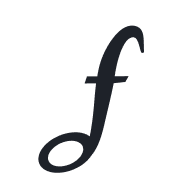
Listens to your playing and waits for you to hit the right notes
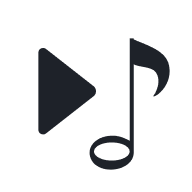
Video & Sheet Music
Watch an expert pianist play and follow sheet music on the same screen

Slow Motion
Play at reduced speed to get comfortable with a piece
Loop Function
Replay a specific section until you perfect it
Select a Hand
Practice right and left hands separately
Play your favorite songs
Learn to play piano with the songs you know and love. Discover beautiful arrangements for all abilities, created by professional pianists.
Step-by-step courses to reach your goals
Easy-to-understand lessons that cover everything from music theory, mastering chords, and how to read sheet music.
Why our users love flowkey
Over 5 million people have enjoyed learning piano with us, from beginners to advanced players.
"It has officially been 1 month since I've started my @flowkey_com journey and I'm so glad I decided to jump into it! I've really enjoyed this program and so far have learned to play a handful of different songs!"
MissWhiteMage
"Absolutely amazing! It hasn't costed any money so far unlike my last app and hasn't had any ads so far.I have learned a lot so far and I just began definitely a five star review from me!"
Karlee_ Vaughn
"Am a retired person who has long been fancying playing piano one day. But seniors could stand no more face to face lessons. Flowkey is by far the most flexible apps that one can work on his own. Particulary I find the arrangements for the songs are much pleasing to my ear, even the simplified songs for beginner level. The songs provided by other apps are very boring, probably they are targeting kids."
"Cannot recommend it enough, just brilliant
This app has no words. Amazing songs, support is amazing, easy to understand and also brilliant courses make this app shine. I have personally tried some other apps as well, but couldn't find one that met all of this. It is true that you do need Premium for the real fun, but even without premium, you could still try out a few songs. There are a few apps where you finish one course, and then you HAVE to get the premium plan, else the app's useless. This meets everything I wanted in learning piano. It helped me learn a whole song that nearly all my friends love. This app is all you need with practice."
Snehaljshah
"Phenomenal app
I’ve only been playing the piano a year. Before using this app it took me months to learn a new song. With this app you will learn songs in a third of the time! Or maybe even less!!! The price is incredibly reasonable given that private instruction can cost up to $60 an hour. I’ve discovered beautiful classical songs on here to play that I would have never encountered before. Whether you want to play an easy pop tune or master an advanced Chopin piece, Flowkey has something for everyone at every level. Flowkey is an essential for all piano students!"
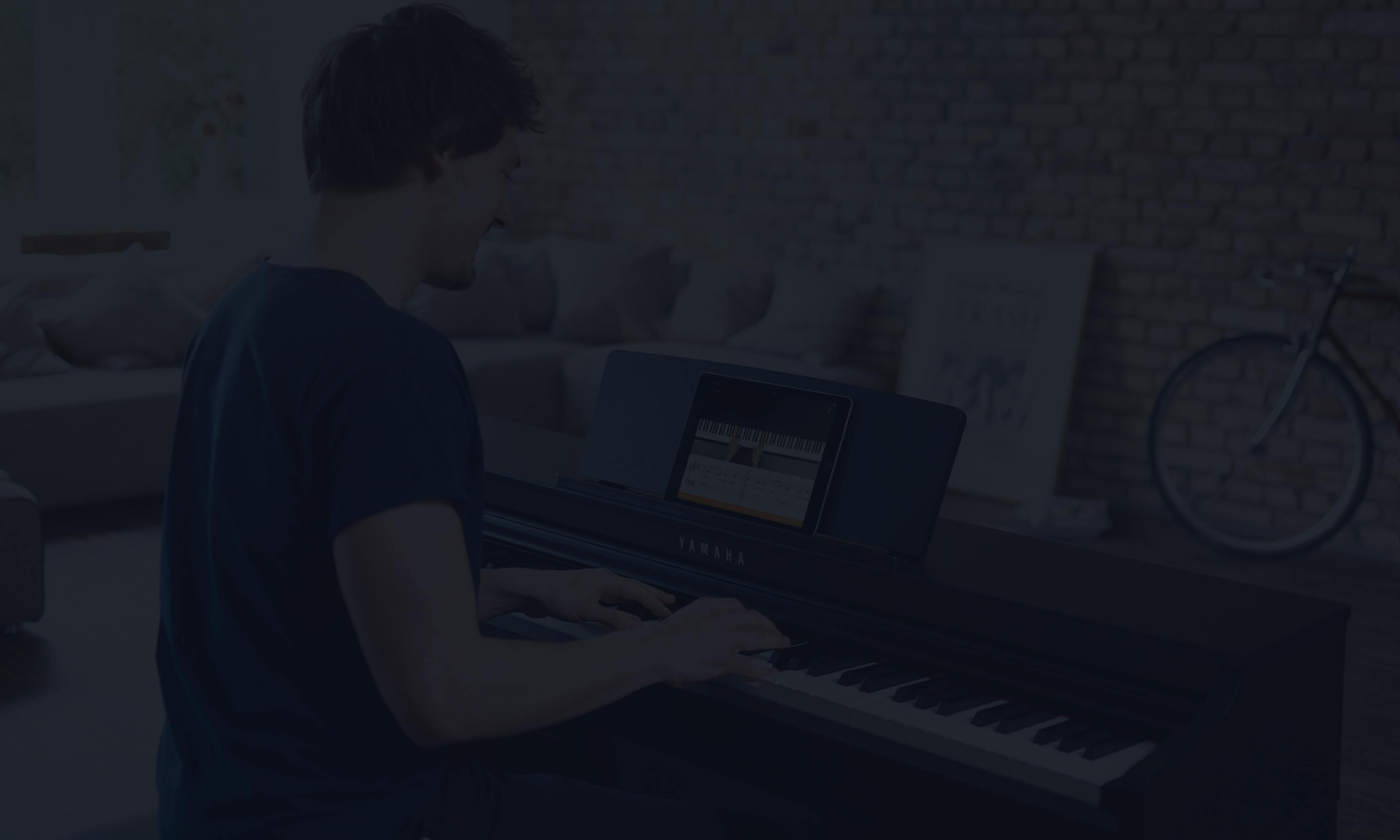
Start for free today
Try flowkey now for free, with no obligations. Get set up in just two minutes and start playing your first songs straight away.

The COMPLETE Guide to Learning the Piano
We may earn an affiliate commission when you buy through links on our site. Learn more .
Now, I’m willing to bet that you’ve stumbled upon this article because you’re interested in the piano, and want to learn, but you’re confused as to where to start. And I understand this, because there are so many different styles of music, so many different philosophies and theories on playing the piano and making music, so many companies that have developed learning materials vying for your business, that it can all feel a bit overwhelming .
This is where I come in. I have a pretty extensive background in a particular style of piano-playing, and as someone who was originally self-taught and then sought formal tuition, I understand all too well the frustrations of trying to learn how to play the piano.
My intention with this article is not to actually teach you how to play the piano. You can’t learn to play just by reading some text. What I want instead is to give you an overview of learning, how to go about finding a teacher , how to teach yourself if you so wish, and certain milestones and steps you can aim for over the course of your piano-learning career. Think of it almost like a cheat sheet while you’re learning, that you can refer back to along the way. I’m also going to give you a basic overview of learning to read sheet music and other music theory concepts.
One thing I’d like to stress at this point is that learning the piano is a very unique exercise. One can draw parallels with lots of other activities. It’s in some way an athletic activity; if you see a concert pianist pour their heart and soul into a piece and finish dripping with sweat you’ll understand what I mean. It’s also an intellectual activity that requires a lot of concentration and brainpower. As a result, it can be incredibly challenging if you approach it the wrong way.
What I’d like to do with this article is to guide you in the right direction along your piano learning journey. And that’s exactly what it is; a journey . You shouldn’t start learning the piano with a specific end-point in mind; for example, you want to get to a particular level or play a particular piece. You should be learning the piano for the sole purpose that you enjoy learning the piano . Of course, everyone has ambitions, pieces they want to play, things they’d like to do with their music. Just don’t pin all your hopes on one thing; this is absolutely a marathon and not a sprint.
With all that said, let’s get into this. Be warned; this is a LONG one!
Section 1: Preparation
Why learn the piano.
I’m going to guess that you’ve already kind of decided that you want to play the piano. But maybe you’re here because you’ve decided that you want to play music, but you’re not sure about which instrument you want to play.
I could sit here and write thousands and thousands of reasons why I like playing the piano, but very few of them are going to resonate with you. What I’d like to do is go through a brief rundown of some of the physical and mental benefits you might experience when learning to play the piano.
It improves your concentration
This doesn’t necessarily occur to some people when they think of learning the piano, but in actuality it makes a lot of sense. When you’re playing the piano, you’re doing several very complicated things , all at the same time.
You’re potentially playing something with your left hand and your right hand at the same time, potentially sight-reading music, using any of the three pedals, as well as constantly listening to and analysing what you’re playing. If you’re playing with someone else, you’re also listening to them and analysing their playing!
What this can do is lead to an increase in your ability to perform multiple tasks at once in other activities, such as at work or at school.
It’s a fantastic outlet
It’s no secret that a record number of people nowadays suffer from depression and anxiety. Now, I’m in no way saying that playing the piano is a cure for clinical depression, and if you think you’re affected by this you should see a doctor. However, if you’ve had a bad day at work, or something has gone wrong in your personal life, you’d be amazed how much sitting down at the piano and playing some of your favourite music can lift your mood.
It’s something that I’ve experienced on numerous occasions and it’s one of the things I enjoy most about playing the piano; the ability to completely lose yourself in working on a piece of music that you love that you temporarily forget what’s been bothering you. It also works if you’re angry or upset; find some angry music and play it as loud as you can. Just make sure your neighbours aren’t home!
The beginning stages are easier than other instruments
I’m not suggesting playing the piano is easy (it most certainly isn’t.) However, the piano is one of the easiest instruments for you to actually generate a sound from. All you have to do is press a key. Now, because it’s fairly easy just to create a sound, composers respond by writing exceptionally difficult music for the instrument, music that in terms of complexity and density would never be matched on any other solo instrument simply because it wouldn’t be possible.
The beginning stages of other instruments are not so easy. With a stringed instrument, you need to learn proper bow technique and wait for the skin on your fingers to harden, otherwise you will be in perpetual pain throughout all your music lessons and practice. With wind and brass instruments, you have to train the muscles around your mouth to position themselves in a certain way, otherwise your instrument will not make a sound. All you have to do on a piano is press a key.
The piano teaches you perseverance and discipline
This is one I truly believe in. There is no pianist that has reached any level of competency without disciplined practice . Pianists must practice frequently and work hard constantly over the course of their learning journey. Coupled with this, you are very likely to experience hardship when playing the piano. You will get stuck on certain things, and you will ask your teacher to explain them and you will not understand.
The key to anything in life that’s worth having is perseverance . In your career, in your relationships and in your playing. Being able to play the piano is, in my opinion, a skill worth having, but you won’t get there without patience, perseverance and discipline. All skills that you will find exceptionally useful in all other areas of your life.
The amount of music you can play is ENDLESS
I really mean this. Whatever type of music you like, or want to learn, it exists for the piano , where it doesn’t necessarily exist for the trombone or euphonium, for example. Piano playing is a rich tradition that has been enjoyed by people for centuries. And even before that, people played harpsichords and organs, so keyboard playing has been around for hundreds and hundreds of years.
Because of this, nearly all types of music are available for the piano . Any pop song within the last seventy years? I guarantee there’s piano sheet music out there somewhere, no matter how obscure the song is. There’s also a significant catalogue of music written exclusively for the piano that stretches back since the late 1700s. Music before then, written for harpsichord or clavichord, can also be played on the piano. So you have a whole tradition of music stretching back to renaissance and medieval times at your fingertips.
It’s not just Western music, either. The piano has also been embraced in Asian countries such as China and Japan, and there is plenty of Asian music transcribed or even written for the piano. It’s even possible to find ancient Chinese music or Indian classical ragas transcribed for the piano. To me this just shows that the piano is the most versatile instrument ever created, and no matter what kind of music you want to learn, you will be able to learn to play it on the piano.
It’s a whole lot of fun
Playing the piano is fun . When you know how to play it properly, and you’re making some of your favourite music, you just can’t beat it. Well, actually, you can; play with your friends! Some of the most enjoyable experiences I’ve ever had have been playing the piano with other people. There’s an incredible amount of great music written for piano duet, or even two pianos.
One of the best experiences I’ve ever had was when I was in a practice room at my local conservatoire with my fiancee, and we were playing through the finale from Scaramouche by Milhaud for two pianos. If you don’t know this piece, you can listen to it here:
You don’t know fun until you’ve experienced the kind of noise two full-size grand pianos make when they’re being played together. If you ever get the chance to play a piano duet, or to play two pianos, absolutely you should do it.
These are just some of the reasons you should consider picking the piano over another instrument. Other instruments will give you these skills too, but for me, it’s the sheer versatility and accessibility of the piano over other instruments that for me, make it the most attractive and worthwhile instrument to learn for a beginner.
Let’s get on to what you need to look out for when you’re buying a piano.
Buying a piano
Buying a piano is a minefield . For every website offering decent advice, there are a million trying to get you to buy something that won’t be suitable for you. I’m going to try to give you some objective advice here to try and help you. There’s a lot of information on my site already about what kind of piano to buy, and I’d encourage you to check out some of my other articles as well as this one. On top of this, there are plenty of industry websites that exist to help you come to the right decision; some of my favourites are listed below, and I'd encourage you to check them out.
Piano Buyer

An excellent site offering guides as to how to buy a piano run by industry expert Larry Fine, known for authoring "The Piano Book."
Piano Street

An industry-leading site that offers free sheet music, recordings as well as a very popular forum.

Another forum site, although this one has been around for over 20 years, making it the longest running piano forum on the internet.
Pianos are expensive. Why buy one?
So, you may be thinking that should you find a teacher, they’ll have a piano ready for you to use. Why bother buying one when you can just use your teacher’s piano?
This might seem a little odd, but I’ve actually come across a few parents and students with this idea, so I wanted to address it here first. Buying a piano or digital piano should be seen as an investment in your musical future, rather than an expense. Admittedly pianos are not cheap, but that is for good reason; they are very complex pieces of kit with lots of moving parts that are expensive to make.
It’s a sad fact that many students take up the piano, don’t practice, and wonder why they aren’t getting anywhere. And how can you practice unless you have your own instrument? Deliberate, frequent practice is the ONLY way you will progress at any musical instrument, especially the piano. You can’t go to a 30 minute piano lesson once per week and expect that you’re going to improve if you don’t touch a piano outside that time.
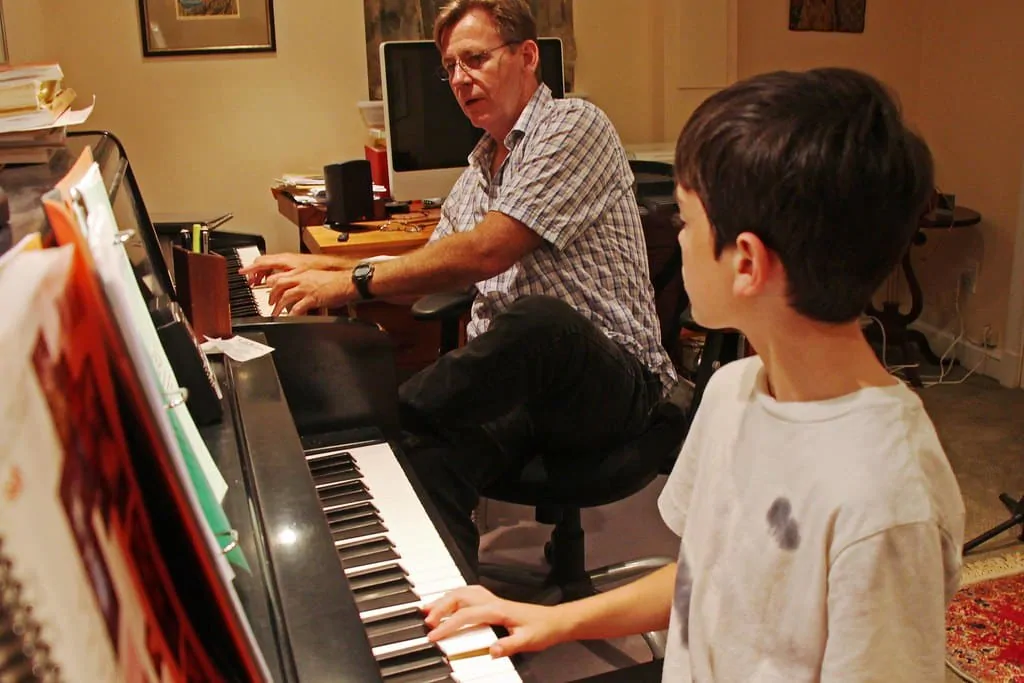
There’s a very limited amount of work your teacher can do during your lessons. Your lesson should be more of a guidance session; your teacher reviews the work you’ve done in the week, helps you in the areas that you’re stuck on and provides guidance on a way forward. Your lessons shouldn’t be practice sessions.
I understand that it’s tough, and that you might struggle to afford a piano at the start. Fortunately, there are plenty of guides online about which piano to buy, including which piano or keyboard is best to buy for those just starting out who aren’t sure they’ll stick at it. I’ve written a few myself: The 5 Best Digital Pianos for Beginners , The Best Piano Keyboard for Beginners and The Best 76 Key Weighted Digital Piano .
I’d encourage you to check these out, because it might put your mind at rest as regards to the financial investment. Unfortunately though, having your own instrument is going to be a necessity if you want to get anywhere with your piano playing, unless you have a neighbour or friend who is happy to allow you to use their instrument to practice on.
Having said this, there are ways for you to get a piano for free. I’ll address this later in this section.
Digital or Acoustic?
Now you’ve decided that you’re going to buy a piano. That’s great; if you get the right one it will give you many years of musical enjoyment. However, the acoustic and digital piano market is extremely saturated, with numerous manufacturers producing very high quality instruments. It can be very difficult to decide what to buy.
I am going to try to steer you in the right direction, but ultimately what you buy is up to you. You’ll need to weigh up the pros and cons of each option and come to the best compromise. Fortunately, whatever you decide, there will be a model of acoustic or digital piano out there to suit your needs.
The age old debate when buying a piano is whether you should buy a digital or acoustic piano. Both have their benefits and drawbacks.
I will say that as an experienced pianist and teacher, the absolute ideal is for everyone to own a good quality acoustic upright or grand piano. There are subtle things an acoustic piano that set them apart from a digital piano. The possibilities for music making are, in my opinion, much more varied and diverse on an acoustic piano. The experience you get is much more authentic and pleasurable. The piano’s sound will change over time, giving you the impression the instrument is aging, living and breathing.
To me a digital piano can be a bit soulless, a bit sterile. Nothing about it ever changes; it never goes out of tune, the sound never develops, it’s always the same. For me this is a major turn off, and whenever I play a digital piano it feels like the music I’m playing is in some way lacking the sense of vitality and life that it otherwise would have had were I playing an acoustic.
Of course, I’m speaking philosophically here, but there is some substance to what I’m saying; I feel a connection with the instrument when I play an acoustic piano; I do not feel this with a digital piano.
You may not care about this, however; you are at the beginning stages of your piano journey, and until you build this connection and rapport with a particular instrument, it may not bother you. I recognise that the ideal is never the reality, and you must pick what’s most appropriate for you at the time. Many people reading this will live in apartments where there just isn’t the space for an acoustic piano.
There is nothing wrong with a digital piano at all, even for the most experienced players. You won’t go far wrong if you pick the right digital, but in my opinion, as a pianist and teacher for many years, a good quality acoustic piano is more expensive. However, I will say that an excellent quality digital piano is probably a better bet than a very poor quality acoustic piano . It’s up to you to make the judgement about what’s most appropriate for your living situation and your needs.
You may think I’m talking rubbish here, but ask any musician; especially violinists. People become attached to their instruments, and were you to replace them with an electronic instrument, it wouldn’t be the same experience.
Why you should buy a digital
I’ve been through why an acoustic is usually a better choice than a digital. However, there are lots of circumstances where digital pianos are more appropriate. Let’s go through some of them.
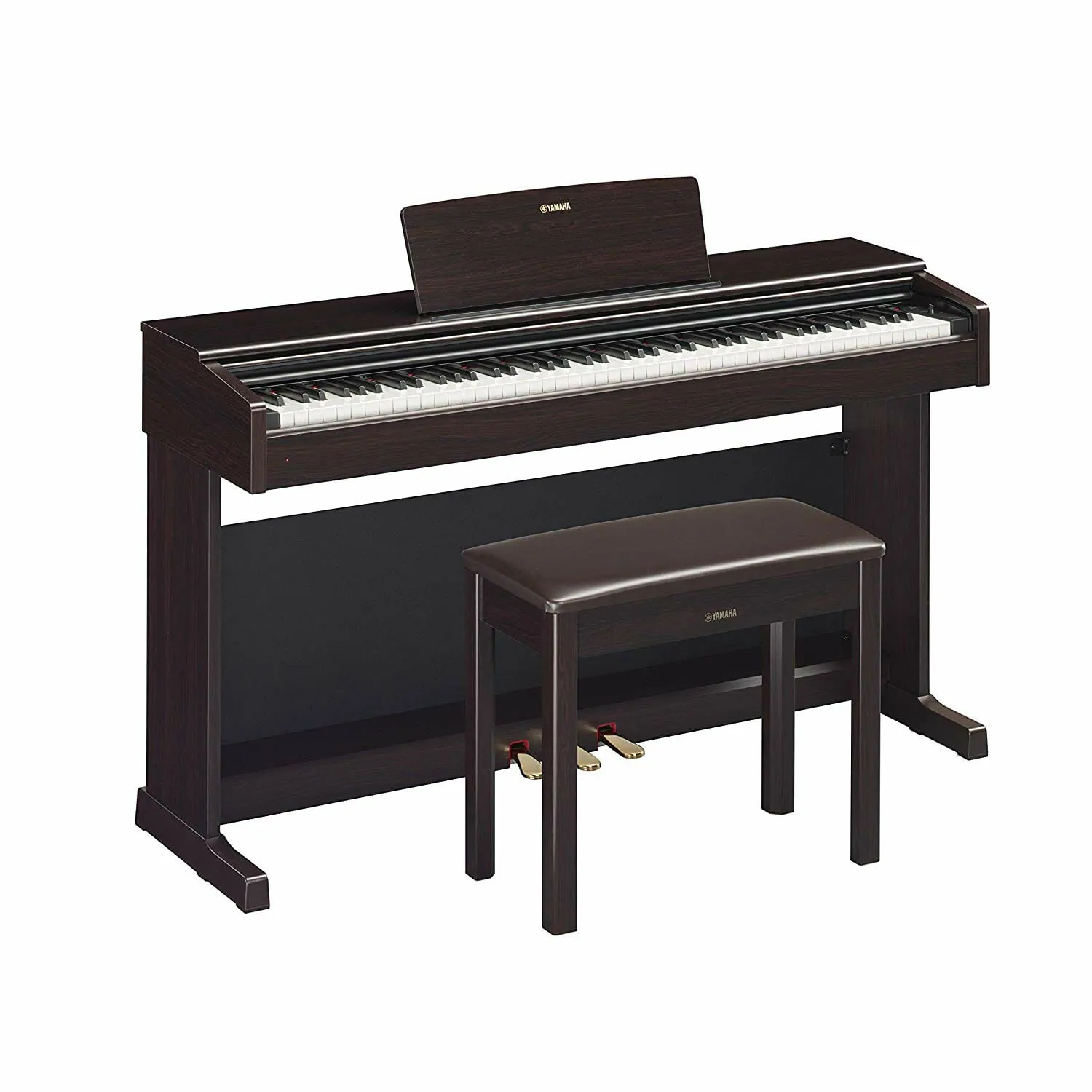
They take up less space
Digital pianos are much smaller than acoustic pianos; they don’t contain all the internal moving parts that acoustic pianos do. This means it’s easier to fit them into tight spaces and small apartments. You don’t even need to buy a console digital piano; if you’re really tight for space, you can buy a keyboard-style digital piano and even put it on a table. For portability and flexibility, a digital piano wins hands down.
They are quieter
Again, if you live in an apartment, or live with other people who are sensitive to noise, a digital piano may be a better bet because you can adjust the volume, and even put headphones on as and when you require. An acoustic piano is at a fixed volume; some instruments come with a practice pedal which mutes the sound, but overall the volume is much louder. If you can only practice at 11pm, you’re much better off going for a digital piano.
They are cheaper
This won’t come as a surprise, because digital pianos are much cheaper to construct and ship than acoustic pianos are. As a result, they’re cheaper. One of the most expensive digital pianos is the Yamaha Avantgrand series, which tops out at around $7,000. This doesn’t come anywhere close to the most expensive acoustic piano you could buy. Of course, for you, the beginner, you’re most likely to be spending around $500 on a new digital piano. Even then, a new acoustic piano that will provide you the same functionality will set you back at least $3,000. If you’re on a budget, a digital piano is almost certainly the way to go.
They’re also cheaper to maintain; a digital piano will never require any tuning or any other work done to it; generally a digital piano is pretty low maintenance and as long as it’s looked after, can go many years without any kind of issue.
They are easier to move
A digital piano is often much much lighter than an acoustic piano. Acoustic pianos are exceptionally heavy, on account of the cast iron frame and numerous components inside made out of wood. A digital piano generally has a particleboard case with everything else made out of plastic. This makes it much easier to move a digital piano. If you want more information about this, take a look at my article on this subject:
How Much Does a Digital Piano Weigh?
They are easier to maintain.
As mentioned, a digital piano won’t ever require tuning, regulation or voicing. The sound is always the same. For me this is a downside, because I like the more organic feel of an acoustic piano, but it means that you will spend less time worrying about whether you need to get your piano tuned or have any other work done to it and (hopefully) more time making music.
Why you should buy an acoustic
I am going to advocate for the good old acoustic piano here, because it’s the right choice for some people. While they have drawbacks in terms of maintenance, there are benefits. Let’s go through some of them.
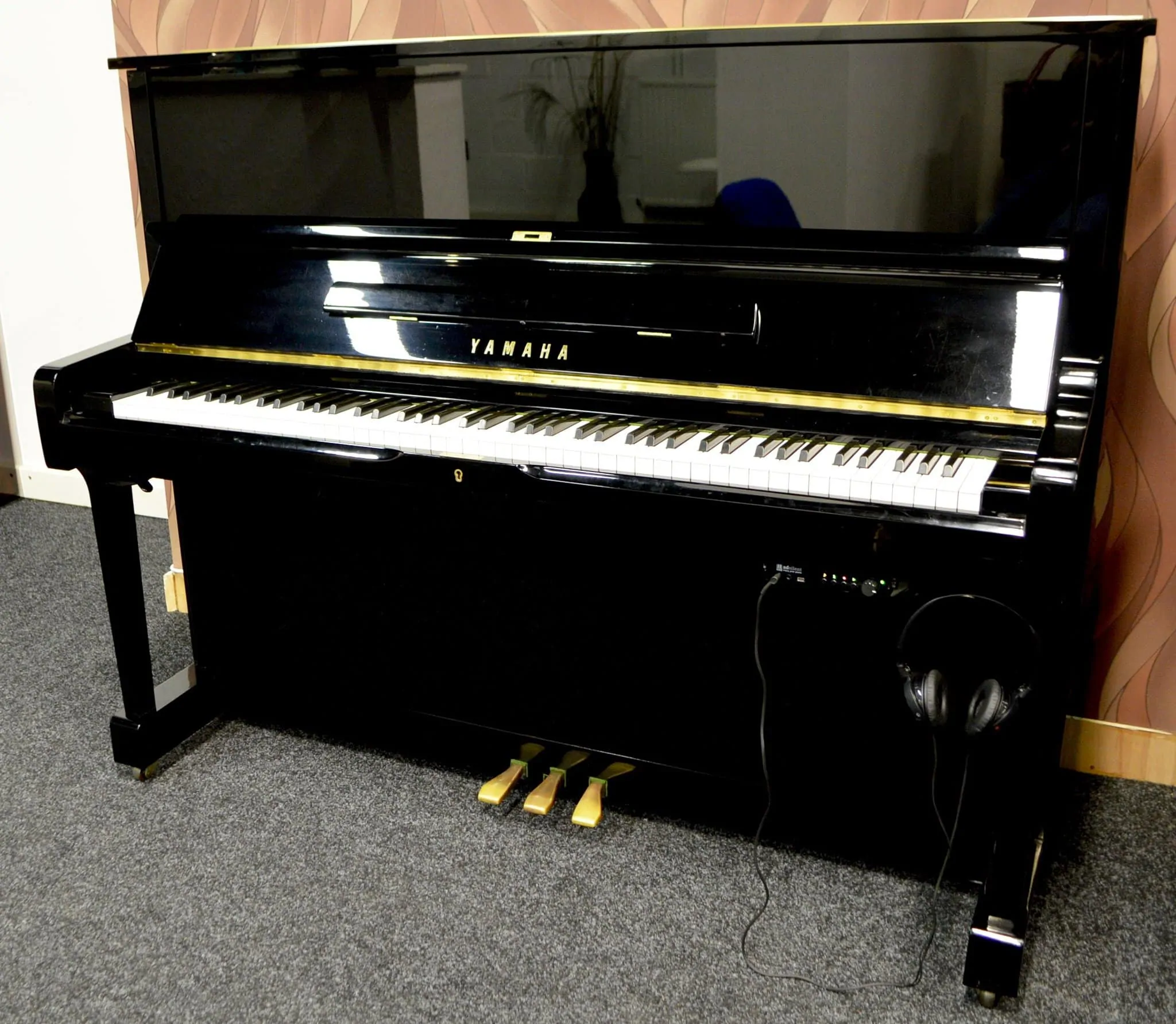
The playing experience is much better
When you press a key on a digital piano, you’re essentially pushing a button, or activating a switch. When you press a key on an acoustic piano, you’re forcing a hammer to hit a string. This kind of playing experience is always much better; you feel like you’re actually making music as opposed to playing back a recording as you would be on a digital piano. This means that your practice is much more pleasurable, and if you enjoy playing your piano, you’re more likely to practice.
Much higher resale value
There’s a limited market for the resale of digital pianos. If you look on Craigslist or eBay, you’ll struggle to find any digital piano model over five years old. There are simply too many models coming out every year for these old models to hold any kind of value; they’re obsolete within a few years, and you can most likely buy a new one for not very much money.
Acoustic pianos are very different. If you buy a well-known brand, it will hold its value very well, to the point where it’s very possible for you to sell it for the same or more money than you paid for it. There’s a booming market for used and reconditioned pianos, and as long as you look after your piano, there’ll be someone willing to take it off your hands for a decent price as and when you decide to sell it.
They last longer
As we’ve mentioned, acoustic pianos hold their value better. They also last a lot longer. Pianos are built generally to have around a 30 to 50 year service life before they require any kind of major rebuilding. However, if you do rebuild a piano, you can expect another 30 to 50 years or more out of it. As long as the piano is maintained well, it will probably outlast you. A digital piano, even though it might well last you 15 - 20 years, is going to be obsolete within five years. Acoustic pianos are built for longevity. Digital pianos aren’t. If you’re in any way ecologically conscious, an acoustic piano is a better bet.
The sound is far, far better
This kind of goes without saying, but as you press a key on an acoustic piano, the hammer strikes the string and you are generating the sound yourself. When you press a key on a digital piano, you play back a recording of an acoustic piano. This can lead to a pretty soulless, lifeless experience, because all you get is the sound of someone else recording a note. You don’t get any of the other resonance or tone you’d get from an acoustic piano. This feeds back into the playing experience; it’s just far superior on any kind of acoustic piano.
You don’t require a power source
This is an interesting one. An acoustic piano doesn’t require any electricity. A digital piano does. So, you may find that if you use your digital piano a lot, you’re consuming quite a lot of power, and the money you would have saved by not having to tune an acoustic piano, you’re spending in electricity bills. I can imagine a cost of $100 - $200 per year to maintain an acoustic piano; if your digital piano uses more than $100 worth of power in a year, the actual cost of maintenance may well be comparable to an acoustic piano.
Coupled with this, your digital piano always needs to be next to a power outlet, whereas your acoustic piano can go anywhere.
How to find a piano for free
Did you know it’s actually possible to find a piano for free? Believe it or not, there are people willing to give pianos away for no money at all. Usually, people who’ve had pianos in their house for many years may want to get rid of them for various reasons. Maybe it was a family heirloom, maybe the person who plays has passed away, who knows. There was once a time where nearly every family in America would have had a piano in their home. Many of these pianos still exist, and lots of people want to get rid of them.
You can find these pianos on Craigslist, or on specialised websites designed for the purpose of piano recycling. Usually these instruments are old, out of tune and potentially broken. However, if you’re on a real tight budget, they could be a good alternative until you can save up for something better. You will, however, have to arrange for the piano to be transported by yourself, and this might get expensive. Just don’t do what these guys are doing:
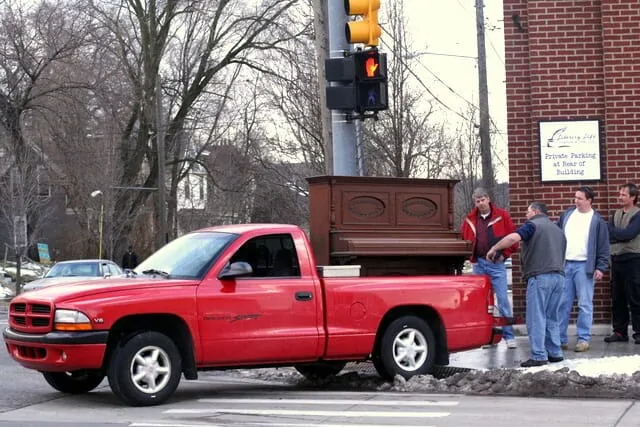
I’ve used this image before a few times on this site, but it’s because it’s an absolutely perfect example of the worst thing you could do when trying to move a piano.
Finding a teacher
So, you’ve bought your piano, and now you need to find a teacher. It’s possible to learn piano without a teacher , which I’ll come onto later, but for now I’m going to assume that you’d prefer to find a teacher and take formal lessons.
Unfortunately finding a competent teacher can be difficult. Most if not all piano teachers have worked with beginning students, but there are a select few that specialise in teaching beginners and know exactly how to get the best out of beginner piano students.
First; scope out your local area
Get hold of the local Yellow Pages and get a list of piano teachers in the local area. If you can’t find any, check out online directories, see who’s running ads or showing up in the search results when you type “piano teacher + your area” into Google. Prepare a list of potential candidates that are a reasonable distance from your house. Chances are most major cities have several piano teachers, especially so if they have a university or conservatoire; university students will graduate and settle in the city, and begin teaching the piano, so it shouldn’t be too hard for you to find someone.
Of course, you should initially find out what kind of music they teach; classical, jazz, pop, etc? Some teachers will do everything, but most will specialise in one particular area. If there’s a specific area you’re interested in, then you should add this to your search and narrow down teachers that specialise in this genre.
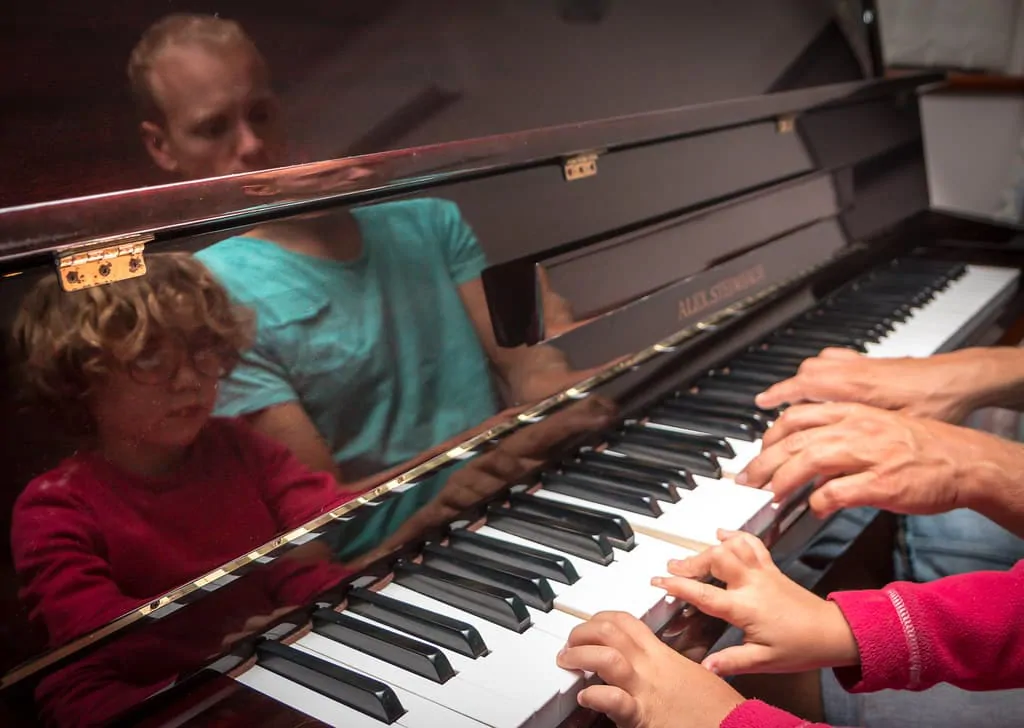
What you should also consider is teachers that offer online tutoring. There are guys like Josh Wright who teach over Skype, as well as numerous services you can sign up to and get a teacher who will teach you remotely. If you’re comfortable with this, then great; you don’t have to leave your home to take piano lessons. Just be sure that you have all the technology required; a good camera, a microphone and a stable internet connection.
Vetting your list of piano teachers
After you’ve narrowed down a list of teachers that you’d be willing to travel to/take lessons from online, it’s time to go about eliminating some of them. What I’d recommend is that you talk to them on the phone, send an email or even meet them in person to ask them some questions.
- Establish their teaching background. Have they been teaching for many years, or have only started within the last six months?
- How much experience do they have actually playing the piano? Have they given recitals, played in a band, etc?
- What kind of credentials do they have? Do they have a teaching diploma, or a university degree in music, or are they just someone who’s played the piano for a long time and have decided to teach?
- Do the lessons take place at their home or will they come to you?
- What is their specialism? Do they specialise in classical, jazz, rock, etc? Do they specialise in teaching beginners or adults?
- Do they subscribe to a particular method? This could be something like the Suzuki method, or do they have their own ways?
You’ll learn a lot about how your lessons will go just from meeting and talking to your teacher. Are they someone you see yourself getting on with and enjoying taking lessons from week after week?
Trial Lesson
Once you’ve decided on your teacher, it’s time for a trial . Often teachers will offer this for free, so if you’ve narrowed this down to the last three or four teachers, you should take a trial with all of them. Assess the teacher’s demeanour ; whether they are p olite and respectful (some teachers aren’t), whether they show interest and positivity , whether they have charisma, leadership and likeability. It’s important that all these traits are there before you commit long term. A good teacher will also demand excellence ; make sure that this is evident, otherwise you will not get the best from your lessons.
After you’ve done some trials, choose your teacher. This is a long process to go through, but it’s absolutely worth it; if you don’t get on with your teacher, it’s highly unlikely that you’ll commit to music-making long term. Taking the time to find the right teacher can be the difference between quitting the piano early, and enjoying a lifetime of music making.
Learning on your own?
Despite what many say, it’s entirely possible to teach yourself piano. I do believe that having a teacher is the best way to go, but I appreciate there are some circumstances where this isn’t really possible. For example, teachers can be expensive . It may not be possible for you to get to a teacher on a regular basis, or maybe the only teacher in your area doesn’t have any space in their schedule to accommodate a new student.
The best way to do this is to have some sort of online content to guide you. You can sit down at your piano and trawl YouTube and blogs like this one for some inspiration as to what to learn, but something more structured will save you time and arguably give you better results.
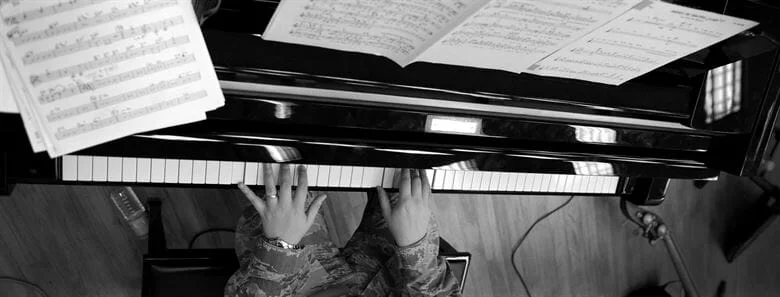
Apps like Flowkey , Simply Piano and Yousician provide a semi-structured learning experience that’s more budget-friendly than finding a teacher. However, these methods usually have no clear lesson plan, and have so much content that it can be difficult to know where to start. What’s more, there’s nobody to correct your mistakes when you go wrong.
However, if you can live with these downsides, the flexibility that self-learning affords you may work well if you have a busy lifestyle and can’t commit to a weekly lesson, or if you are put off by the high price of piano lessons.
Reading music; to learn or not to learn?
This is a contentious one, but I’m going to give my honest opinion. Many people say that reading music is pointless, and it’s entirely possible to play the piano without having to read music. Let’s go through some of the more pressing issues in more detail.
Often there’s a lot of fear around note-reading. People want to learn how to make music, but then they realise they might have to learn how to read music, which is potentially akin to learning to understand another language. This can put a lot of people off, and understandably so.
Despite this, I believe that learning the piano without knowing how to read music is actually much, much harder in the long term. If you don’t learn how to read music, you are totally reliant on your musical ear in order to learn how to play. If you’ve never had any kind of training at this, this is going to be very, very difficult.
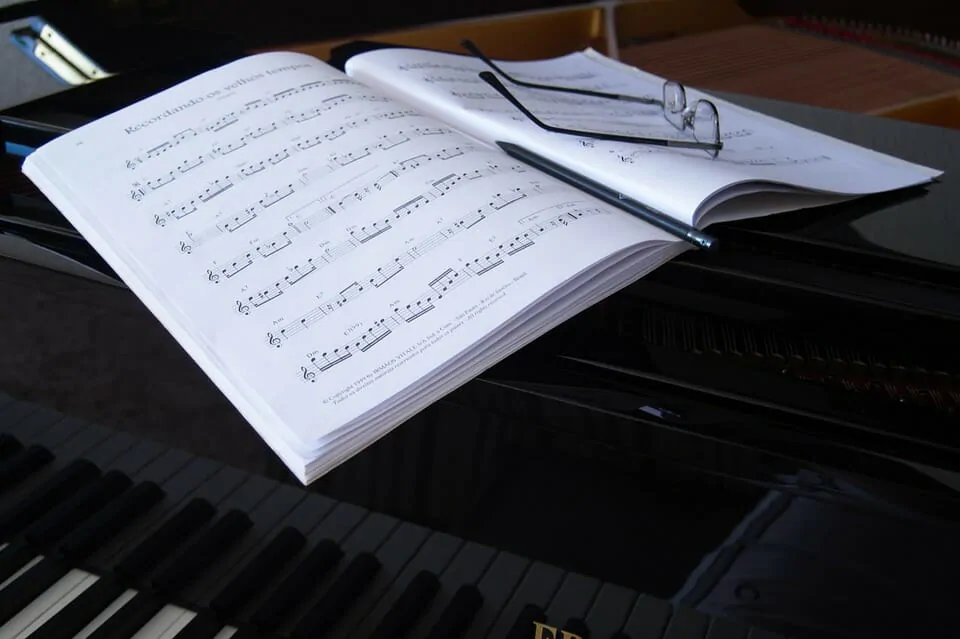
In the short term, of course, you can ask your teacher to show you which notes to play to play a piece, but this is so laborious and time-consuming that in my view, it’s not worth it. You can work on your musical ear, to the point where you can hear a piece and be able to play it to some extent, but it takes an extremely gifted musician to be able to hear a piece of music and play it back. Unfortunately, the vast majority of us don’t have this gift.
Learning to read music is a challenge , but the liberation and independence it gives you is absolutely worth it. Imagine wanting to learn a new piece, and you don’t have to rely on anybody else; all you do is buy the sheet music and learn it yourself. This is what is ultimately going to give you a life-long experience of playing the piano. If you’re relying on the internet or on your teacher to teach you a new piece, your musical growth and independence will be stunted .
So, to sum up; I recommend you bite the bullet and learn how to read. It’s not as hard as it seems, and the sense of independence you get from it is always far better than struggling to listen to a bad recording and trying to copy it. Remember; learning the piano is a marathon and not a sprint, and this also applies to sheet music learning. As mentioned previously, the right teacher will massively help here.
My specialisms, and what my learning plan will focus on
As you’ll know from some of the other things I’ve written about, and from my biography, I’m primarily a classical pianist. I play a little jazz on the side, but the vast majority of the music I play is classical. As a result, this lesson plan is going to focus on primarily learning to play classical music.
However, because I’m only covering the basics here, this material is of benefit to anyone, irrespective of the type of music you want to play. I’d recommend reading through this first, because it will give you a good grounding in playing the piano. You can then graduate to whatever you want to play, and this material will serve you well. Just bear in mind that there’s going to be a little bit of a classical bias simply because it’s what I play and teach.
Let’s get going!
Section 2: The Learning Plan
Semester 1: the absolute basics, sitting at the piano.
In this semester we are going to cover the absolute basics of piano playing. It may be a while before you even play a note, but it’s important that we get certain things locked down before progressing any further.
The most important thing to do when starting off is to ensure you are sat at the piano correctly, with good posture . This is the foundation of all good piano playing.
Position your stool in the middle of the keyboard. If your piano has a decal for the manufacturer’s name in the middle, position your stool so that when you look straight ahead, you are looking at the manufacturer’s name.
You should be sitting far away enough that you have room to move, but not so far away that you have to stretch or lean forward to reach the keys. Position yourself that you can comfortably put your hands on the keys with your elbows bent at a roughly 20 degree angle inwards. You don’t want to have your elbows locked straight, but at the same time you don’t want to have to have your elbows too wide; this would indicate you’re too close.
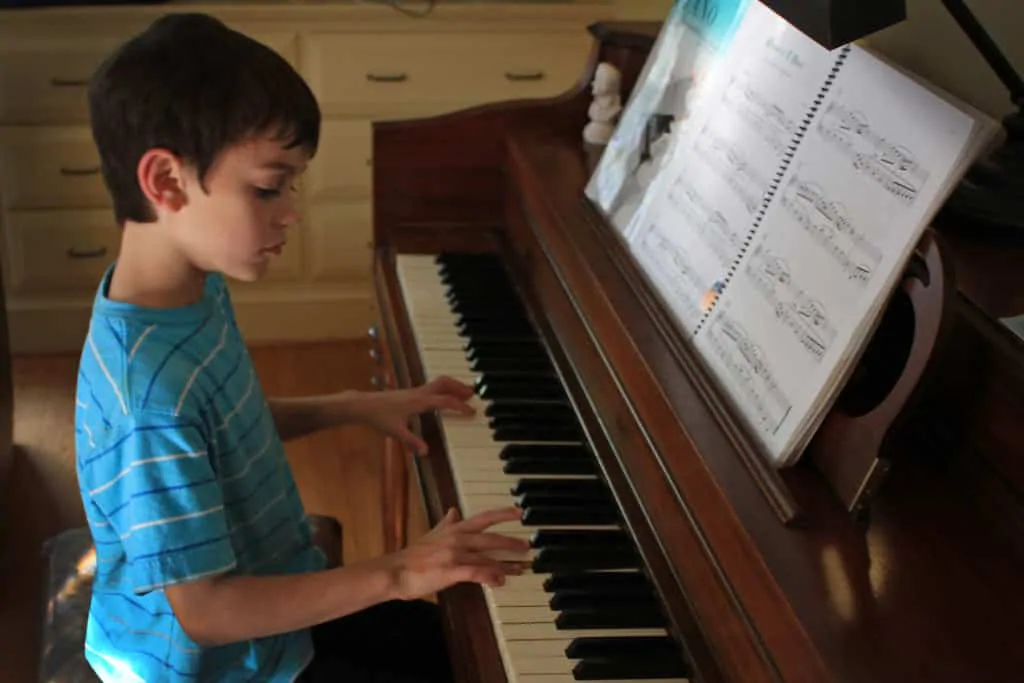
Adjust the height of the stool so that you can comfortably reach the pedals. If you have to stretch your legs to reach the pedals, you are either sitting too high, or your legs are too short. This is the reason many children require a footstool . You shouldn’t require one as an adult, so if you can’t reach the pedals you’re sat too high.
Make sure your forearms are level with the keyboard. Your elbows should be the same height as the keys. If they are higher than the keys, you are sat too high and need to lower your stool. If they are lower than the keys, you are sat too low, and need to raise your stool.
If your stool or chair isn’t adjustable, you’ll either need to find another chair if you’re sat too high, or find a cushion or some books to sit on if you are too low until you can get another one.
Your posture should be relaxed . Don’t sit bolt upright, because this will give you back pain. Slouching will also give you back pain. If you have trouble keeping your back straight, you should consider using a chair rather than a stool until you can get used to sitting upright. This is one of the major causes of injury and strain among pianists and it’s important that you get into good habits now to avoid back problems in the future. If you have to slouch or lean forward to reach the keys, you are sat too high.
Take a few moments to practice your posture and seating position before you start practising every day. You will eventually get used to it and it will become second nature to you, but for now it’s important to consciously practice and solidify these good habits.
Finding Middle C
The first note that we’re going to learn is Middle C.
The easiest way to find Middle C is to use the location of the black keys. Look at the way they’re oriented; you have a group of two black keys , and then a group of three black keys . This continues all the way up the keyboard.
I want you to think of this as a group of 5 black keys. 2 keys + 3 keys = 5 keys. The group always resets after 5 keys, with the first of the group of 2.
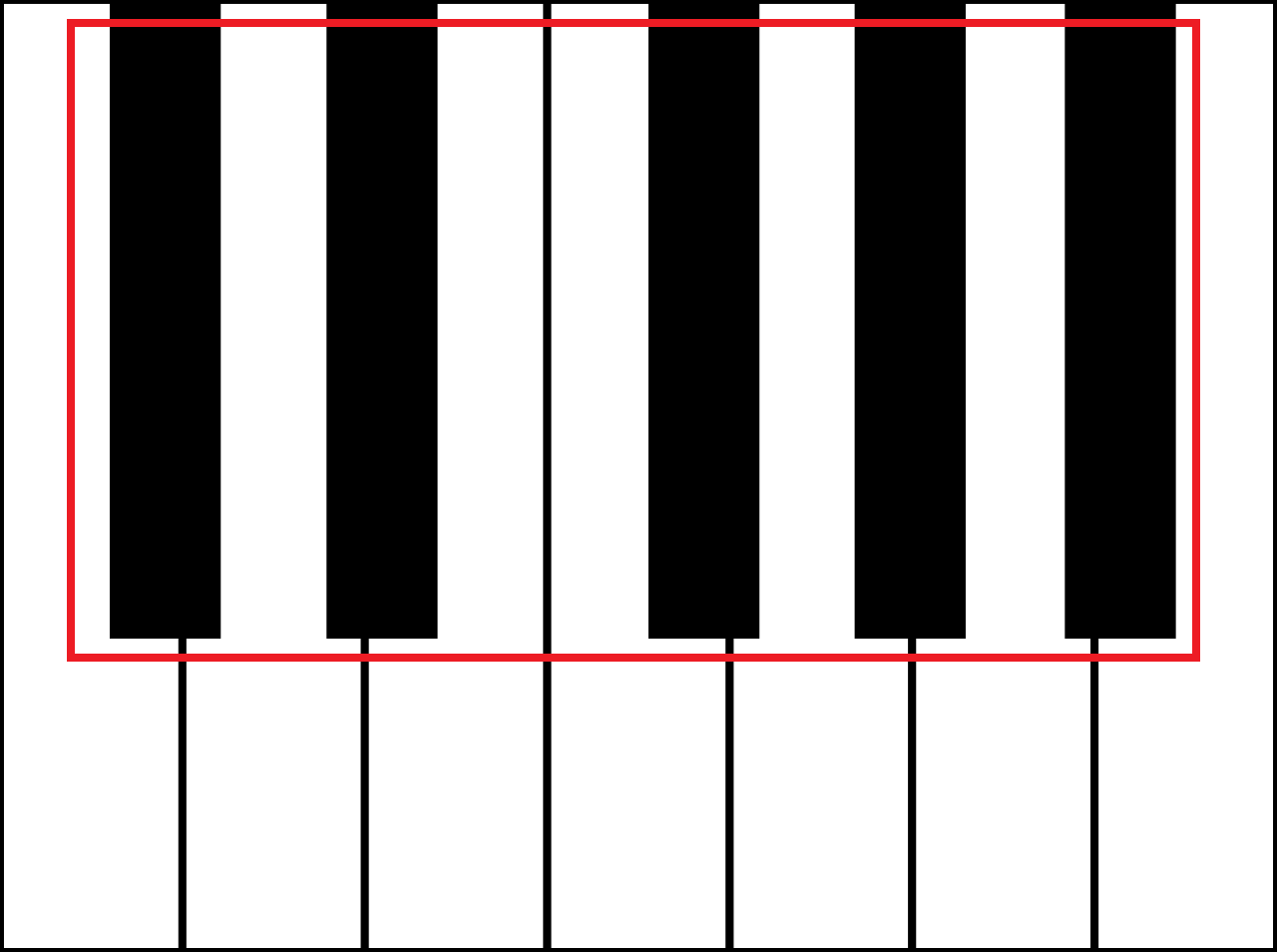
Find the leftmost key of the group of 2 black keys. Now, the white note immediately to the left of this key is C. It doesn’t matter which group of two you pick on the piano; the note immediately to the left of the leftmost black key in the group of 2 black keys is always C.
Now, all you have to do is find the group closest to the middle of the keyboard. The note immediately to the left of the group of 2 black keys is “middle C.”
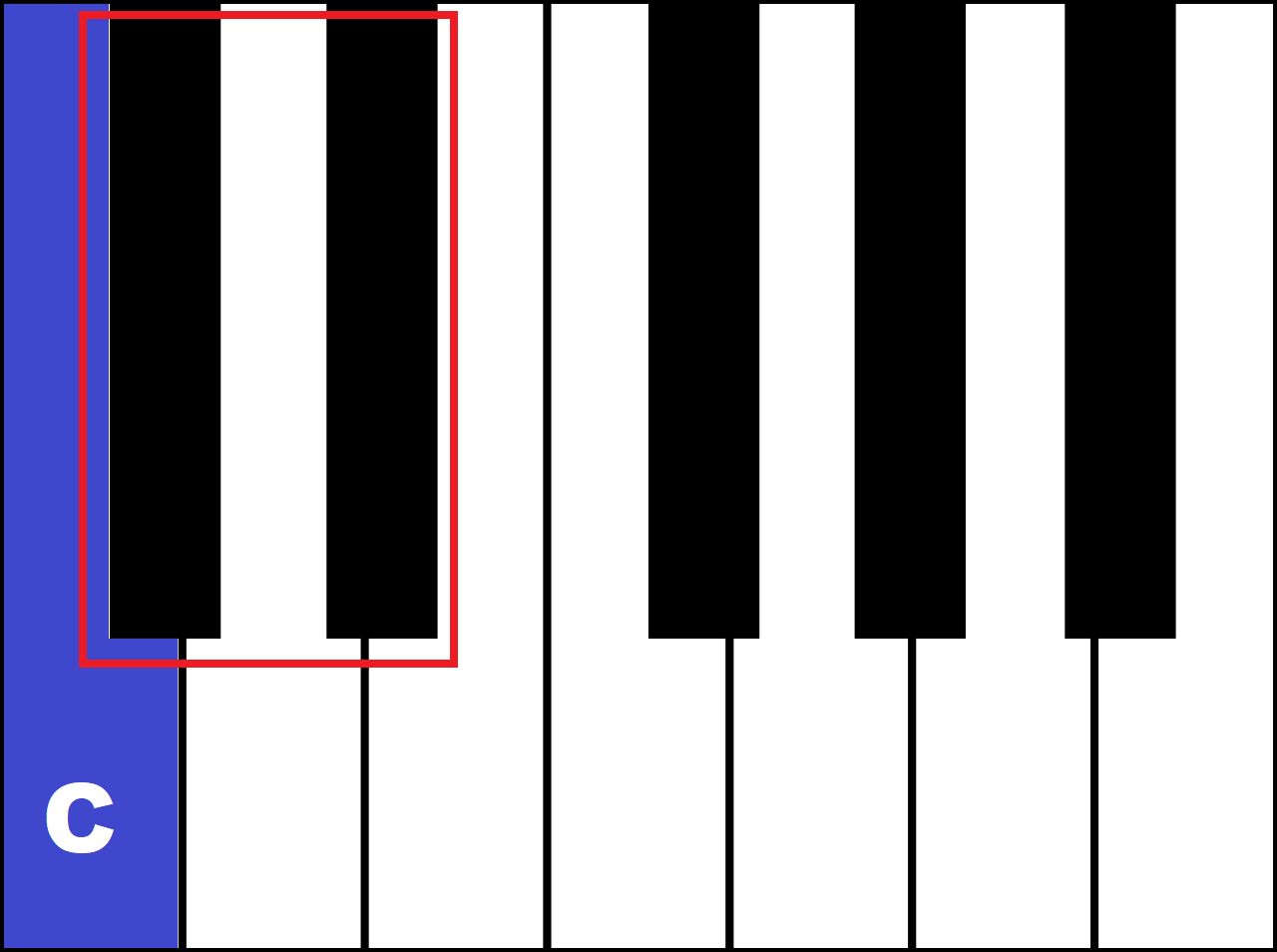
It should sound exactly like this:
If you’re having trouble, follow the instructions above and try to match the sound. If it sounds lower or higher, you’re in the wrong place. Only when it sounds exactly the same do you have middle C.
Middle C will be your anchor point. While you’re in the first few weeks of lessons it’s the place you’ll always find as soon as you sit down at the piano. Practice finding middle C a few times a day. Before you know it, you’ll be able to find it without even looking for it.
Now that you’ve mastered sitting at the piano and finding middle C, it’s time to learn the other notes.
The layout of the keyboard
We touched on this before, but I’m going to go through this in detail just so you know how the keyboard is laid out. It’s really important that you learn this; when you do, you’ll be able to find any note on the piano without having to think about it.
The piano is laid out in groups of notes, called octaves. A full size piano consists of 7 ½ octaves. Each octave contains seven white notes , and five black notes.
When we get to the highest note of the octave, the next note is just a repeat of the lowest note of the octave; just higher. This is why people refer to something as being “an octave higher” or “an octave lower.” What they’re referring to is the same note, just one repetition of the pattern up or down the keyboard..
This repeating pattern continues up the keyboard until we run out of notes.
Challenge: You already know middle C. Find it on the keyboard. Knowing what you know about the layout of the keyboard now, try to find all the Cs on the piano. You can hover your mouse over the diagram below when you think you’ve got it to check whether you’re right!
Click to reveal the answer!

Half steps, whole steps, sharps and flats
Let’s get onto why these notes are laid out the way they are. When we understand this, we can go onto their names. It’s important you understand why the notes are named what they are before you start learning them; it will be much easier to ingrain them in your memory, and even to work out the note names if you’ve forgotten them.
In order for you to do this, you need to understand the concept of half-steps and whole-steps . These are also sometimes called semitones and tones .
In music, there are 12 notes. Don’t worry about where they are on the piano just yet.
The notes are C, C#, D, D#, E, F, F#, G, G#, A, A# and B.
“#” means sharp. There also exists “b,” or flat. All this means is that sharp or flat is the smaller distance between two notes, or the “half-step.” It takes the name of the lower note if it’s a sharp , to indicate that it’s the lower note but raised a half-step , and takes the name of the higher note if it’s a flat , to indicate that it’s the higher note but lowered a half-step.
This is confusing, but it will be second nature once you learn it properly.
For example, C to D is a whole step . A whole step consists of two half steps . The note in the middle is called either C-sharp, written “C#, ” or D-flat, written “Db ” . They are the same note, and they sound the same.
All you need to understand here is that “sharp” means plus one half step, and “flat” means minus one half step. D-flat is the note of D, minus a half step. If you were to minus a further half step from D-flat, you would get C.
The exceptions to this are E to F, and B to C . These are half-steps and not whole steps. E-sharp does not exist; E-sharp would just be F , because it would be E raised a half-step . The same is true for B to C; There is no B-sharp; B-sharp would just be C, and C-flat would just be B.
I know this is hard, but stick with me. You won’t learn this overnight because it’s a complicated subject. I’d suggest you spend a few days or even weeks going through this information and practising some of the challenges below until you understand it.
Have a look at the following diagram, which tells you the half-step and whole-step relations between each note.
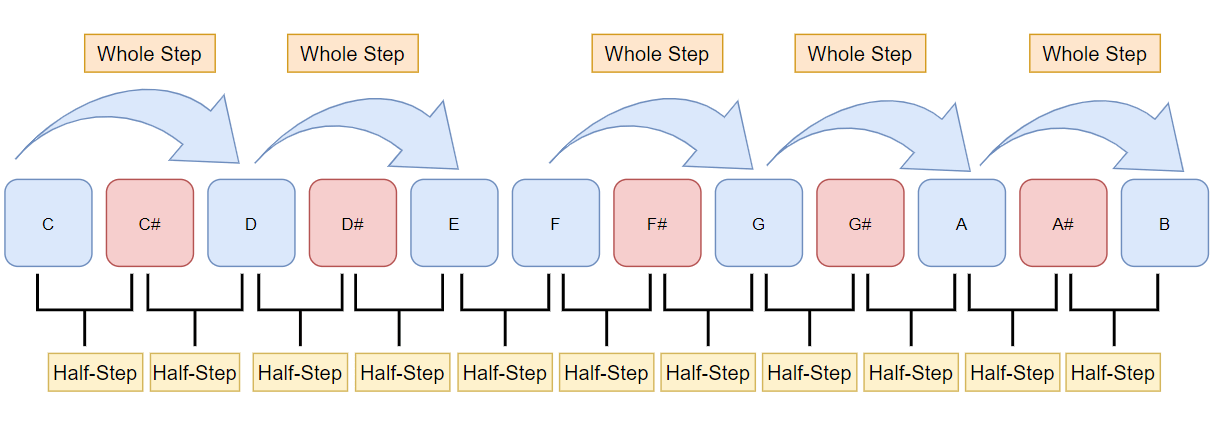
Challenge: Using the diagram above that shows you all the notes, find out the alternative names of the notes below . We’re looking for the same note, but a different name.
- C-sharp-sharp
Learning the notes of the white keys
If you understand the previous section, this next one will be easy. All we do now is take the notes we’ve learnt in the previous section, and apply them to the keyboard. Let’s look at the white keys only in this section, and we’ll move on to the black keys in the next section. However, if you’re paying attention, you might be able to figure out the black keys already after reading this section. If you can, well done; it means you really understand what’s going on.
Let’s revisit the notes we learnt in the last section.
C, C#, D, D#, E, F, F#, G, G#, A, A# and B
I’ve used the sharp names, but you’ll now know that D-sharp is also E-flat, A-sharp is also B-flat and so on.
The white keys contain seven of the twelve notes. They are the “unmodified” notes; i.e., the notes without sharp or flat names . Pretty easy, right?
C, D, E, F, G, A and B.
Here’s a diagram as to where they are on the piano.
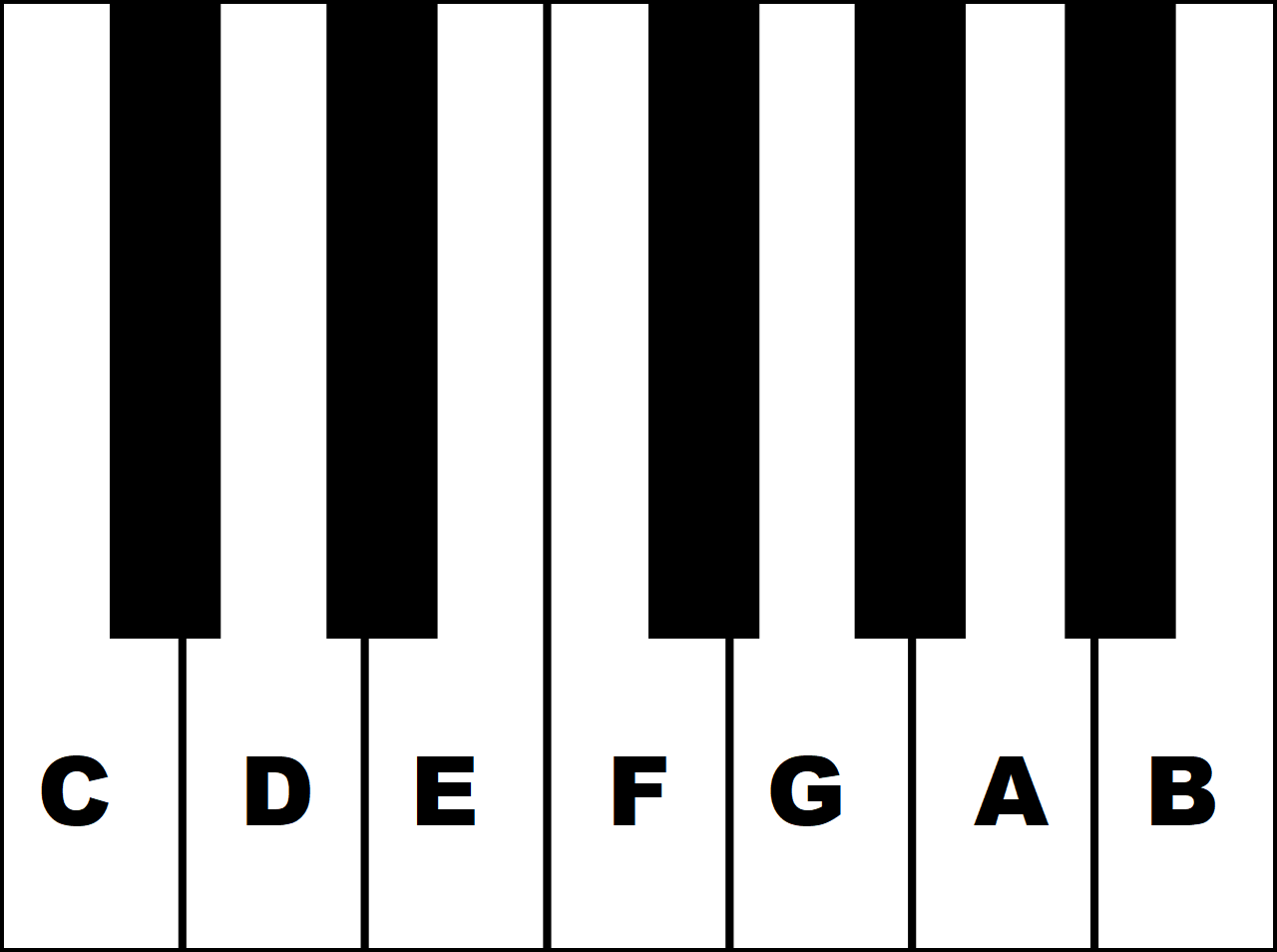
Resist the urge to write the note names down on the keys . You need to learn these note names off by heart. Revisit this diagram as often as you like; download it and print it off and keep it next to your piano if you must. Just don’t write the note names on the keys, because it doesn’t teach you anything. You need to be able to find the notes without having to look at their names.
Learning the notes of the black keys
You may have already figured this out, but we will go through in detail.
The white keys are the “unmodified” notes without sharps or flats. The black keys are the “modified” notes, WITH sharps and flats.
C#, D#, F#, G# and A#.
They can also be called:
Db (remember, “b” means “flat”), Eb, Gb, Ab and Bb.
These two lists are the exact same group of notes , just called by their different names.
Here’s a diagram as to where they are on the piano. I’ve used both note names because you will need to know both.
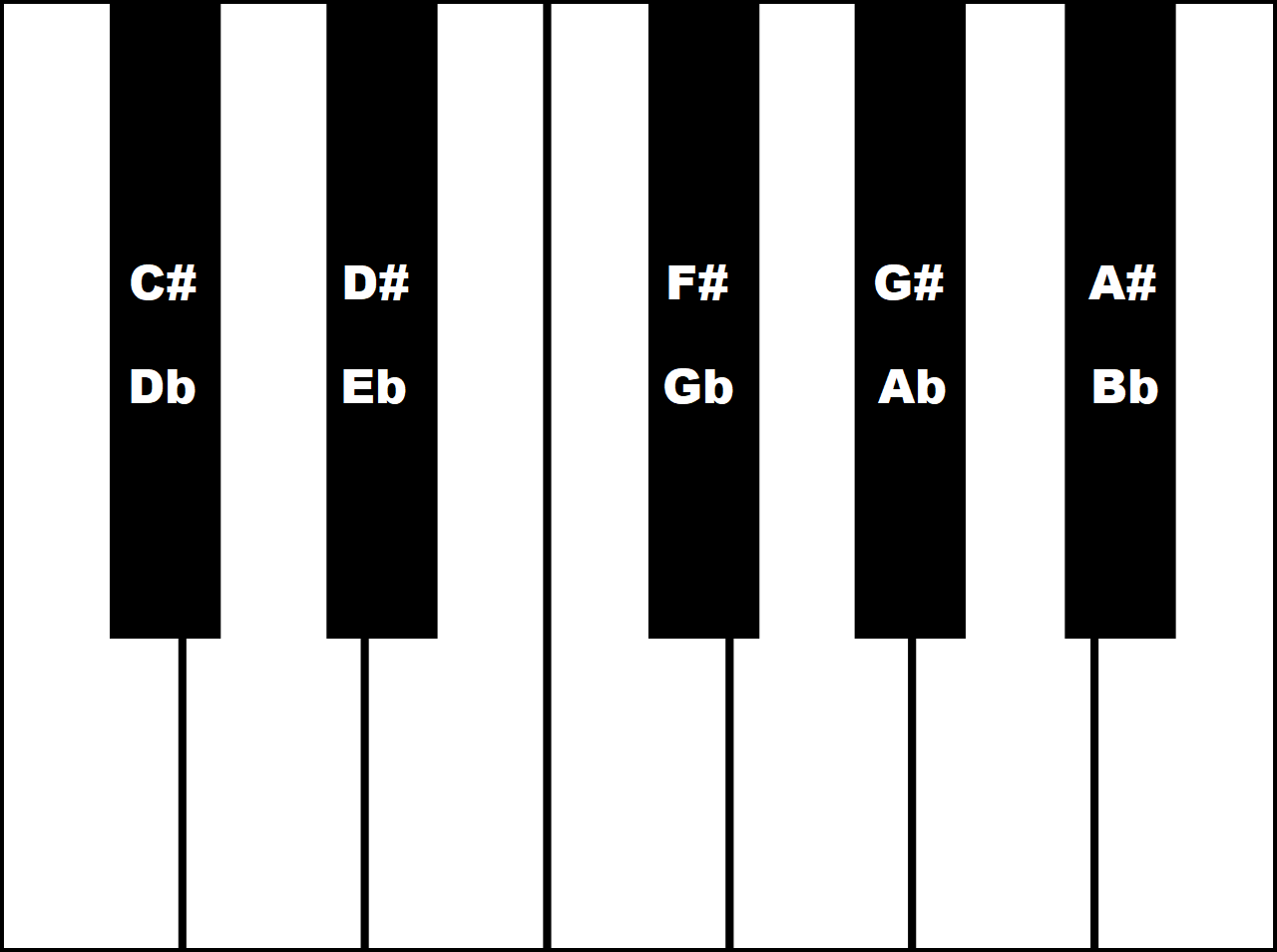
Again, use the diagram I’ve included below in your practice; print it off and refer to it when you need to. Please don’t write the note names on your keyboard; this won’t help you learn the notes long-term, and it’s really important that you know the note names off by heart.
Semester 2: Moving on from C-major
Numbering the fingers.
Before we move into this section, I want to give a brief lesson on numbering the fingers. You’ll read a lot about this later on when we start talking about scales and arpeggios.
Each hand has numbered fingers, and when you work out fingering, the numbers will tell you which fingers to put on which notes.
The fingering is the same for both right and left hands. Thumb is always 1, index is 2, middle finger is 3, ring finger is 4 and little finger is 5. This is the same for both hands.
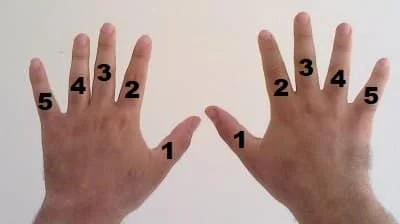
Keep this in mind as we go through this section and the following sections.
Learning basic scales and keys
So, now we have learned the notes, let’s talk about scales . You might look at this and struggle to see the point, but there’s a huge advantage given to pianists who have learned to play scales. They make actually playing pieces so much easier. Everyone should practice scales, or at least know how to play them.
A scale in music is just an organised sequence of notes. For example:
C, D, E, F, G, A, B, C and so on.
If you play these notes (you should be able to find them by now) you’ll notice they make up the following pattern:
Whole step, whole step, half-step, whole step, whole step, whole step, half-step.
This is called a major scale . This also teaches you about keys in music. Whatever note you begin this pattern on, as long as you follow the guide above, you will have played a major scale in that key. For example; let’s examine the C major scale.
These scales are tremendously useful because if you are playing a piece in a particular key, most of the notes will be made up of that scale. If you play a piece in C major, most of the notes in the piece will be made up of the C major scale. This can make things very easy for you if you understand the relationship between the notes, and the fingering, which we’ll come onto later.
For example; let’s work out some more scales.
Let’s take G major. Following this pattern:
Let’s try to figure out the scale of G major.
And now D major.
See? It’s pretty easy once you get the hang of it.
There are other types of scale, including natural minor, harmonic minor, pentatonic, chromatic, etc, which we won't go into here. However, the fundamental nature of any musical scale is that it’s made up of a combination of whole-steps and half-steps.
Challenge: Now that you know how a major scale works, try and figure out the scales for the following keys.
- B-flat major
- E-flat major
B-flat Major
E-flat Major
Scale fingering
I won’t go into scale fingering for each individual scale here, because each scale has its own individual fingering. There are books you can buy that will show you every scale and the best fingering to use.
However, we’ll go through the basic fingerings for C major in the right hand.
The trickiest part when playing scales is that you have 8 notes to play, but only 5 fingers. This means you have to do what’s called a “thumb-under” manoeuvre, to make sure your hands are positioned in the correct way. Follow the diagram below to see the fingering for C major in the right hand.
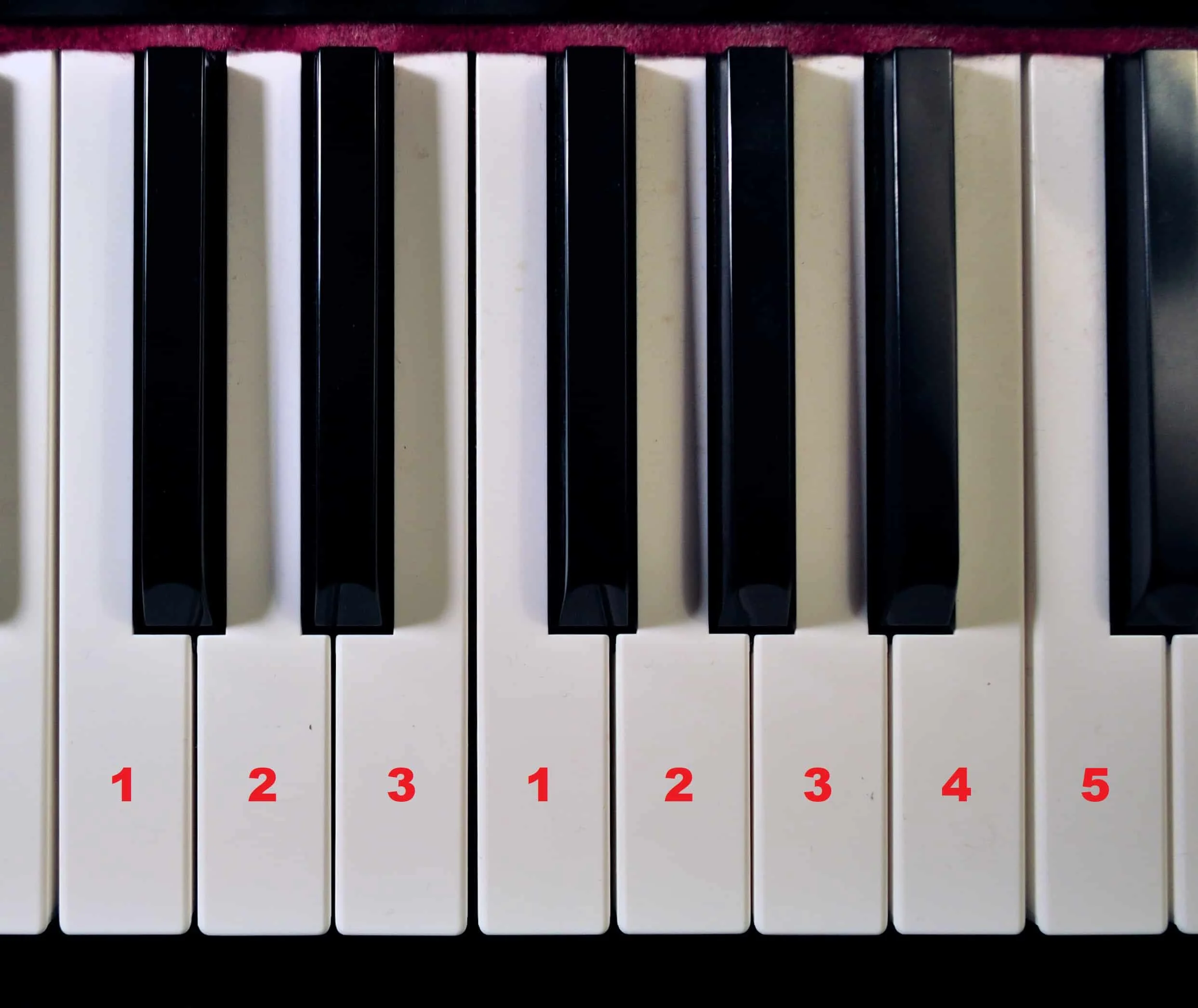
Notice that you have fingers 1, 2 and 3, and then to play the F, you need to go back to finger 1. You need to do this without letting go of finger 3 on the note E. You may think this is very difficult, but what you need to do is use finger 3 as a pivot. Rotate your wrist to the right, and tuck your thumb underneath your other fingers until it reaches the F. At this point you can let go of the E.
Sound confusing? Have a look at this video which shows you a little more clearly how to do things.
The left hand fingering is exactly the same, but backwards. Tuck your thumb under on the way down, and bring finger 3 over on the way back up.
Once you’ve mastered this concept, you can go onto trying to learn G major in the right hand. The fingering is below. Try figuring it out on your own first. (Hint; it’s exactly the same as C major!)
Playing basic piano chords
Up until now, we’ve only covered playing one note at a time. But there’s a full 88 notes on a piano. How about we try playing some notes together?
What I’m talking about are chords. Groups of notes that are played at the same time. They’re closely linked with scales, because chords in a particular key use some of the same notes as scales in that key. Let me explain.
Basic chords in the key of C major include: C major, F major, G major and A minor.
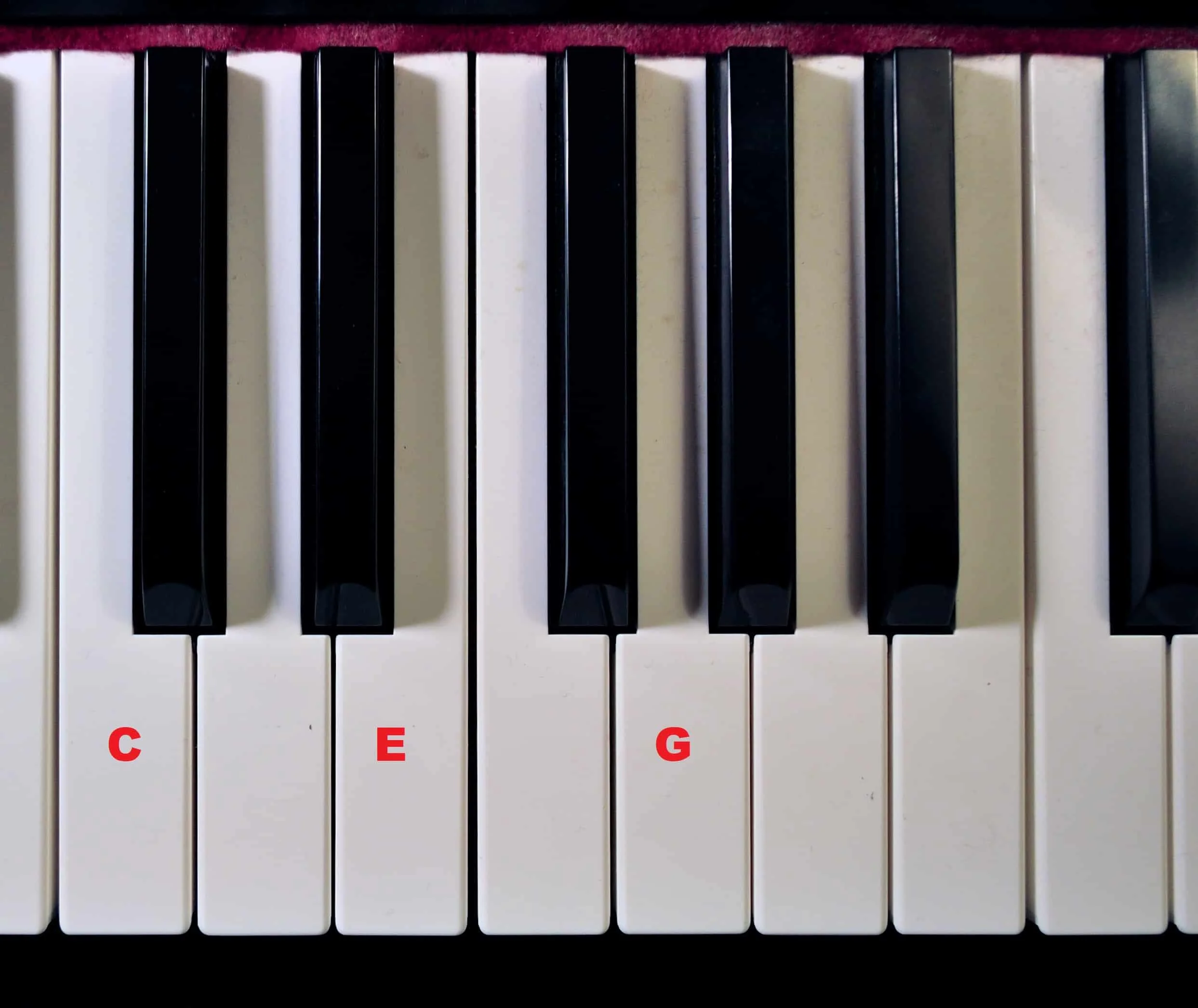
What’s important to note is that some keys share chords. For example, you can play an F major chord in a piece that’s written in C major, because it shares a relationship with C major. However, an F major chord can also be written in the key of F major or B-flat major and still sound correct. You don’t need to worry about this now; this is for more advanced music theory lessons that are beyond the scope of this article.
Major Arpeggios
A brief note on arpeggios; these are kind of a cross between scales and chords. They essentially use the notes of the chord , but are played one after another and not together.
For example, here’s a C major arpeggio:
Notice it goes from the first note of the scale, to the third , then to the fifth , and finally to the first note, but an octave higher. T hen it goes back down again.
You can figure these arpeggios out by yourself by using your knowledge of how scales are put together. A major arpeggio always starts on one note, and then includes the third, fifth and first note on octave higher of that particular scale.
Challenge: try and figure out how to play any of these arpeggios:
Semester 3: Basic note-reading
I am going to go through some basic note-reading concepts in these next two sections. This article won’t teach you how to read music overnight, but it will give you enough information to get started. Unfortunately this is one of those areas where I feel a teacher will really help you, simply because these concepts are hard to understand at first. Persevere, and you’ll get it.
Don’t worry if you don’t understand all of this material for now. It’s a lot to take in, and it’s something that you’ll need a while to fully understand. I remember it took me years to properly learn how to read sheet music (although I was a pretty lazy student sometimes!) If you’re dedicated and you visit the material on a regular basis, it won’t take you anywhere near as long.
Ultimately, in this section we’re going to go over the main, fundamental concepts of learning to read sheet music. These concepts include the staff, treble and bass clef, the note names in both clefs, note values, time signature/rhythm and key signatures. That’s a lot to take in, but there’s very little else to learn about after you have these basic concepts down; anything else is simply an expansion on what you’ve already learned.
Music is made up of lots of different symbols. The most basic symbol you’ll need to learn is called the staff. This is basically the blank canvas; think of it like lines on a piece of paper.
The staff has five lines, and four spaces. Each line and space represents a note. It’s also possible to have notes outside the staff, which are indicated by lines drawn above and below the staff. It’s helpful to think of the staff as more than 5 lines, but since we don’t use the notes below and above the staff very often, we don’t write those lines in very often.
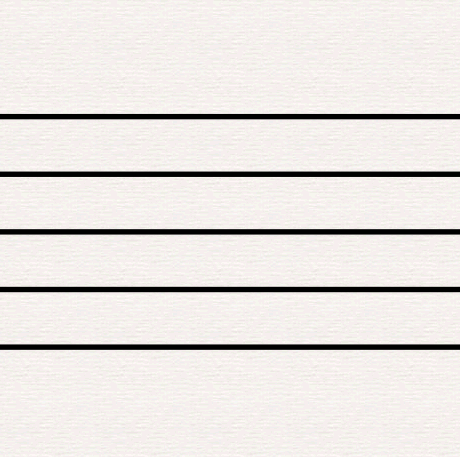
Here’s what I mean about extra notes.
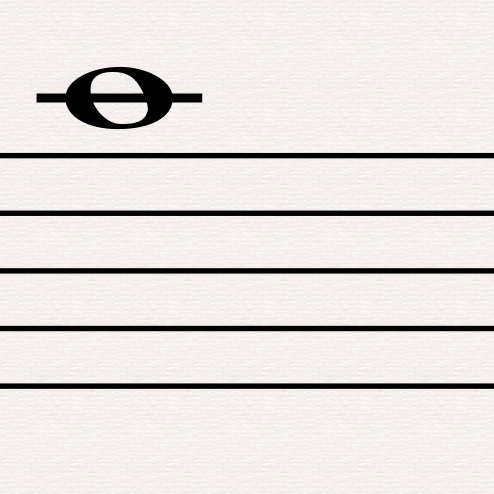
This is an A. It’s above the staff, so we write a line through it to indicate what note it is. All you need to think of here is that the line is just a continuation of the staff.
The Grand Staff
Piano music is usually written with two staffs . This is called the "grand staff."
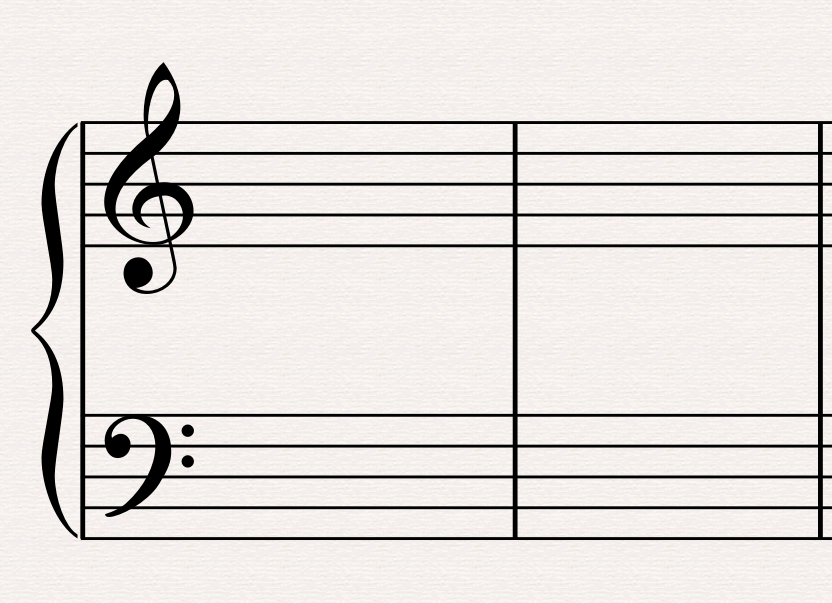
Notice the two signs here:
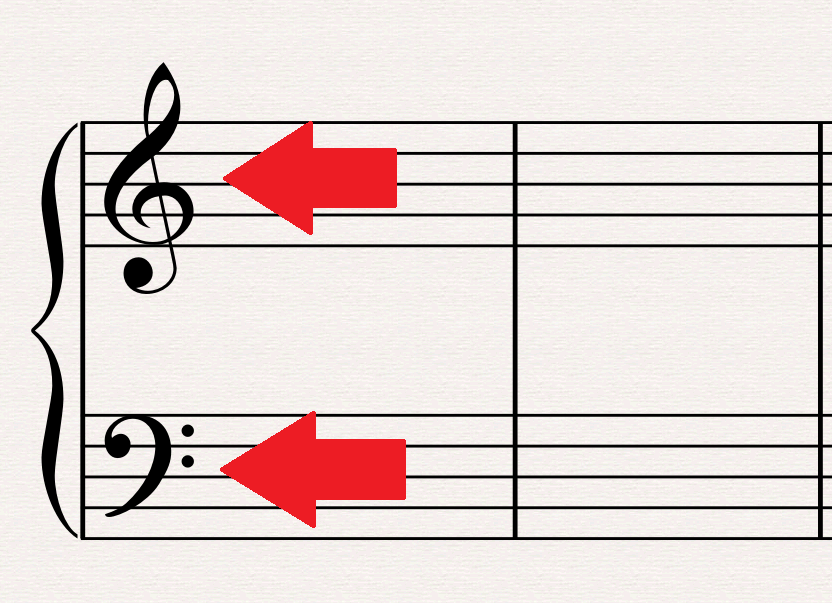
These signs are called clefs. They differentiate the two staffs. The easiest way to think of this is that the treble clef is for the right hand and the bass clef is for the left hand.
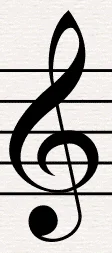
Treble Clef
(right hand)
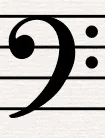
(left hand)
Generally, the staff splits at middle C. Anything lower than middle C will usually be written in the bass clef, and anything above will be written in the treble clef.
Middle C is written here in the treble clef...
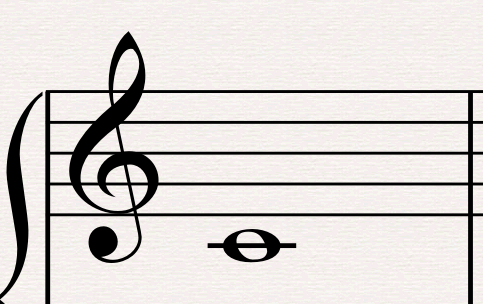
And here in the bass clef.
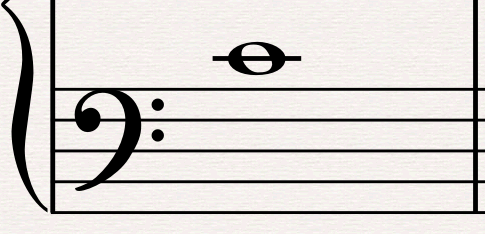
These are both exactly the same note; middle C.
As you've probably guessed, the notes are different for each clef, which is what we’ll go through now.
Notes of the Treble Clef
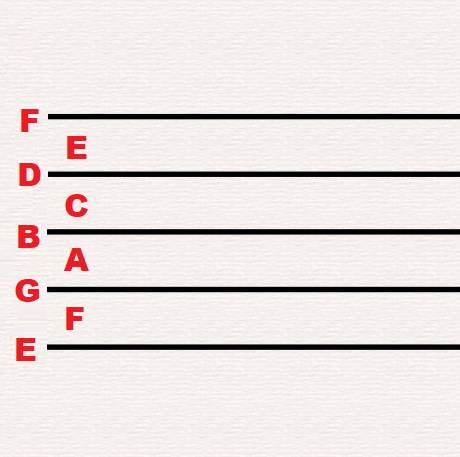
If it helps you remember the note names, you can put together a mnemonic. Here are the two that I used.
For each line on the staff (using the treble clef), the notes are E, G, B, D, F. The mnemonic “Every Good Boy Deserves Football” might help you remember this. There are dozens of variations of this saying; come up with your own if it helps you.
For each space on the staff (using the treble clef), the notes are F, A, C, and E. By far the easiest way to remember this is just to think “FACE”, like the word “face.” The rhyme, “Face in the space” also helped me when I was learning.
Notes of the Bass Clef
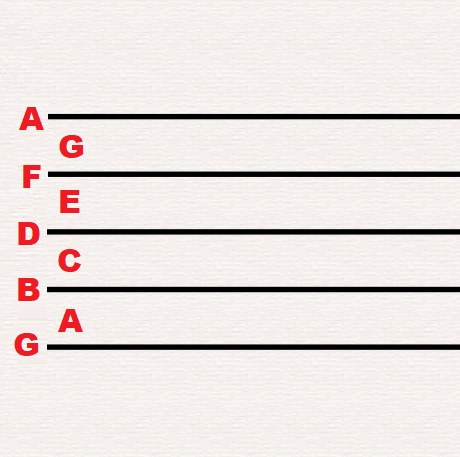
Again, there are two mnemonics you can use to remember this.
For each line on the staff (using bass clef), the notes are G, B, D, F, A. The mnemonic “Good Boys do Fine Always” might help you to remember this. Again, just as with the treble clef, there are dozens of variations and alternatives, and if you can come up with your own, even better.
For the spaces on the staff (using the bass clef), the notes are A, C, E and G. Unfortunately, unlike the treble clef, this doesn’t make up a word, but the mnemonic “All Cows Eat Grass” might help you.
This is really important information, and I’d recommend you print off the following diagram and put it next to your piano when you’re learning. It’ll help you ascertain where the notes of the keyboard are situated on the sheet music.
Notes on the staff tell us two things. They tell us which note to play, and how long to play it for.
Each note has a “head.” Where the head sits on the score determines which note you will play. As discussed before, sometimes note heads can sit outside the staff, with ledger lines drawn through them to indicate which note they represent. Again, just think of this as a continuation of the staff up and down.
Each note also has a “flag” and a “stem.” The stem doesn’t serve any real purpose other than to facilitate the “flag,” if one exists. We’ll go onto this shortly. Stems can point up or down; they make no difference to the music, and simply point either way in order to keep the music looking as tidy as possible.
Note “flags” tell you (in conjunction with the note head, whether it is filled with black or is just an outline) how long to play the note. The more flags you have, the shorter the note. Flags are the “flick” from the bottom of the stem to the right of the note.
Let’s go through each individual note value, and what it means.

Basic Note Values
This is an important diagram, so again, I’d encourage you to print this diagram and keep it with you near your piano so you can refer to it when you’re learning.
There are naming conventions here. It’s important for you to understand that I’m British, and we use a certain naming convention here for note values. I’ve no idea what other countries use, but I know the US and Canada have a different naming convention to us, so I will refer to both here.
The most basic note value is a quarter note, also known as a “crotchet.”
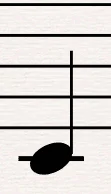
This note always equals one beat.
Now we have the half-note, or the minim.
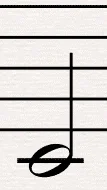
This note always equals two beats.
Finally, we have the whole note, or the “semibreve.”
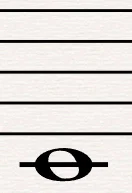
This note equals four beats.
Notice how for the half-note and the whole-note, the note head is white inside with a black outline. For the quarter-note, the note head is fully black. This helps us to differentiate the note value, as these notes don’t yet have flags.
Let’s go on to slightly more advanced notes.
This note is an eighth-note, otherwise known as a “quaver.”
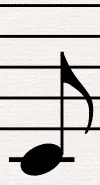
This note is worth half of one beat.
This note is a sixteenth-note, or a “semiquaver.”
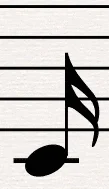
This note is worth a quarter of one beat.
Notice how we now have flags . One flag differentiates a quarter-note from an eighth-note, and two flags make it a sixteenth-note.
There are more notes; thirty-second notes, sixty-fourth notes, etc, but they're beyond the scope of this article. All you'll need to know for now are the five note types we've already gone through.
How these notes fit into one another (subdivisions)
You may have worked this out already, but by the magic of mathematics, we can work out what these note values equal relative to one another.
Let’s take the quarter-note, or the crotchet. This is worth one beat. As a result, it can fit two eighth-notes, or four sixteenth-notes. Both take up the same amount of time. That means for every quarter note, you need to play an eighth-note twice, each individual note being exactly half the value of the quarter-note.
A half-note is worth two quarter notes. You have to play two quarter notes, each exactly half the duration of one half-note, to match the value of one half-note.
Let’s look at the diagram below to show exactly how this works.
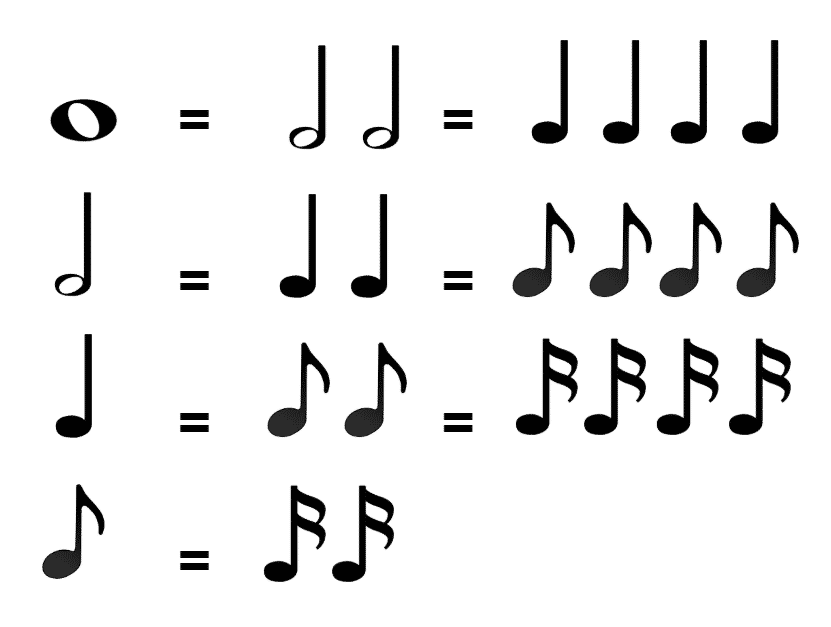
Dotted notes and tied notes
Dots and ties can change the value of a note. Let’s find out how this works.
A dot means that the note is now worth 150% of its original value. To find out exactly how much it’s worth, there’s a very simple trick you can use to work it out.
Let’s take this dotted quarter-note, for example.
We know a quarter-note is worth one beat. To figure out what a dotted quarter note is, let’s half the original number of beats that the note is worth. So, half of one beat is half a beat.
Which note equals half a beat? The eighth-note. So what we now to do work out the value of the dotted quarter-note is add the eighth-note on to a quarter-note.
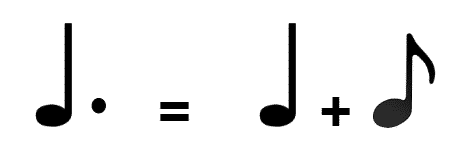
So, a dotted quarter is worth one and a half beats. To figure out a dotted note value, ignore the dot. Half the note value, and add that on to the original note value. That’s the value of your dotted note.
Ties are similar, but easier to understand. A tie indicates that you must hold the note for the value of both notes. A tie can only occur if both notes are the same. So, let’s say you have the following quarter tied to an eighth note.
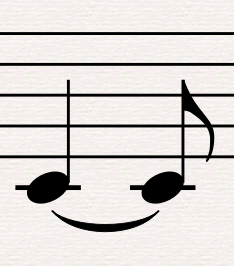
This note needs to be played and held for the duration of the tie. You must add the note values that are tied (in this case, a quarter and an eighth note) and instead of playing a quarter and an eighth, you hold the quarter through the eighth note. You don’t play the eighth. This is commonly used to signify notes that must be held between bars or measures, as in this situation it’s not possible to use a dot. We’ll come on to this later.
Time Signatures
Each piece of music has what’s called a “time signature.” This indicates the pulse of the music.
Each piece of music is split up into bars, or measures. These measures are determined by the lines between notes. Each bar adds up to a certain amount of beats, and the note values in that particular bar won’t exceed this number of beats.
You find this number of beats by looking at the time signature. The time signature is at the beginning of the very first bar, and is indicated by two numbers, one on top of the other.
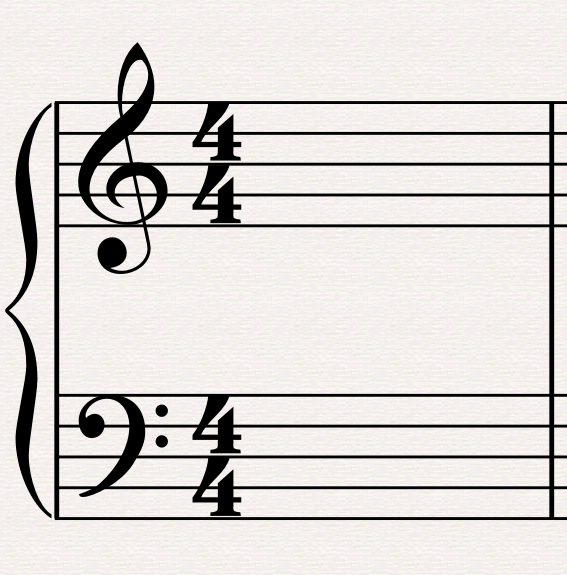
So, let’s take this time signature of 4/4. The top number shows you how many beats are in each bar. So in this particular piece, each bar is worth four beats.
The bottom number shows you what each beat is worth. In this case, it’s 4. This means that each beat is worth a “quarter-note.” So, there are 4 quarter notes in each bar.
If the bottom number was 8, there would be 4 eighth notes in each bar. See how this works?
All this means is that you have the top number of notes, that are worth one of the bottom number each, to play with in that bar. Each bar must have that number of beats in; no more, no less.
So let’s take the 4/4 time signature and see what we can fit in this bar.
We could fit….
One semibreve/whole note.
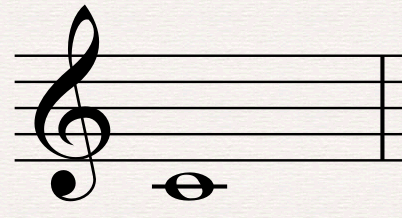
Two minims/half-notes.
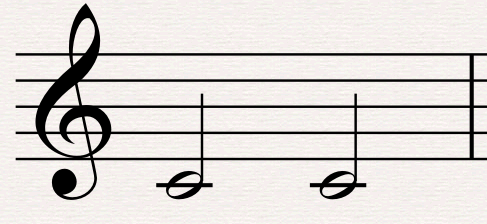
Four crotchets/quarter-notes.
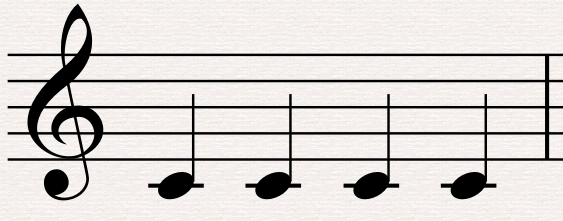
Eight quavers/eighth-notes.

Sixteen semiquavers/sixteenth-notes.

Once you understand how this works, it’s really just simple maths.
However, there is another concept that you need to learn to fully understand this.
If we don’t want a note to be played in a particular section, we use what are called “rests.” Very simple concept; a rest means you don’t need to play anything for the duration of that beat. Rests correspond with the note values, meaning that you have different symbols for whole note rests, half note rests, quarter note rests, and so on. Here’s a diagram to indicate what these rests look like.

All this means is that instead of playing a note, you remain silent for the value of that note. So if you see a sixteenth note rest, you don’t play for the duration of a sixteenth note. It’s that easy!
Key Signatures
The final thing I want to discuss in this section is the concept of key signatures. We’ve spoken before about the concept of keys, but how does this translate to written music?
To do this, we need to understand sharps and flats and how they’re written in music. You’ve already read through my explanation of how sharps and flats work; a sharp raises the note a half-step, and a flat lowers a note a half-step.
Now, key signatures tie closely into our whole-step/half-step scale pattern that we learned in Semester 2. Now, as we know, if you start a scale on a note other than C, you will need to use sharps or flats in order to maintain the pattern. In music, we don’t write sharps and flats for every single note, seeing as this would be time consuming.
What we do instead is use a “key signature.” This groups all the sharps or flats together, and is written next to the time signature at the beginning of the piece. This way, we instantly know what key a piece is in before we even play it.
Let’s go through the key signatures in the treble clef.
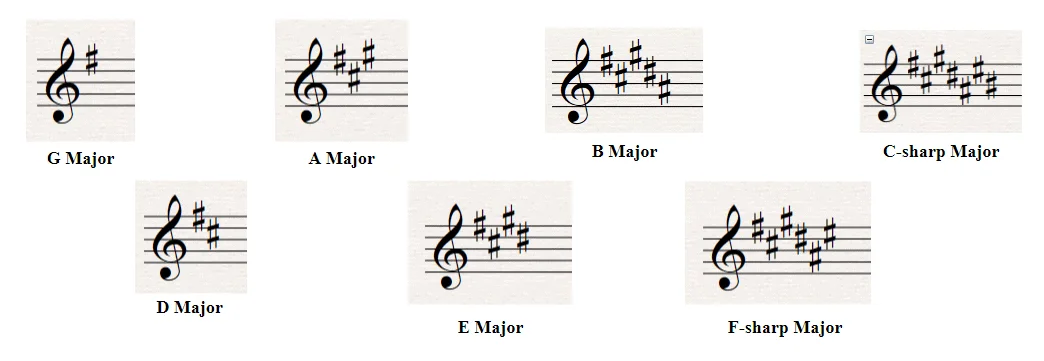
You’ll need to learn these, but as you practice your scales , they will become easier to recognise.
Semester 4: More advanced note-reading; rhythms
This section is much more advanced, but it’s worth covering in this guide. Don’t be concerned if you don’t understand it; this kind of theory knowledge will come in plenty of time.
Reading more than one note at a time (chords)
Now, we’ve gone over simple, individual note values. However, you may have noticed that you have much more than one note on your piano that can be played at any one time. Playing more than one note at a time on the piano is called playing a chord. The way this is notated is very simple.
To notate a chord, you simply stack notes on top of one another. If you ever see this in music, it means all these notes have to be played at the same time.
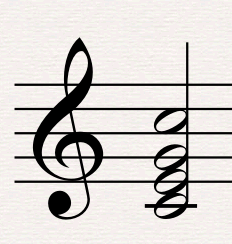
This applies to both staffs, so if you see several notes stacked on top of each other in both staffs, it means that they must be played at once. For example, all these notes are played at the same time, even though they include notes in the treble and bass staff.
More complex rhythmic features
A triplet means three notes grouped together that fit into the space of two notes. You need to look at the individual note value that is grouped by a triplet in order to figure out the duration of the triplet.
For example, let’s look at this eighth-note triplet figuration.
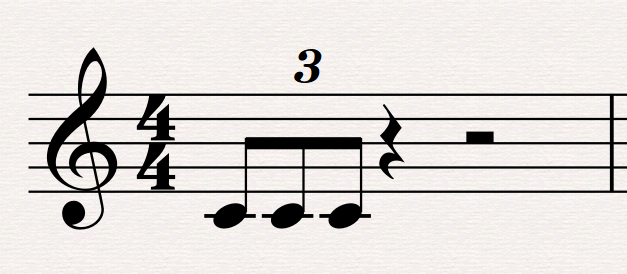
This is easy to work out. You have three eighth-notes, so you need to fit the triplet into the same value as two eighth-notes. All a triplet means is that a rest that is usually divisible by two equal parts is now divided into three equal parts.
Duplets work like triplets, but in reverse. Instead of fitting three notes into the space of two, we are now fitting two notes in the space of three. This works primarily in time signatures that you can equally split into three, such as ¾, 6/8, 12/8, but it can be used anywhere you have music that contains three equal parts that you now only want to split into two equal parts.
For example, take this quarter note duplet.
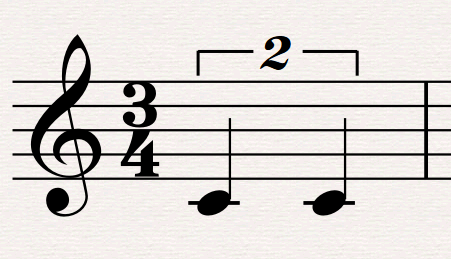
What we’re doing there is extending the value of the quarter note, so that we fit two of them in a space that would usually occupy three. As I explained; exactly like triplets, but opposite.
Quintuplets, Sextuplets, etc
Despite looking more complicated, quintuplets and sextuplets are actually easier to understand. They in essence work exactly the same as triplets.
A quintuplet fits five equal parts into a space that would only usually have two equal parts.

A sextuplet fits six equal parts into a space that would usually only have two equal parts.
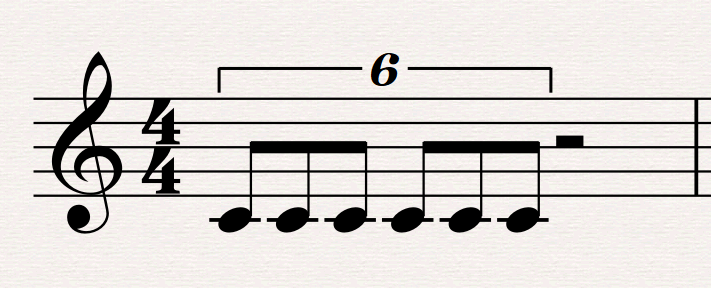
That’s all there is to it!
Keeping the pulse
It’s important to note that trying to fit so many notes into spaces that previously would have been occupied by fewer notes presents some challenges. For example, if you’re presented by a triplet, and you don’t play a proper triplet, you will elongate the bar and make things sound wrong. It’s of vital importance that you practice this material with a metronome , and that you understand how these complex rhythmic patterns relate to other note values in the bar. For example, if you don’t understand that one eighth-note triplet is the same as one quarter-note, or half a half-note, you won’t be able to play these notes in time and your music will sound messy.
If in doubt, consult your teacher.
Semester 5: How to practice on your own
It’s all well and good going to a piano teacher every week to try to get better at playing the piano. However, we all know that the only way we’re going to get good at playing the piano is by practising. Unfortunately, most pianists have no idea how to practice. This applies across the board, from absolute beginners who’ve taken one lesson, to conservatory students at the masters’ level.
Most people come to the conclusion that more = better. Someone who practices for six hours per day must be six times better than someone who practices for only an hour a day. Makes sense, right?
Not so. Six hours’ practice per day will help you if you’re doing it right, but it will massively hinder you if you’re doing it wrong. There’s a whole host of research out there that suggests that the quality and the diligence of your practice is infinitely more important than the amount of practice that you do.
Developing good habits from the outset
This is one of the most crucial things I teach to any new student. It’s pointless starting your piano career off on the wrong foot, because you’ll develop bad habits and you’ll need to go back and correct them at a later date.
For example, one of my pet hates when it comes to hearing other people practicing is that they will practice mistakes. They will play a section that is going well, and all of a sudden they play wrong notes. They’ll then either do one of two things.
- They’ll keep on playing , and wonder why they can never play that section right. (it’s because they practice their mistakes.)
- They’ll stop , and play the notes at the point where they went wrong over and over and over again. Then they’ll go back and play through, and make the same mistake they did at the beginning. Then they’ll just give up and move on.
This isn’t helpful to anyone. The only thing that you need to know in order to fix this is to practice slowly and deliberately . That’s it. This is a bit of a vague term, so what I’m proposing is that when you practice, you play everything slow enough for your mind to keep up with what’s going on. You should be almost telling yourself a story in your head about what’s going to happen next in the piece, and what you need to prepare to do. You’re much less likely to make a mistake if you do this. Most pianists just switch off when playing, and rely on their muscle memory. This just doesn’t work, and you need to be actively engaged in your practice in order for you to improve.
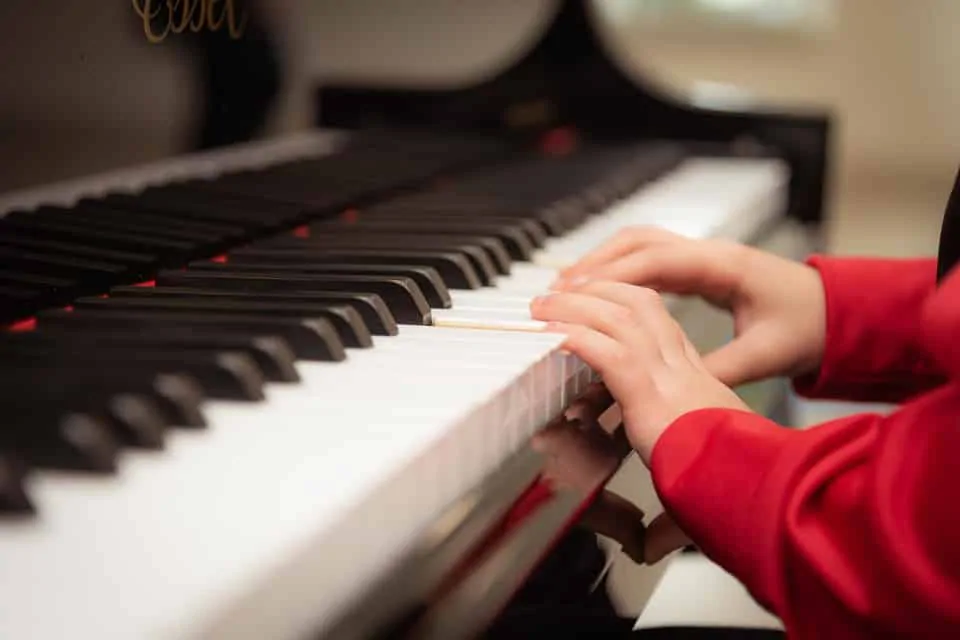
Positive Practice vs Negative Practice
I’ve spoken a little about this, but it’s worth revisiting. I’ve already described how to practice positively. If you’re engaged and switched on about what you’re doing, as long as you do it slowly, you will improve rapidly. For example, when you are practising deliberately, it’s much easier to spot mistakes. When a mistake is identified, a deliberate practiser would stop and play through the section very slowly, identifying where they’re making the mistake, and why they’re making a mistake. Perhaps their hand is slightly in the wrong position, or one of their fingers is not reaching the note it needs to play quick enough.
A negative practiser adopts what I like to call the “spray and pray” method, where they just play through technical problems and ignore them. And unfortunately, when they play the piece for other people or in front of their teacher, they make the same mistakes they’ve always made, and wonder why they can’t play things right.
If you do this often enough you will actually notice your playing getting worse , because you are not giving enough care and attention to your music-making. You will start to notice memory slips, wrong notes, and other problems that you will need to ask your teacher to fix. All of which could have been avoided by taking a slower, more diligent approach to your practice.
How long should you practice for?
As long as you follow my advice above there is no hard and fast rule. Practice as and when you have time. All of us are busy, and unless you’re a music major you probably don’t have several hours a day to devote to the piano. Practice as and when you can, but the amount of practice you do in one session is not necessarily so important.What is important is that you practice properly and deliberately, and that you do it consistently.
For example, if you practice negatively for an hour a day, you will find that if you cut down your practice time to half an hour per day and improve your practice technique, you will improve dramatically. Likewise, you will progress much more quickly if you practice for twenty minutes per day on every day of the week, than if you practice for two hours on a Sunday and don’t touch the piano on any other day.
I’d say a minimum practice you should do is fifteen minutes per day . Any less than that and you’ll struggle to get anything meaningful done. If you want to do more, that’s great. Just be aware that your concentration is going to wane after about forty-five minutes, and you’ll want to take a break. And if you find yourself slipping into any of the negative practice habits I’ve spoken about, you’ll want to stop and revisit the piano another time when you’re a little more fresh.
How many pieces should you practice at a time?
Again, there’s no hard and fast rule here. Usually if you’re working on exams your teacher will assign you three pieces at a time, as well as scales, arpeggios and other technical requirements.
I’d suggest that for an absolute beginner, do not work on more than one piece at a time . It will overwhelm you, and learning to play the piano is difficult enough without having to worry about expanding your repertoire. As you improve, you can take on more responsibility and more pieces, to the point where if you’re ready for exams, you should be able to prepare three pieces at a time to performance standard.
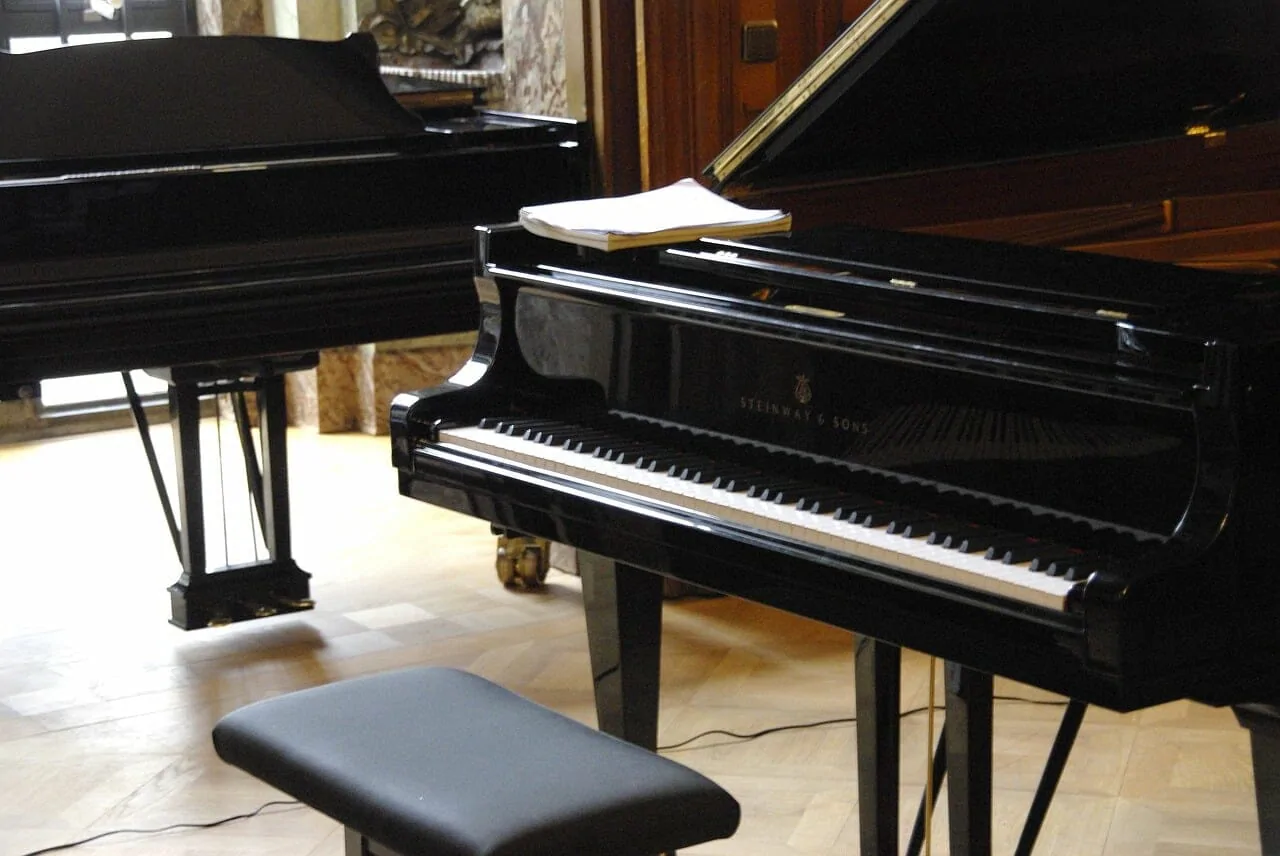
Don’t rely on this, however; if all you have time for is one piece at a time, then that’s fine. Don’t pressure yourself into learning too much repertoire. This is a problem even for the most distinguished of pianists; there’s a limit to how much work we can take on. Don’t spread your concentration and your time too thinly.
Just remember my mantra; more hours and more pieces does not make a better pianist. Better practice makes a better pianist.
If you want to read more about practice, I wrote an article about efficient and effective practice, which I’d encourage you to read: 7 Tips to Improve Piano Practice .
Semester 6: Finding music that you can play
How to assess your own level.
Unfortunately, there’s no set rule for what level you’ve reached at the piano. Depending on what you’re learning at the moment, what you’re teacher teaches you, there’s a distinct possibility that your skills span multiple levels. For example, you might be much more advanced with actually playing pieces than you are with sight-reading.
It’s important to keep some perspective when trying to assess your own level. You’ll find a lot of information on the internet that will try to get you to pinpoint your level. It’s also irritating when trying to buy sheet music, as a lot of manufacturers will apply arbitrary labels to their music, classifying it as for “beginners,” for “intermediate/advanced” level students. This can give you a rough idea of how hard the music will be, but it doesn’t exactly help you determine whether it’s right for you.
The best advice I can give you in this regard is to try to play as much music as you can . This doesn’t mean you need to take on 50 pieces at once (remember what I wrote in the previous section.) However, what it does mean is that you should actively seek out new music to learn and to sight-read. Once you’ve got a few pieces under your belt and you’ve been learning for a while, it becomes easier to judge at sight upon seeing a piece of music whether it’s too hard for you or not. You’ll be able to determine what’s within your limits and what isn’t.
Of course, the time may come when your teacher would like you to try a piece that you feel is way beyond you, or that you come across a piece that you desperately want to play but you feel is too hard. This brings me on to my next point.
Should you play music that’s too difficult?
Many musicians feel siloed into a particular grade level or difficulty level, and won’t budge beyond that until they’ve passed an exam, or been given the go-ahead by their teacher. This is really unfortunate, because a lot of students stop themselves from progressing further and playing music they want to play, simply because it’s labelled as a few grades higher than other music they’ve played.
If something is too hard for you, but you really want to play it, then in my opinion, you should try to play it. Within reason. If you’re a beginner that’s taken three lessons and you want to play one of these pieces , then this is not going to end well, seeing as you will pick up bad habits and get frustrated. However, if something’s just a few levels beyond you, and you feel it will challenge you, you should play it. It’s much better to be playing a piece that’s just a little bit too hard but you have a passion for, than playing a piece that’s at your level but you hate.
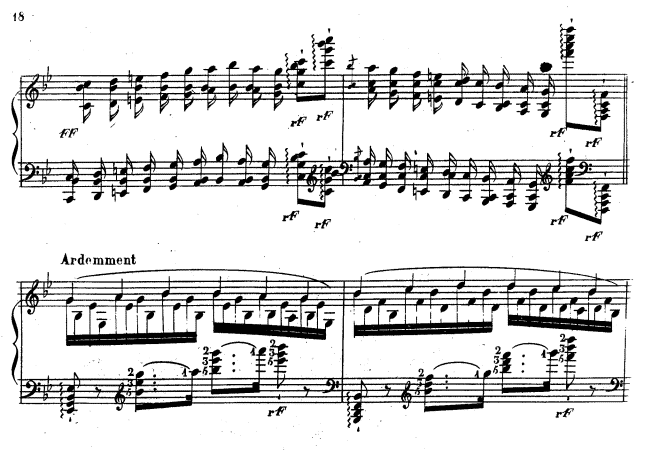
What’s also important to remember is that you won’t learn anything unless you actively seek out and try to play music that’s too difficult for you. If you only try to play pieces that are at your level, you won’t improve. Don’t wait for your teacher to assign you a new piece; get out there and find some new music!
Finding new music
Lots of students don’t know where to go when trying to find new music. I think this problem is partly because so much music exists out there, and it’s difficult to know where to start. Fortunately, it’s now easier than ever for you to find new music on your own. All you need is a computer. Go to YouTube; a recording of pretty much any piece of music will be available there. Find one of the pieces that you’re already playing that you like. Have a look in the video suggestions on the right hand side of the page, and you’ll see similar music by similar composers. Keep browsing through YouTube until you find something you like.
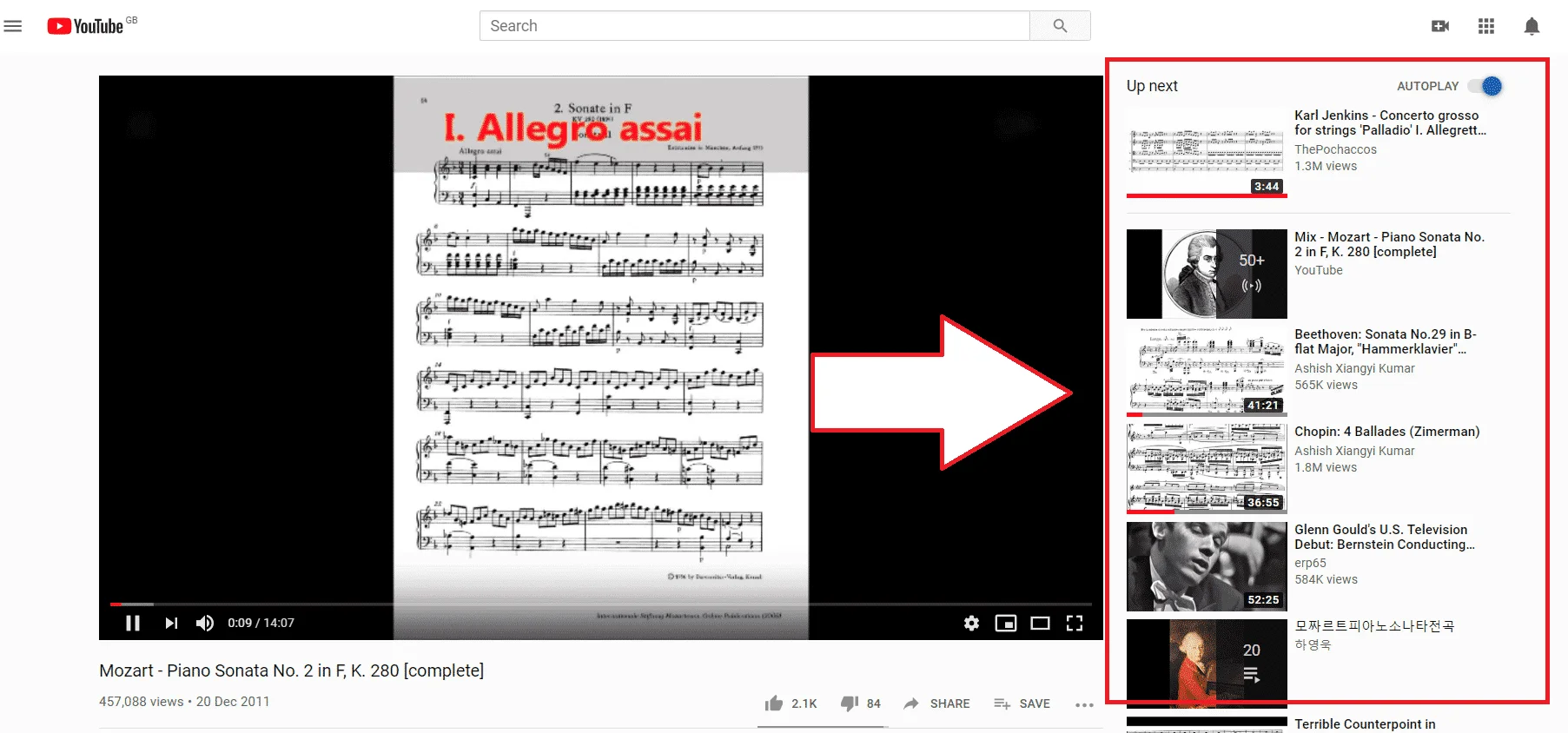
Now, fortunately, there’s also an amazing free resource online where you can find pretty much any piece of classical music ever written. Once you’ve found a piece that you like, go to:
https://www.imslp.org
IMSLP stands for the “International Music Score Library Project.” Think of it as the Wikipedia of sheet music. As long as the music is public domain and isn’t protected by copyright, chances are it’ll be there, and you can download it as a PDF. Then, all you need to do is take your computer or your iPad to your piano, and learn the music! You can even print the PDF off and put it in a file if you so wish.
Now, I still think it’s better to buy the sheet music if you have the option , because you will get a much better experience than using a screen or using sheets of fax paper. However, IMSLP is a brilliant way to get hold of the sheet music for a piece and try it out to see whether it suits you before committing to buying anything.
Unfortunately if the music is not in the public domain and is still protected by copyright, it won’t be available on IMSLP. It may be available elsewhere online, but if it’s protected by copyright it’s illegal to download unless you’ve paid for it. Don’t go looking to pirate sheet music. If you need it and can’t find it available on any of the legitimate free channels, then pay for it.
If you’re really stuck on finding some new music, I’ve given a list of composers below. If you like the music by one, chances are you’ll find something interesting in the music of the others.
Bach : Handel, Scarlatti, Couperin, Rameau, Soler
Mozart : Beethoven, Schubert, Haydn, Mendelssohn, Clementi
Chopin : Liszt, Schumann, Brahms, Saint-Saens, Scriabin, Rachmaninov
Debussy : Ravel, Satie, Poulenc, Stravinsky, Albeniz, Takemitsu
Plug these names into YouTube and go nuts listening to some great music! You’re guaranteed to find something within your grasp that you’ll want to play.
Waiting for your teacher to assign you a new piece
Now, this is a contentious one, and it’s going to annoy some teachers. I really don’t think you should be in a position of relying on your teacher to tell you what to play . Some teachers teach like this; they assign every piece to their student themselves and don’t allow them to play anything else. To me, this is wrong. Of course, there needs to be structure to your learning, and your teacher is the best person to advise as to which pieces will be most beneficial to you.
However, I firmly believe that if you really want to play something, you should just play it . It’s polite to consult with your teacher first, as they will be able to offer you their opinion as a fellow musician who knows you and your playing. However, if you go to your teacher saying that you want to play something, and they outright refuse, to be honest I think you should find a new teacher.
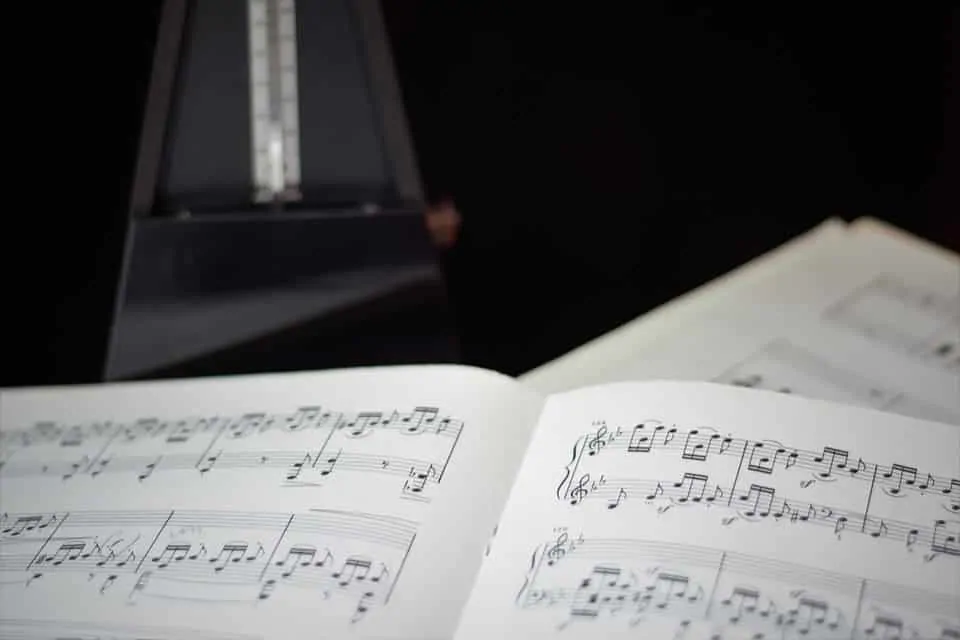
There are exceptions to this; if it’s the week before an exam, for example, I wouldn’t expect any reasonable teacher to drop anything and accommodate your request. So there are limits. However, if your teacher doesn’t reasonably offer an explanation as to why they won’t teach you the pieces you want to play, you ought to look for someone else.
Please don’t fall into the trap of waiting for your teacher to tell you what to learn. A good musician and a good student is always learning, and because of this you should actively and enthusiastically seek out new music that you want to play all the time. There’s some really great music out there that you’ll miss out on if you just rely on your teacher to pick your repertoire for you.
Semester 7: Putting it all together; what can piano-playing do for you?
We’ve spoken a little bit about the benefits of playing the piano. I really believe it’s something that everyone should try, and even if they don’t take formal lessons, it’s something everyone can enjoy. However, where can it take you? What can it do for you?
The main gift that learning to play the piano will give you is a lifetime of music enjoyment. Once you’ve learned to play, it’s a skill that can never be taken away from you. It knows no age; people play from as young as three right until their 100s and beyond. And while your finger dexterity may leave you if you don’t practice for a while, you’ll be surprised at the extent to which it comes back. I took a hiatus from playing for a year or so, and I thought I’d lost a lot of my musical skills. I was shocked that within a few days of practice, it was all there again, in some ways stronger than it ever was. The experience of playing music is priceless, and it’s one of the most valuable gifts you can give yourself.
Of course, if you really love playing the piano, you might even find yourself making a career out of it, but that’s a topic for a whole other article!
In the meantime, thanks for staying with me throughout this whole article and as ever, I hope you learned something.
Happy practicing!
Another name for a sharp or flat. Can refer to either. For example; “that note has an accidental” can mean that the note in question has a sharp or a flat.
Acoustic Piano
Any piano whereby the means of sound generation takes place through a hammer hitting a string and not electronically.
Where the notes of a particular chord are played one after the other as opposed to at the same time. Also referred to as a broken chord.
Refers to the basic unit of time, or the pulse. It’s usually defined as the rhythm that listeners would tap their foot to when listening to a piece of music, or the numbers a musician would count to while performing.
A series of pitches that sound simultaneously.
Serious music following the long-established principles and rules, from around the mid-1600s to the present day. Also refers to a brief period lasting from around 1760 to 1820, where common forms such as the symphony, sonata and concerto were established.
A symbol that is placed on the left-hand side of the staff that indicates the pitches of the following staff.
Conservatoire
A school, usually at the university level, that grants music degrees based on practical performance rather than academic results.
A transferable design. In this article referred to in the context of a manufacturers’ logo on the front of a piano.
Digital Piano
A type of electronic keyboard that generates its sound through sampling or modelling rather than through acoustic means. Designed as an alternative to the acoustic piano.
Dotted Note
Extends the length of a note by half its value, or 150%.
The practice of playing two equal notes in a space that would usually accommodate three equal notes.
Eighth-Note/Quaver
A note that lasts half of one beat.
A medium sized, conical, tenor-voiced brass instrument.
Referring to a piano exam; a structured performance where a student plays pieces deemed to be of a particular level, or grade, and is judged on the quality of their performance.
The art of determining which fingers to place on each note when playing a piece of music.
A symbol that lowers the pitch of the note immediately to the left of the symbol by one half-step.
A piano-learning app for iOS and Windows, designed to help one learn to play pieces.
A particular level that one has reached in piano playing, usually set by an examining body such as the ABRSM or the RCM.
Grand Piano
The largest of all types of piano; a large, full-toned instrument which has the body, strings and soundboard positioned horizontally to the keys and supported usually by three legs.
Grand Staff
Two staffs together, consisting of the bass and treble clef and spanning the whole length of the keyboard.
Half-Note/Minim
A note that lasts two beats.
The smallest interval used on the piano, equivalent to half of a whole step, or 1/12 of an octave.
A wooden lever activated by pressing a key on a piano. When the key is pressed, the hammer is forced towards the string, hits the string and generates a sound.
Harpsichord
A baroque-era keyboard instrument that is similar to the piano, but generates its’ sound by plucking strings instead of having a hammer hit them.
The International Music Score Library Project; a website where any score in the public domain is available for download.
Music of African-American origin that emerged at the beginning of the 1900s, characterised by syncopation, rhythm and improvisation.
Key signature
A set of sharp or flat symbols placed next to the time signature on the staff to tell the performer which key the piece is in.
The most common of the diatonic scales. A major interval is one half-step larger than a minor interval. In its simplest form; referred to as “happy”-sounding music.
Measure/Bar
A segment of time which refers to a specific number of beats.
The second most common of the diatonic scales. A minor interval is one half-step smaller than a major interval. In its most basic form, referred to as “sad”-sounding music.
A pattern of letters that assists in remembering something.
Music major
Someone who has chosen to study music at the university level.
Negative Practice
The act of practising without consciously thinking about and analysing what the player is doing.
A symbol representing a musical sound.
A curly “flick” to the right of a note indicating that it is worth a smaller number of beats.
The part of the note that sits on the staff and tells the player which pitch to play.
The line that goes up or down from the note head. If necessary it contains the flag.
A series of twelve half-steps.
A keyboard instrument whereby the sound is generated by blowing air through pipes.
The three foot-levers on a piano that alter the sound. The right-most pedal extends the sound, the middle pedal does a number of different things and the left-most pedal softens the sound.
Piano technique
Refers to the physical requirements of being able to play a piece.
In its simplest form, a musical work that has been created for others to play. Also incorrectly referred to as a “song.”
Short for “popular” music, a genre of music characterised by tuneful melody and accessibility to the general public. Emerged in 1950s USA and UK.
Evolved from the earlier “rock and roll” style of music popularised in the 1950s. Characterised by the use of electric guitar, drums and bass guitar.
Positive Practice
The act of practicing the piano deliberately and consciously to more effectively identify mistakes and trouble spots. Also referred to as “deliberate” practice.
The act of playing the piano privately in order to improve. Can involve revision of material taught in piano lessons.
Practice Pedal
A lever on an acoustic piano that will drop a piece of felt between the hammers and the strings to reduce the volume level.
Quarter-Note/Crotchet
A note that lasts for one beat.
A musical concept where five notes are played in a space that would normally accommodate only two.
Reading Music
The act of translating written sheet music into audible form.
Adjustment of all the parts in a piano so that they operate evenly and uniformly.
The number of pieces one can play at any given time.
The phenomenon that occurs when strings on a piano resonate at their fundamental or overtone frequencies when other strings are sounded.
A symbol that instructs the player not to play for a given amount of time.
Can refer to several things; the basic pulse of the music (see “beat”), a pattern repeated throughout the music, or a pattern of a small group of notes.
Any set of notes ordered by frequency or pitch.
A symbol that raises the pitch of the note immediately to the left of the symbol by one half-step.
Sight-reading
The art of being able to immediately play a piece of music that one has never seen before.
Simply Piano
App-based piano learning method. Similar to Flowkey.
Sixteenth-Note/Semiquaver
A note that lasts one quarter of one beat.
Teleconferencing tool owned by Microsoft. Can be used for video calls and teaching piano remotely.
A set of five horizontal lines and four spaces that represent different musical pitches.
Long pieces of steel wire that are stretched tightly over the cast iron frame of a piano. When they are struck by a hammer, they vibrate and produce a sound.
Method of learning piano that is characterised by its emphasis on musical absorption and mimicking the sequence of language-learning.
Spray-and-pray
A term used to denote pianists who ignore musical and technical mistakes in their practice, and do not stop to correct them.
The speed at which music is played.
A curved line connecting two notes of the same pitch, indicating they are to be played as a single note.
Time signature
A notation convention used to specify the number of beats in each measure and which note value equals one beat.
The quality of the sound produced by the piano, and whether the overall sound is appropriate for the music being played.
Treble Clef
Also known as the “G” clef, usually indicating that the music is to be played with the right hand. Denotes a higher pitch of music, hence the name “treble.”
Known as the “F” clef, usually indicates that the music is to be played with the left hand. Denotes a lower pitch of music, hence the name “bass.”
A musical device where three equal notes are inserted into a space that would only usually accommodate two equal notes.
A brass instrument including a sliding mechanism that the player uses to control the pitch of the instrument.
The act of changing the tension of the strings inside a piano so that the musical intervals between the strings are in tune.
Upright Piano
An acoustic piano whereby the soundboard and plane of the strings run vertically rather than horizontally to the keyboard.
The act of adjusting the density of the felt covering the piano’s hammers in order to change the brightness or mellowness of the instrument’s tone.
Whole Note/Semibreve
A note that lasts for four beats.
Also referred to as a semitone. Consists of two half-steps; ⅙ of an octave.
Related Posts:
- The Complete Guide to Recording a Piano at Home
- The Pianist’s Guide to Sight Reading
- The Complete Flowkey Review for 2021
- How To Learn Piano Without A Piano
2 thoughts on “The COMPLETE Guide to Learning the Piano”
Excellent article. I am an adult wanna be player that had music lessons as a much younger adult and would like to get into it again. I did have a teacher and was learning on a console organ. I now have a keyboard to get going on again. I might consider a digital piano if I feel I am making some progress. I certainly agree that learning and knowing how to read music is a huge plus. So, here we go again.
Thank you. This is the best lesson, that I have experienced!
Leave a Comment Cancel reply
Save my name and email in this browser for the next time I comment.

How Long to Learn Piano: A Guide to Piano Skills
Learning to play the piano is a beautiful journey filled with moments of joy and accomplishment. But a question that often arises is, “How long does it take to learn piano?” In this comprehensive guide, we will delve into the different stages of piano mastery and help you understand the learning curve involved.
Whether you aspire to reach an expert level or simply want to play your favorite tunes, we will break down the stages and provide insights on what to expect at each level. Additionally, we will explore factors that influence your learning duration, such as practice, attitude, and guidance. So grab your sheet music and let’s embark on this musical adventure together!
How Long does it Take to Learn Piano?
Learning the piano is a highly individualized process, making it difficult to provide an exact timeframe. However, there are general milestones for beginners.
Within 3 to 6 months of regular practice (around 30 minutes to an hour daily), one can typically play simple songs, read basic sheet music, and develop finger dexterity and hand coordination .
After 6 months to a year, learners usually become more comfortable playing with both hands.
Around 1 to 2 years of consistent practice can lead to intermediate-level proficiency, including understanding music theory and expressing better control.
Achieving an advanced level, where one can perform complex pieces or improvise skillfully, may take several more years of dedicated practice, possibly 5 to 10 years or more.
Individual factors like practice habits and previous musical experience can impact the pace of learning. The key is consistent dedication, regular practice, and a passion for the piano.
Understanding the Learning Curve for Piano
Learning to play the piano is a journey that varies for each individual. The amount of time it takes to learn depends on factors such as dedication, practice time, and natural talent. As a beginner pianist, you can expect to spend several months learning basic skills and music theory.
Progression in piano playing is gradual, with more complex techniques and repertoire requiring years of practice. Consistent practice, preferably with a qualified teacher, is key to mastering piano skills. Setting realistic goals and maintaining a positive mindset can help you stay motivated throughout your piano learning journey.
Setting Expectations: What Level Do You Aspire to Reach?
When learning piano, it’s important to set expectations for yourself. Consider the level of proficiency you aspire to reach, whether it’s beginner, intermediate, or advanced. Determine the time and effort you’re willing to invest in practicing and studying. Remember, progress varies for everyone, so be patient with yourself.
Breaking Down the Stages of Piano Mastery
Becoming a master pianist involves several distinct stages.
At the beginner level, one focuses on mastering the basics, understanding piano layout, musical notation, and developing hand-eye coordination. Progressing to the intermediate stage, skills are refined, and a deeper understanding of music theory and sight-reading develops, while also expanding the repertoire.
The advanced stage is characterized by mastering challenging techniques, interpreting music, and polishing the repertoire.
At the concert pianist level, virtuosity and performance skills take center stage, with an emphasis on building a diverse repertoire and gaining collaborative experience.
Finally, at the master pianist level, artistic maturity, innovation, mentorship, and lifelong learning become vital components in the pursuit of excellence. Throughout this journey, consistent practice and dedication remain key factors, making the path to mastery both challenging and rewarding.
The Journey from Beginner to Intermediate
As you embark on your journey from beginner to intermediate, remember that the time it takes to learn the piano varies for everyone.
To progress effectively, dedicate yourself to consistent practice and set achievable goals, starting with building basic techniques, reading sheet music, and strengthening your fingers.
As you advance, explore more complex pieces, delve into improvisation, and deepen your understanding of music theory. Seeking lessons from a qualified instructor can enhance your learning process and guide you in selecting repertoire.
Embrace challenges and stay patient with yourself, as the journey from beginner to intermediate involves starting with the basics, consistent practice, utilizing diverse learning resources, setting specific goals, seeking feedback, applying knowledge in real-life situations, expanding horizons, and staying curious and open-minded.
With dedication, perseverance, and a positive mindset, you’ll make significant strides and find enjoyment in the learning process, ultimately reaching the intermediate level and beyond. Remember, it’s a lifelong journey that rewards effort and time invested.
What Does it Mean to be a Beginner Pianist?
As a beginner pianist, you are just embarking on your exciting journey into the world of piano playing. At this stage, you have limited knowledge of music theory and techniques, but you are eager to learn and improve. Your focus is on mastering hand positions, finger placement, and reading sheet music while gradually building a solid foundation.
It’s crucial to maintain proper posture and hand position during practice to prevent bad habits from forming. Your repertoire consists of basic songs and exercises that allow you to develop your skills at a slow, steady pace.
Regular practice is essential, and you greatly benefit from guided instruction to ensure you’re on the right path.
Embracing challenges with dedication will help you overcome hurdles and grow as a pianist. While the technique is important, you also explore different musical styles and find joy in expressing your creativity through the instrument.
Remember, being a beginner pianist offers ample room for growth and improvement, and the journey ahead is full of exciting opportunities to enhance your musicality and proficiency.
Transitioning to the Intermediate Level: What to Expect
Transitioning from being a beginner to an intermediate piano player is an exciting stage in your musical journey. At this level, you can expect to encounter more complex music pieces that require additional technical skills and musical interpretation.
It’s a great time to start incorporating scales, arpeggios, and other technical exercises into your practice routine to improve finger dexterity and coordination.
As an intermediate pianist, you’ll also focus on developing a more refined sense of touch, dynamics, and expression in your playing. Remember to continue practicing regularly and seek guidance from a qualified piano teacher or online resources to make progress in your piano skills.
Advancing from Intermediate to Expert
Advancing from the intermediate level to becoming an expert pianist is an exciting and fulfilling journey. To reach this level of proficiency, consistent practice is crucial. Set specific goals for yourself and break them down into smaller, achievable milestones. Seeking guidance from a teacher or mentor who has years of experience can greatly enhance your skills.
Additionally, expanding your repertoire by challenging yourself with slightly more difficult pieces will help you grow as a pianist. Developing a solid understanding of music theory and experimenting with different styles will further enrich your musical abilities. Remember, dedication and a positive mindset are key to taking your piano playing to the next level.
Defining the Intermediate Stage in Piano Learning
The intermediate stage in piano learning is an exciting milestone in your musical journey. By this point, you have built a solid foundation of basic skills and can play a wide range of music. Your finger dexterity, hand coordination, and understanding of musical notation are well-developed. As an intermediate pianist, you can tackle more complex rhythms, dynamics, and techniques like scales, arpeggios, and chords.
To progress further, continue practicing regularly and challenge yourself with a more challenging repertoire. Consider working with a qualified piano teacher or attending advanced piano lessons to refine your technique, musicality, and interpretation skills. Remember, the journey to piano expertise is a lifelong dedication to consistent practice.
Factors that Influence Your Piano Learning Duration
When it comes to learning piano, several factors can affect how long it takes to become proficient. Previous musical experience often gives a head start, as familiarity with another instrument can provide a solid foundation. The frequency and duration of your practice sessions also play a significant role in your progress.
Additionally, individuals with a natural aptitude and talent for music tend to grasp piano concepts more quickly. The complexity of the music you choose to learn, the quality of instruction you receive, and your own level of motivation and dedication are other key factors that influence how long it takes to learn piano.
The Role of Practice in Your Piano Learning Journey
The key to learning piano lies in the amount of time you dedicate to practice, which is essential for your piano learning journey. Consistency is crucial, as regular practice, even for shorter periods, yields better results than sporadic longer sessions.
Remember that the quality of your practice matters just as much as the quantity. Focus on technique, accuracy, and musicality during your practice sessions. Practice helps develop crucial skills, builds muscle memory, and expands your repertoire, improving problem-solving abilities along the way.

By establishing a structured practice routine and setting specific goals, you can track your progress and stay motivated on this beautiful musical adventure. Embrace the learning process with discipline and time management skills, as it fosters expressiveness and boosts confidence. Don’t be discouraged by plateaus; consistent practice will help you overcome them.
For those with previous music experience, progress may come faster, but anyone can become a proficient pianist with dedication and enjoyment in witnessing their growth and musical accomplishments.
So stay focused, enjoy the journey, and let the practice be the gateway to mastering the art of piano playing, offering both fulfillment and joy in your musical pursuits.
How Your Attitude Affects Your Learning Speed
Your attitude significantly influences the speed at which you learn. Approaching piano learning with a positive and open-minded mindset fosters faster skill acquisition. Enthusiasm and a growth mindset enable you to be more receptive to new information and embrace challenges with determination. Viewing mistakes as learning opportunities and persisting through difficulties propels your progress.
In contrast, a negative or fixed mindset can hinder your learning journey. Believing that improvement is impossible or that learning is too difficult can lead to discouragement and avoidance of challenges, limiting your potential and slowing down your progress.
To enhance your learning speed and overall experience, cultivate a positive attitude, stay curious, and maintain a willingness to learn from mistakes. Remember, the journey of learning the piano is lifelong, requiring patience and dedication, but with consistent practice and a positive outlook, you’ll elevate your piano playing to new heights.
The Impact of the Right Guidance on Piano Learning
The impact of the right guidance in piano learning cannot be overstated, as it significantly accelerates progress and maximizes one’s potential.
A skilled teacher plays a crucial role in this process, offering effective and personalized instruction that enhances technique, fosters an understanding of music theory, and provides valuable feedback. By keeping learners motivated and accountable, they help them overcome challenges and steer clear of bad habits.
Moreover, exposure to various musical styles broadens horizons, builds confidence, and ensures a fulfilling and successful piano learning journey in the long term. With patience, realistic goals, consistent practice, and the guidance of an experienced teacher, anyone can develop their piano skills and achieve remarkable results.
Adult Piano Learning: Is It Too Late?
It is never too late for adults to learn the piano. While starting young can have advantages, adults bring their own strengths to the process. Motivated and committed, they often have prior musical experience, discipline, and focus, which can positively influence their learning journey.
Moreover, their life experiences enrich their musical understanding and interpretation. By setting clear goals and dedicating time to regular practice, adults can achieve proficiency and find joy in playing the piano at any age.
Though progress may be slower compared to younger learners, with the right mindset and resources, adults can still experience a fulfilling musical journey on their own terms. Whether finding skilled teachers or using online resources tailored for them, consistency and dedication remain the key factors to unlock their musical potential.
Unraveling the Art of Learning Piano by Ear
Learning piano by ear is an exciting and enriching journey that deepens your musical understanding and unleashes your creativity. Unlike traditional methods relying on sheet music, this approach involves closely listening to melodies, chords, and rhythms, then replicating them on the piano. Starting with simple songs, focus on identifying individual notes and chord progressions through repeated listening.
With practice, your ear will become attuned to recognizing patterns and intervals. Utilize tools like music slowdown and part isolation for effective learning. Transcribing music and playing along with recordings further develop this skill.
Patience and perseverance are crucial as you gradually master this art, empowering you to play diverse music, improvise, and infuse each performance with your personal touch. Luckily, various resources like online piano lessons and apps can support your progress throughout this rewarding journey.
Can Practicing Specific Techniques Speed Up Learning?
Practicing specific techniques can undoubtedly accelerate learning across various disciplines. By adopting targeted practice, individuals can focus on areas of weakness and enhance their retention of information. Breaking down complex skills into smaller, manageable chunks and consistently repeating them can lead to substantial improvement.
In addition, incorporating visualization techniques can help learners refine their abilities by mentally rehearsing tasks before executing them. Seeking feedback from mentors or peers is crucial in identifying areas that require improvement and making necessary adjustments. Gradually increasing the difficulty level of tasks also ensures continuous growth.
Furthermore, interleaved practice, where learners switch between different skills or subjects, promotes adaptability and prevents monotony. Meanwhile, spaced repetition, which involves revisiting learned material at specific intervals, facilitates long-term memory retention.
Importance of Regular Practice and Consistency
Regular practice and consistency are crucial for mastering any skill or achieving long-term goals. By engaging in consistent practice, individuals can build and reinforce neural pathways associated with the skill, leading to improved proficiency and muscle memory. This regular repetition enhances long-term memory retention, boosts confidence, and reduces anxiety.
Moreover, it fosters discipline, adaptability, and problem-solving abilities, which are vital for sustained improvement and performance. Consistent practice ensures incremental progress and efficient use of time, ultimately driving learners closer to their long-term objectives.
Are there Quick Tips for Fast Progress?
To make faster progress in learning a new skill like playing the piano, it’s essential to follow focused and consistent practice routines, dedicating time regularly, even if it’s just a few minutes each day. Setting specific and achievable goals helps maintain motivation and provides clear direction for improvement. Embracing challenges is crucial as they offer opportunities to grow and refine your skills.
Seeking feedback from others, especially from a qualified piano teacher or experienced musician, can provide valuable insights and corrections to your technique. Visualization can be a powerful tool to enhance learning; imagine yourself successfully mastering a piece or a challenging section of music.
Leveraging technology and tools such as online tutorials, instructional videos, and learning apps can complement your learning journey and offer additional practice resources. Practicing mindfully, with full focus and concentration, ensures that each practice session is productive and purposeful.
Remember to take occasional breaks to rest and recharge, as this can prevent burnout and aid in retaining information. An effective way to reinforce your knowledge is by teaching others; explaining concepts or playing for someone else can deepen your understanding.
How Much Time Should One Dedicate Daily to Learn Piano?
To learn piano effectively, it is recommended to practice for at least 30 minutes to 1 hour daily. However, the ideal daily practice time varies based on individual goals, commitment level, and current skill level. Beginners are encouraged to start with 15 to 30-minute practice sessions and gradually increase the duration as they make progress.
The key to successful piano learning lies in consistent, regular practice, prioritizing quality over quantity. Paying attention to correct techniques, setting achievable goals, and celebrating milestones are crucial elements in the learning process.
To avoid burnout, it is essential to break practice into smaller sessions throughout the day and listen to your body’s needs. Ultimately, the practice duration should align with personal preferences, ranging from 30 minutes for casual learners to several hours for those who are more dedicated to mastering the instrument.
Remember, progress takes time and patience, and with dedication and perseverance, you can achieve your piano-playing goals.
Learning piano is a unique journey, influenced by dedication, practice, and desired proficiency. It’s not a race but a personal pursuit of passion and expression. Set realistic expectations, master the basics, and progress through stages. Consistent practice, a positive attitude, and guidance from teachers can accelerate progress. It’s never too late for adults to start, and even 15-30 minutes of daily practice can lead to remarkable results.
Whether you’re a beginner or aspiring to reach expertise, remember that learning piano is a rewarding journey that requires patience and perseverance. So embrace each stage, enjoy the process, and celebrate your progress along the way.
Leave a Comment Cancel Reply
Your email address will not be published. Required fields are marked *
Save my name, email, and website in this browser for the next time I comment.

Music is a magic that can change the world. It starts by connecting us.
Chart Your Quest: How to Plan Your Piano Journey

Affiliate Disclosure
Taking up piano is very much like embarking on an epic quest. You have a general idea of where you need to go, but there’s a lot of terrain between here and there that you don’t know about yet.
If you’re not careful, you could end up trapped in a dark forest of no return!
So the secondary title for this post series is: How to Not Get Lost in a Dark Forest of No Return in Your Piano Journey .

This is why epic heroes often have someone to guide them on their journeys, whether it be a scruffy rogue or a wise-old wizard.
How did these reasons help me forge my own path?
So, no, it’s not too late for you to start., what inspired you, determine your values, what should you do this week, final thoughts.
Most piano teachers suggest getting a piano teacher when you first start playing. Makes sense, right? But today, we have Youtube, books, apps, online classes, other teachers, all sorts of guides. How do we pick?

Is one better than the rest?
Every journey is different, so no, if I’m being realistic and genuinely want to help you instead of saying “the only answer is to sign up for lessons with me ,” then I have to say that the best guide for you is up to you.
But don’t worry, this post series will be your guide to finding the perfect guide for you. It will help you create the path for your journey, starting with where you’re going and why .
Through the posts in this series, you’ll learn:
- Your true motivation for taking up and learning piano (which is applicable to any other instrument)
- How to use your values, true motivation, and experience to design a learning path that will set you up for success, so you can achieve your largest, scariest goals
- How to pick a piano or keyboard in your budget if you don’t already have one
- What apps, teachers, books, and courses are out there and how to use them in your specific path (including considering the costs of each)
- What practice is, how to make it an enjoyable experience, and how to keep it effective and efficient
- Overall, how to start your piano journey.
We’ll stick with the epic metaphor (yes that’s a real term that means I’m going to use this metaphor for more than a moment) throughout, and you’ll get tidbits from my journey.
Jump to: Importance of Curiosity • Goals, Part 1 • Goals, Part 2 • Choosing a Piano/Keyboard
Before we actually dive in, I want to answer the question I get asked most:
Is it too late for me to start?
I’m going to answer this one with my personal story of coming to piano.
When I was in 11th grade (like 17 years old I think?), I fell in love with piano. After zero experience as a pianist, I decided I wanted to pursue it for the rest of my life. I worked my a** off, learned Bach’s 2-Part Invention No. 1 in C Major and a Clementi Sonatina (and lots of other stuff), and after only a year of study passed my audition to study Piano Performance at my undergraduate university.
While it is surprising that I was able to do this, I’m not a complete outlier when it comes to taking up piano.
There are specific reasons why I had success in this venture:
- I had a why
- I had a goal
- I was specific
- I was insatiably curious
These four things gave me a path to forge for myself. Once I had a clear path, all I had to do was follow it. This is something that everyone is capable of doing at any age, so it isn’t too late to take up piano. You can be 14, 40, 104, and you can still learn piano.
My specific path looks like this:
Why . Playing piano provided me with a basic human need: connection. I was super lonely in high school (aren’t we all?), and piano made me feel a sense of belonging and deep connection to other people. My why was finding more human connection and sharing that great feeling with everyone.
Goal . My why informed my goal. Broadly, my why told me that I wanted to “get good” and share my why. As a measurable and achievable goal, this translated into “I will study piano for my Bachelor’s.”
Specific. I didn’t want to play all the music in the world. I loved Classical music and most specifically Classical music that made me feel understood. This came out to be basically anything that sounded remotely like Chopin or Debussy. There was a sense of hopeful melancholy that I latched onto in their works.
This specificity gave me one world to explore, knowing that the million other worlds to explore could wait until I was satisfied with this one.
Curious . Why did music, and specifically Chopin and Debussy, make me feel the way it did? Was there more of it somewhere? Could I get more of it?
That insatiable need to understand and to know more still drives me, even after my Master’s in Music Theory! And I don’t think it’ll ever go away. So this one is important.
I first tried to teach myself, but there was too much I didn’t know and didn’t know where to look (online courses weren’t really a thing yet), so I found a teacher who was also one of my friends. Luckily, she and my second teacher (another friend who took over after my first teacher moved away) knew enough to guide me to get into a music program.
My why and curiosity provided me the internal motivation to keep going when times were tough, and I didn’t feel like practicing. It also breathed meaning into my music.
My goals helped me pick what pieces to learn (out of the billions and billions of pieces of music out there). Audition requirements gave me pieces to strive for, and my teachers gave me stepping-stone pieces to get there.
And finally, my specifics turned this whole giant adventure of “learning piano” into single, baby steps. Like I said before, it gave me one world to explore at a time instead of a billion at once. The other worlds could come later.
The reason why so many people “fail” to learn piano as they get older is because they come into it expecting to just do it without following any sort of plan and for it to happen overnight. When they self-teach, they tend to ignore the advice of following a method book or finding a mentor.
Would you have the same attitude if you decided to take up engineering as a hobby?
What’s my motivation?
Before any journey, we have to know where we’re actually going and why. Without a good reason for doing anything, we tend to give up more easily when the going gets tough.
I started playing piano because it made me feel more connected with humanity, both the people immediately around me and humanity as a whole. I felt composers long dead speak to me through my fingers. Their struggles and victories came alive again, giving hope to me and other people alive right now.
It is this profound belief in the ability for music to connect us together and bring us hope that I couldn’t not pursue music.
That’s my story.
Your story and motivation will be different, but you have to figure out what specifically is different.
Even if you feel like you only want piano (or music in general) to be a hobby, there is still a big why behind your desire to try to learn the instrument.
First, think about what even brought you to the piano. Did you hear a performance that knocked you off your feet?
I’ve lost count of the number of live classical recitals I’ve attended that left me breathless and believing in magic. The best part is that the rest of the audience gets the breath knocked out of them too, and we’re all sitting in this beautiful, single moment of stillness that simultaneously stretches to eternity but is also less than a breath in length.
It helps to find recordings of performances that make you feel that way too.
This recording of Ravel’s Le Tombeau de Couperin performed by Angela Hewitt is one of my favorites. Ravel’s music is stunning, sparkly, and inspiring, and Hewitt plays with a delicate but lively touch:
Maybe it wasn’t classical for you though. Maybe you heard someone play something soulful, heartfelt, on a piano in the airport, and it made you pause in your rush to grab coffee before your connecting flight.
Dotan Negrin traveled all around the world with an upright piano and ran into a violinist, Ada Pasternak, in NYC. They spontaneously improvised a duet:
Maybe you experienced the conviction of someone who truly believes in the power of music to change and transform lives. Maybe you can’t put your finger on why it made you feel that way, but you know that’s your experience.
One of the most shared TED talks about Classical music is this one by Dr. Benjamin Zander on the “Transformative Power of Classical Music” in which he uses Chopin’s E Minor Prelude, Op. 28 No. 4 as a way of showing how everyone loves Classical music. They just don’t realize it yet.
Or does someone you know play the piano, and you’re curious what they experience? Or you’d like to know how hard it actually is?
Perhaps you’d like to learn piano because you were told it would make you smarter. Or your parent or someone else important to you told you to play.
Whatever the reason, hold onto that.
Make a playlist of inspiring videos like the ones I shared here. Keep a folder in your computer or on your phone of what you love about piano.
Using your reasons, we can determine your values, which will be your main motivator, your light guiding you from the edge of the dark forest.
Why did that performance stick with you? Do you admire the performer? Why? Are they a “good person”? Do you admire their gentleness or strength? Maybe you got a sense of their work ethic and want to develop your own.

What about the music you like to listen to every day? Why do you think you like it?
What does it make you feel? Does it solve an emotional problem? Does it make you happy or help you focus on work?
I listen to Le Tombeau de Couperin (embedded above) because it gives me hope. Something about the constant movement of the piece reminds me that even the bad times keep moving. We’re not stuck where we are right now. The gentle strength Angela Hewitt performs the piece with emphasizes that we don’t have to force ourselves through life.
We’re allowed to let all this movement wash over us. We can feel the many colors and ideas fly around us. We’re allowed to just be sometimes.

Maybe that’s another reason why I love music so much, especially Ravel’s work. It reminds me that I’m allowed to just be.
The value behind my reason for loving the music is that I believe the world is too hectic, and we should take moments to just be. We should let ourselves stop and smell the roses.
Because of the way the world is, especially in America (capitalism maybe? – I’m not a politician or social scientist), we feel like we’re not allowed to exist if we’re not constantly creating value for the world. But Ravel’s (and many other composers’) work reminds me that we do create value; we are doing a very human thing, when we just let ourselves be sometimes.
When you answer these questions, you’ll have a better understanding of why music is important to you in a way that is unique to you. We all may have similar answers regarding the emotional influence of music, but what drives each of us is unique and is directly related to our values in life.
This week, find some time where you can allow yourself to just listen to music. Make a playlist of your favorite pieces of music of all time.
Don’t be facetious about it either. Include songs by N’SYNC or The Goo Goo Dolls (I love The Goo Goo Dolls, so you’re not alone). It can be a lot of fun to look at yourself through the perspective of the wide array of genres you’re bound to have in this list.
Then think about what about what specific things you connect with in each song. Is there a moment where you always hear a phrase, and say “yes” to yourself, like you understand?
I suggest writing at least bullet points for each song, so you can easily move into the next step of determining your values.

Some of you who are really in tune with your inner selves may already have a good idea of your life values. But no matter where you are in life, this is a helpful exercise to discover and remind ourselves of our values.
Today, we talked about finding our “why.” Next week we’ll move into the next step: curiosity.
As always, if you have any questions, ask in the comments below or email me at [email protected] .
Happy musicking!

How to Read Sheet Music Course

Play Music by Ear Course

How to Build Chords Course

Beginner Music Theory: Your Quick-Start Guide
Hi, I’m Amy!

I’m a 2nd-year PhD studying Music Theory & Cognition.
I love learning about how music plays with our emotions and connects us with each other.
I also love teaching, which is why you’ll find me teaching music theory on social media (@girlinbluemusic).
Music is something I believe everyone should have the chance to learn, so I’m doing everything I can to support affordable music education around the world.
Even if you don’t purchase anything from me, I hope you got at least one big takeaway from this platform: the music you want to make is already in you .
You just need some help getting it out of you!
No matter what you choose to do, I’m here to help you become the best musician you can be!
Share this:
- Click to share on Facebook (Opens in new window)
- Click to share on Twitter (Opens in new window)
- Click to share on Pinterest (Opens in new window)
- Click to share on Tumblr (Opens in new window)
1 thought on “Chart Your Quest: How to Plan Your Piano Journey”
Pingback: How Curiosity Keeps Us Happy and Motivated While Practicing an Instrument – Girl in Blue Music
Leave a Comment Cancel Reply
Your email address will not be published. Required fields are marked *
Notify me of follow-up comments by email.
Notify me of new posts by email.
This site uses Akismet to reduce spam. Learn how your comment data is processed .
Play Music by Ear Cheat Sheet
Learn the individual steps for playing any song by ear. Sign up below!
5 Popular Chord Progressions and How to Use Them
Start making your own music today with chord progressions from your favorite songs
E G♯ m C♯ m A
1 progression, 3 ways.
Musescore, Music xml, Midi, and Pdf file types included.
C♯ m G♯ m B E
1 progression, 8 ways3, a♯dim c♯m f♯ b, a♭ e♭m g♭ d♭, 1 progression, 4 ways, c♯ m bm e a, 1 progression, 8 ways.
LUMI COMPLETE BUNDLE - FREE Snapcase + annual Membership saving

LEARN PIANO, FOR LESS
Discover the lumi complete bundle, there’s a musician in everyone. find yours with lumi., what you'll get:, all in one learning platform.
LUMI is the first piano learning experience of its kind. It combines a glowing keyboard, an app and an ever-expanding library of songs, lessons and games — all in one engaging way to learn. Let lights and colors guide you at every stage of your learning journey.

Piano skills for life
Follow a guided curriculum of LUMI lessons and exercises designed by music education experts to introduce new concepts step by step. Whether you’re a beginner or returning to the piano after a long time away, you’ll pick up all the essentials you need.

Your 24/7 coach
LUMI is your very own piano teacher from home — and more! Track your progress every time you practice through real-time feedback and personal scoreboards. You’ll be amazed how fast you progress day by day.

Songs you love
Whether you prefer Billie Eilish, Beethoven or The Beatles, dive right into learning songs you know and love. There are over 800 tunes to explore in the LUMI app, from famous hits to hidden gems. So you’ll always be motivated to come back for more.

A personalized journey
How you learn with LUMI is up to you. Learn simple songs or take on tricky challenges. Pick your pace and choose your playing view, from shapes to sheet music. LUMI even suggests new music based on your learning profile.

Get more than regular
Piano lessons, for less.
Pick up a LUMI Keys and explore an ever-expanding library of songs, lessons and games with a LUMI Membership subscription, starting from just $8.33 a month. That's less than most piano lessons .
Compared to most piano lessons, there's an almost indescribable joy in the freedom that learning piano with LUMI provides
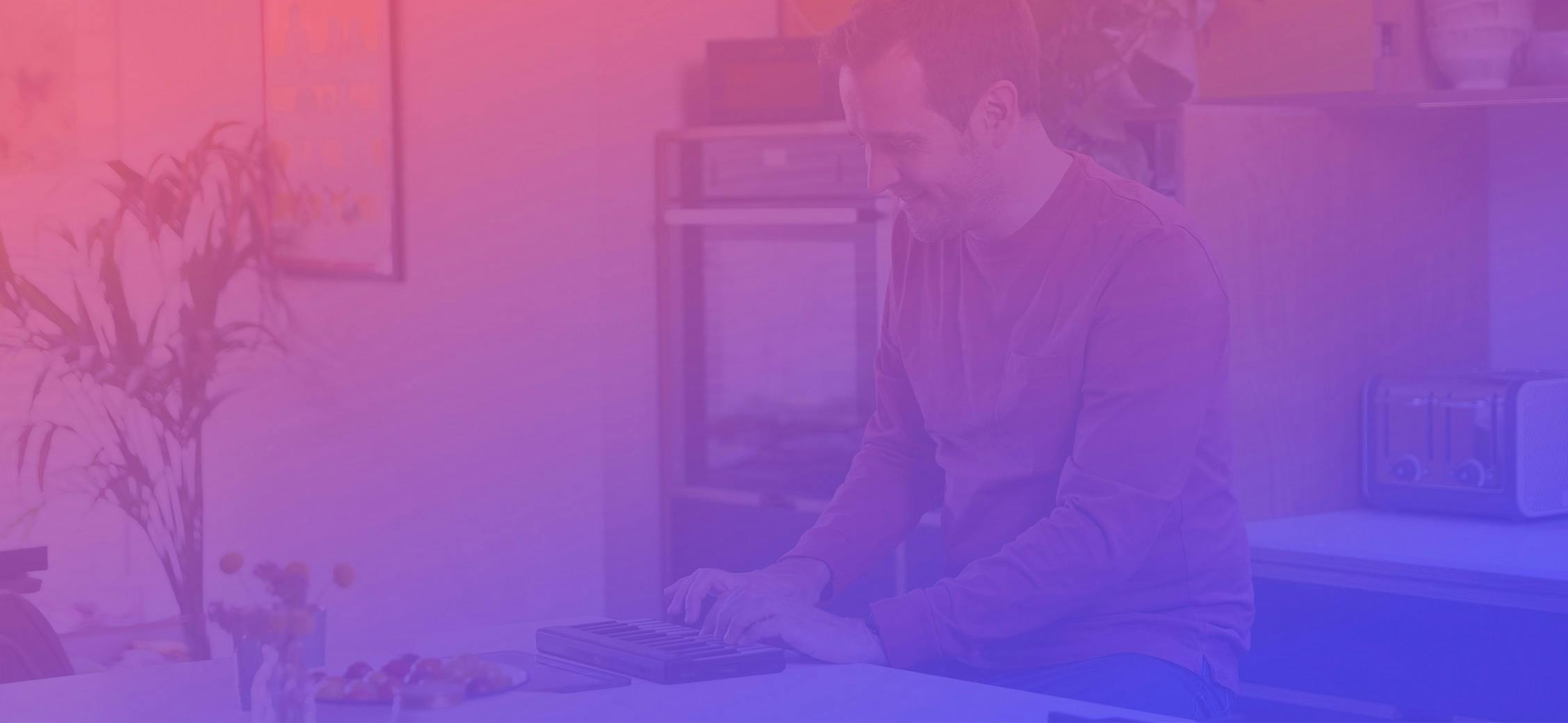
What makes LUMI a better way to learn?
No matter your skill level, playing piano is great for your brain, body and mood. We designed every element of LUMI to make learning more intuitive and fun, every step of the way.

Join a growing band of like-minded learners

Discover the latest LUMI stories:

Learn to play piano chords with new LUMI lessons
30 Day Home Trial
Money Back Guarantee
2 Year Warranty

- Level 1 Beginner
- Level 2 Intermediate
- Level 3 Advanced
- Contemporary
- Fundamentals
- Jazz Ballads
- Smooth Jazz
- Beginner Levels 1-3
- Intermediate Levels 4-6
- Advanced Levels 7-9
- Improvisation
- Practice Tips
Learning Tracks
Take your playing to the next level with PWJ's accelerated study plans for beginner, intermediate and advanced piano players.
Start a Learning Track Today!
If you're brand new to the piano start here. These beginner learning tracks will help you build a solid foundation by learning the essentials.
Intermediate
This is for players with some experience playing piano, who want to fill in the gaps of their knowledge & try new styles of music.
These tracks are for more seasoned players who are ready to take their playing to the next level. All styles and learning focus topics are covered.
Get instant access to guided Learning Tracks and other member features with a PWJ membership!
Guided Learning Tracks
View guided learning tracks for all music styles and skill levels
Progress Tracking
Complete lessons and courses as you track your learning progress
Downloadable Resources
Download Sheet Music and Backing Tracks
Community Forums
Engage with other PWJ members in our member-only community forums
Become a better piano player today. Join with the 14-Day Free Trial today!
Get Started
PianoWithJonny was conceived with the vision of creating high-quality piano lessons that inspire people to learn and share the gift of music.
PWJ Community
- Community Practice Logs
- Member Forums
- Facebook Community
- Member Support
Contact / Support
Visit our support desk to search our knowledge base or contact us for support related inquiries.
- Support Desk
Free Piano Lessons
We publish free piano lessons and tips. Get them delivered to your inbox.
© 2024 Piano With Jonny. All rights reserved. Privacy Policy | Terms of Use
Website built by MemberDev
Q&A Submission 1
Q&a submission 2, workshop request, student assessment, library filtering.
This page allows you to filter by content type, skill level and learning focus.
Piano With Jonny offers three core content types:
Courses are comprised of lessons and are based on selected styles of music and learning focus topics. PWJ offers regular courses, workshops which include teacher interaction, and challenges which are divided into a 4 week learning format.
Lessons are combined into courses. Most lessons build upon concepts of the previous lesson, with the exception of Quick Tips which stand alone.
Smartsheets
Smartsheets use the Soundslice sheet music player to give students digital access to all arrangements and lesson sheet music.
Content Types
Course types, lesson types, sheet types.
Smartsheets use the Soundslice sheet music player to give students digital access to all arrangements and lesson sheet music. Smartsheets provide audio playback, light-up key notation, transposition, looping, and other learning tools.
Lessons sheets break down a song into smaller learning sections. They are all instantly downloadable.
Arrangements are through-composed pieces that are fully notated. They are available for digital viewing and print purchase.
Skill Levels
Beginner: You have never played piano or are just starting your learning journey.
Intermediate: You have some familiarity with the basics of music, and have learned a few pieces.
Advanced: You are more confident with music theory and can play several challenging pieces.
Learning Focus
Select a specific music learning objective to work on.
Skip to Content

Current Students

Interested in more? Search Courses
- Search Input Submit Search
The Twists and Turns of a Lamont Grad’s Musical Journey
Emma atkinson, jazz musician, composer and mentor adam gang has taken an improvised rather than traditional route..

Kids love to quit things. “It’s too hard” and “It’s too boring” are common refrains that echo from the mouths of youngsters who want to spend less time in structured activities and more time with their friends or in front of the TV.
Seventh-grader Adam Gang wanted to quit playing music. He had loved it when he was younger, inspired by his cousin Sam Yahel, a professional jazz pianist. On a piano that Yahel had given him, Gang learned to play Mozart and Chopin, begging his parents for piano lessons.
But in seventh grade, Gang decided that he wanted to play outside more.
“And my parents, they said, ‘Just give it one more week, and then you can quit if you still want to,’” Gang remembers. “And then I didn't quit after that week.”
He stuck with it and committed to becoming a better musician, so much so that he sold his brother’s hand-me-down video game consoles so that he wouldn’t become distracted.
“All I did was practice and focus on music,” Gang says.
After that pivotal moment, music became his life. Gang made all his closest friends through band, even starting a rock group with some friends in middle school. In high school, he joined the marching band and played classical percussion, getting together with friends to play drums for hours on end.
Stepping away from music—and coming back again
After growing up in Atlanta and then moving to Colorado Springs as a kid, Gang got an undergraduate degree from the University of Colorado Boulder in jazz studies in 2013. He then moved to Israel, where his father is from, for most of his 20s.
There, living with family, he left the music world again, this time for a bit longer.
“I went back to school, did most of a computer science degree at the Hebrew University in Jerusalem, and then, towards the end of that degree, I had a change of heart—I decided to drop out of school and go back to music and move back here to be a working musician,” Gang says.
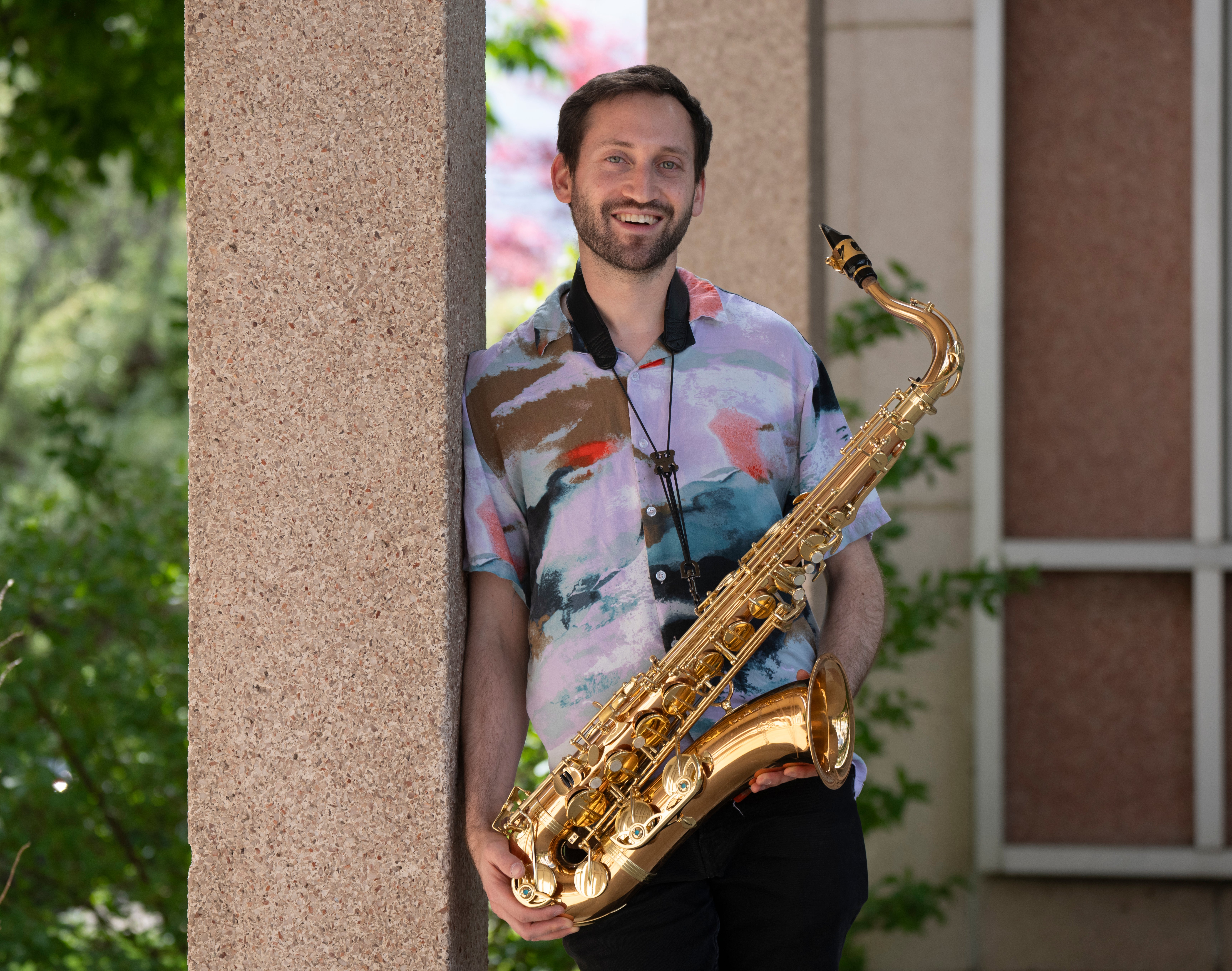
“Here,” he says, is the University of Denver.
Gang’s desire to become a working musician led him to DU’s Lamont School of Music, where many professors also perform professionally in the local music scene.
“I wanted to be able to be a part of the actual professional performing arts scene and also be pursuing a degree,” he says. “And I think DU was a nice combination of the two.”
Gang mainly plays the tenor saxophone—his favorite, he says—but is also proficient in other woodwinds like the clarinet and bass clarinet.
Much of his time at Lamont was spent as professor Remy Le Boeuf’s graduate assistant. Le Boeuf, a Grammy-nominated jazz saxophonist and composer, is an assistant professor and director of Lamont’s Jazz and Commercial Music Studies program.
During his meetings with Le Boeuf, Gang began to brainstorm how he could expand the boundaries of a traditional graduate assistantship and decided that he wanted to work directly with students.
“Since I started here, I've been doing group meetings every week—so students will come and bring their instruments and we'll play together, hands-on, and learn things together,” Gang says. “It could be jazz improvisation, or some sort of technical thing, or playing etudes together—just some sort of musical thing.”
As he was being mentored by Le Boeuf, Gang was mentoring undergrads. And he loved it.
“I remember a time when I was very hungry to learn,” Gang says. “I enjoy it. It feels good to see somebody progress and get closer to the point where they're ready to be fully self-motivated as a musician.”
New beginnings
In his first year at Lamont, Gang released an album of jazz standards, his take on songs that are already in the public jazz repertoire, with some improvisation. But he knew he wanted to do more.
“Last year, I was working with Remy Le Boeuf more on composition, and I was also taking courses with professor Annie Booth, who's a great composer as well,” he says. “And I was just writing a lot of new music, and in August 2023, I got some of my good friends to record the album with me—to play the music. And it came out much better than I would have hoped for.”
Gang’s album, titled “Where Does This Find You,” will drop sometime this summer. It’s an eclectic mix of songs, heavily influenced by Middle Eastern music.
“Where Does This Find You” holds personal significance for Gang, who has lived most of his life in two different countries.
“I find that I always have this feeling of like, ‘Oh, I miss being there. But I'm also happy that I'm here,’” he reflects. “And then those feelings become inseparable, because I think every place you live in leaves an imprint on your character and who you are as a person.”
Adam Gang will graduate this spring with his master’s degree in music performance with an emphasis in jazz studies.
Related Articles

‘An Extraordinary Student, Leader and Changemaker’

Exploring the Intersection of Music and Business on the International Stage
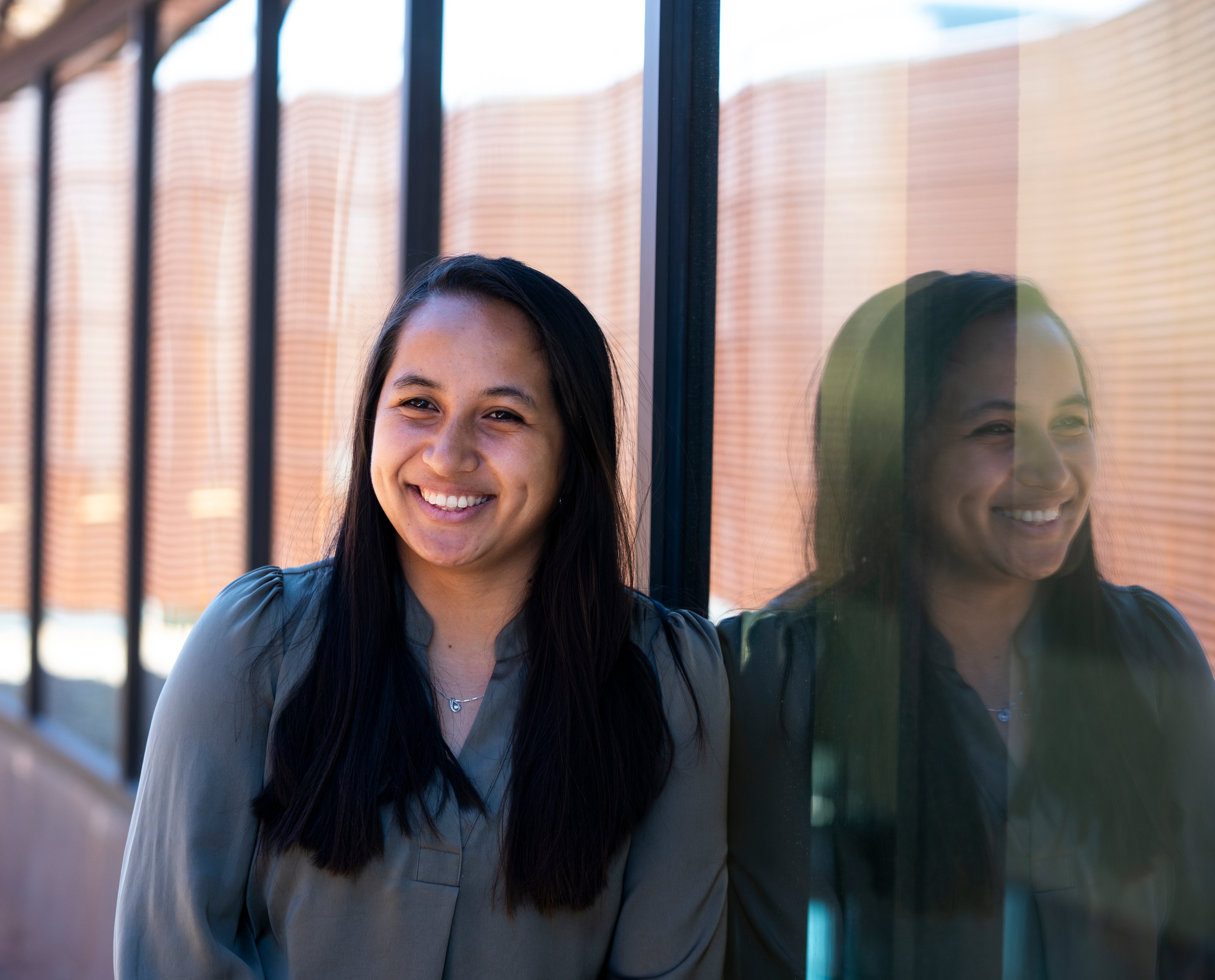
Puzzling the Pieces Together: A Law Student Works Toward an Equitable Future

IMAGES
VIDEO
COMMENTS
Just remember that learning piano is a lifetime journey of toil and persistence in the face of disappointments and setbacks but also an enjoyable one. There'll be too many mistakes that'll drive you to close the piano's lid, burn your practicing papers, and never try again. But if you start practicing the next day again, know you're on ...
So I spent a year learning to play the piano. This video - the result of probably about 350-400 hours of practice - doesn't even come close to some of the on...
For piano students (or a piano teacher in my case!), it's important to recognize that the journey is far from perfect or linear. Just like anything, learning to play the piano comes with its fair share of ups and downs. In this post, I will share some advice regarding the reality of this musical journey, and why embracing its twists and...
The best guide to learning piano. Everything you need to begin your journey - in one simple e-book. The Complete Beginner's Guide breaks learning down into easy to understand steps, so you can follow your dream knowing that you're doing things right. Start Reading. Contents.
Learning the piano is a journey, and it's perfectly normal to encounter challenges along the way. Don't get discouraged. Keep practicing and learning, and you will see continuous improvement. Conclusion. Learning how to play the piano is an enriching experience. It's about dedication, practice, and a love for music.
Before starting your journey on how to play the piano, you need supplies. Below is a list of the essentials, nonessentials, and useful additions to consider, with specific items explained in greater detail. Essentials. A keyboard 1. A piano bench, or chair of a good height 2. Deciding on a learning method or learning approach 3.
Choose a song you love and aim to learn it within a couple of months. Target mastering a new chord or scale every week. Set a timer and aim to practice for 15-30 minutes daily. Remember, it's okay to adjust your goals along the way. The important thing is to keep challenging yourself and enjoying the learning process.
Virtual Piano Coach is the greatest thing that has happened in my teaching and coaching career. Whether you are just starting out fresh from the beginning or have been playing consistently for many years. There will always be new things we can all learn from each other, in our journey of playing piano. Playing the piano is a lifetime experience.
Everything you need to learn piano effectively. Instant access to over 1,800+ HD Video Lessons. Learn Blues, Jazz, Improvisation, and more. Follow our guided Learning Tracks to make rapid progress. Lessons for Beginner, Intermediate, & Advanced. Our effective video layout shows the keyboard, light-up notes, sheet music, and teacher to create an ...
Learn the most important fundamentals for the Key of D Minor with the scales, diatonic chords, and common chord progressions. Then put it all together with an original tune, "Jonny's Moonflight." Piano Learning Track: Early Beginner Piano Foundations - Level 1. This learning track introduces essential keys, chords, and lead sheets for beginners.
Start for free today. Try flowkey now for free, with no obligations. Get set up in just two minutes and start playing your first songs straight away. Start Now. Learn all there is to know about notes, chords, and the proper technique 1500+ songs from beginner to pro level Get started today and play your first song.
This continues all the way up the keyboard. I want you to think of this as a group of 5 black keys. 2 keys + 3 keys = 5 keys. The group always resets after 5 keys, with the first of the group of 2. Find the leftmost key of the group of 2 black keys. Now, the white note immediately to the left of this key is C.
Learning piano is a unique journey, influenced by dedication, practice, and desired proficiency. It's not a race but a personal pursuit of passion and expression. Set realistic expectations, master the basics, and progress through stages.
https://bit.ly/3Uta1qB check here🎹 Unlock the magic of piano playing with Pianoforall - the most intuitive and streamlined piano learning method available! ...
I share my 1 year self taught piano progress starting as a complete beginner. I will also talk about the different ways I used to teach myself the piano as w...
When you become a Piano Roadmap member, you receive all present and future video lessons! My current course works hand-in-hand with the FABER ADULT METHOD BOOK 1. With the Faber book (must purchase separately) and my piano course to guide you, you'll receive the expert advice and resources you need to achieve your musical dreams.
Beginner Foundations Learning Tracks. This learning track introduces essential keys, chords, and lead sheets for beginners. We also apply a variety of styles and rhythms to develop your hand coordination. Continue your piano journey with new keys, chords, scales, and songs. You'll also explore some new progression exercises that will ...
Taking up piano is very much like embarking on an epic quest. You have a general idea of where you need to go, but there's a lot of terrain between here and there that you don't know about yet. If you're not careful, you could end up trapped in a dark forest of no return! But don't worry, these posts will be your guide to finding the perfect guide for you. It will help you create the path for ...
LUMI is the first piano learning experience of its kind. It combines a glowing keyboard, an app and an ever-expanding library of songs, lessons and games — all in one engaging way to learn. Let lights and colors guide you at every stage of your learning journey.
Piano With Jonny offers three core content types: Courses. Courses are comprised of lessons and are based on selected styles of music and learning focus topics. PWJ offers regular courses, workshops which include teacher interaction, and challenges which are divided into a 4 week learning format. Lessons. Lessons are combined into courses.
I truly wish learning the piano could be quantified into chunks of time. As beginners, we feel the need to logically lay out a path with benchmarks, but it doesn't work like that, and youll get a grasp of that soon. The journey is A LOT slower than you think. Your questions/goals totally depend on what genre of music you're interested in.
🎼 Sheet Music: http://bit.ly/2nxS0eQ🎹 Easy Versions: https://www.youtube.com/@TutorialsByHugoEasy🎧 Listen on Spotify: https://open.spotify.com/artist/2wM1...
Kids love to quit things. "It's too hard" and "It's too boring" are common refrains that echo from the mouths of youngsters who want to spend less time in structured activities and more time with their friends or in front of the TV. Seventh-grader Adam Gang wanted to quit playing music. He had loved it when he was younger, inspired by his cousin Sam Yahel, a professional jazz pianist.
Learn how to play Sentimental Journey (Arr. Elaine Conger) - Bud Green, Les Brown, Ben Homer (Instrumental Solo) on the piano. Our lesson is an easy way to see how to play these Sheet music. Join our community.
Easy Piano Tutorial/How to play the song "Faithfully" by "Journey".🎹 MIDI (Patreon): https://www.patreon.com/AtlanticNotes🎹 Direct MIDI Link: https://bit...